
Research Topics & Ideas: Environment
100+ Environmental Science Research Topics & Ideas
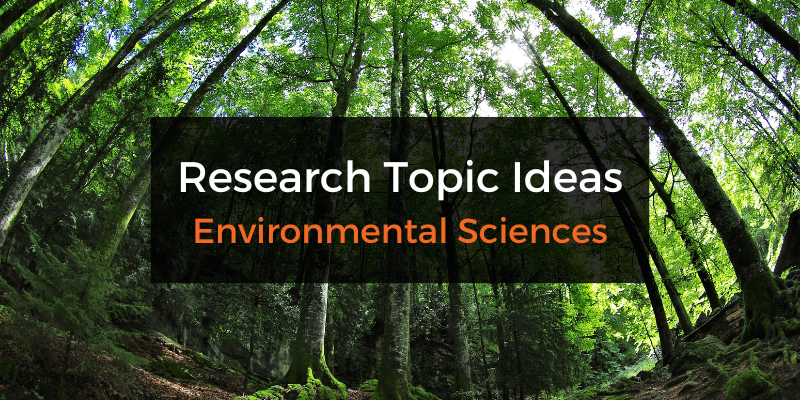
Finding and choosing a strong research topic is the critical first step when it comes to crafting a high-quality dissertation, thesis or research project. Here, we’ll explore a variety research ideas and topic thought-starters related to various environmental science disciplines, including ecology, oceanography, hydrology, geology, soil science, environmental chemistry, environmental economics, and environmental ethics.
NB – This is just the start…
The topic ideation and evaluation process has multiple steps . In this post, we’ll kickstart the process by sharing some research topic ideas within the environmental sciences. This is the starting point though. To develop a well-defined research topic, you’ll need to identify a clear and convincing research gap , along with a well-justified plan of action to fill that gap.
If you’re new to the oftentimes perplexing world of research, or if this is your first time undertaking a formal academic research project, be sure to check out our free dissertation mini-course. Also be sure to also sign up for our free webinar that explores how to develop a high-quality research topic from scratch.
Overview: Environmental Topics
- Ecology /ecological science
- Atmospheric science
- Oceanography
- Soil science
- Environmental chemistry
- Environmental economics
- Environmental ethics
- Examples of dissertations and theses
Topics & Ideas: Ecological Science
- The impact of land-use change on species diversity and ecosystem functioning in agricultural landscapes
- The role of disturbances such as fire and drought in shaping arid ecosystems
- The impact of climate change on the distribution of migratory marine species
- Investigating the role of mutualistic plant-insect relationships in maintaining ecosystem stability
- The effects of invasive plant species on ecosystem structure and function
- The impact of habitat fragmentation caused by road construction on species diversity and population dynamics in the tropics
- The role of ecosystem services in urban areas and their economic value to a developing nation
- The effectiveness of different grassland restoration techniques in degraded ecosystems
- The impact of land-use change through agriculture and urbanisation on soil microbial communities in a temperate environment
- The role of microbial diversity in ecosystem health and nutrient cycling in an African savannah
Topics & Ideas: Atmospheric Science
- The impact of climate change on atmospheric circulation patterns above tropical rainforests
- The role of atmospheric aerosols in cloud formation and precipitation above cities with high pollution levels
- The impact of agricultural land-use change on global atmospheric composition
- Investigating the role of atmospheric convection in severe weather events in the tropics
- The impact of urbanisation on regional and global atmospheric ozone levels
- The impact of sea surface temperature on atmospheric circulation and tropical cyclones
- The impact of solar flares on the Earth’s atmospheric composition
- The impact of climate change on atmospheric turbulence and air transportation safety
- The impact of stratospheric ozone depletion on atmospheric circulation and climate change
- The role of atmospheric rivers in global water supply and sea-ice formation

Topics & Ideas: Oceanography
- The impact of ocean acidification on kelp forests and biogeochemical cycles
- The role of ocean currents in distributing heat and regulating desert rain
- The impact of carbon monoxide pollution on ocean chemistry and biogeochemical cycles
- Investigating the role of ocean mixing in regulating coastal climates
- The impact of sea level rise on the resource availability of low-income coastal communities
- The impact of ocean warming on the distribution and migration patterns of marine mammals
- The impact of ocean deoxygenation on biogeochemical cycles in the arctic
- The role of ocean-atmosphere interactions in regulating rainfall in arid regions
- The impact of ocean eddies on global ocean circulation and plankton distribution
- The role of ocean-ice interactions in regulating the Earth’s climate and sea level

Tops & Ideas: Hydrology
- The impact of agricultural land-use change on water resources and hydrologic cycles in temperate regions
- The impact of agricultural groundwater availability on irrigation practices in the global south
- The impact of rising sea-surface temperatures on global precipitation patterns and water availability
- Investigating the role of wetlands in regulating water resources for riparian forests
- The impact of tropical ranches on river and stream ecosystems and water quality
- The impact of urbanisation on regional and local hydrologic cycles and water resources for agriculture
- The role of snow cover and mountain hydrology in regulating regional agricultural water resources
- The impact of drought on food security in arid and semi-arid regions
- The role of groundwater recharge in sustaining water resources in arid and semi-arid environments
- The impact of sea level rise on coastal hydrology and the quality of water resources

Topics & Ideas: Geology
- The impact of tectonic activity on the East African rift valley
- The role of mineral deposits in shaping ancient human societies
- The impact of sea-level rise on coastal geomorphology and shoreline evolution
- Investigating the role of erosion in shaping the landscape and impacting desertification
- The impact of mining on soil stability and landslide potential
- The impact of volcanic activity on incoming solar radiation and climate
- The role of geothermal energy in decarbonising the energy mix of megacities
- The impact of Earth’s magnetic field on geological processes and solar wind
- The impact of plate tectonics on the evolution of mammals
- The role of the distribution of mineral resources in shaping human societies and economies, with emphasis on sustainability
Topics & Ideas: Soil Science
- The impact of dam building on soil quality and fertility
- The role of soil organic matter in regulating nutrient cycles in agricultural land
- The impact of climate change on soil erosion and soil organic carbon storage in peatlands
- Investigating the role of above-below-ground interactions in nutrient cycling and soil health
- The impact of deforestation on soil degradation and soil fertility
- The role of soil texture and structure in regulating water and nutrient availability in boreal forests
- The impact of sustainable land management practices on soil health and soil organic matter
- The impact of wetland modification on soil structure and function
- The role of soil-atmosphere exchange and carbon sequestration in regulating regional and global climate
- The impact of salinization on soil health and crop productivity in coastal communities
Topics & Ideas: Environmental Chemistry
- The impact of cobalt mining on water quality and the fate of contaminants in the environment
- The role of atmospheric chemistry in shaping air quality and climate change
- The impact of soil chemistry on nutrient availability and plant growth in wheat monoculture
- Investigating the fate and transport of heavy metal contaminants in the environment
- The impact of climate change on biochemical cycling in tropical rainforests
- The impact of various types of land-use change on biochemical cycling
- The role of soil microbes in mediating contaminant degradation in the environment
- The impact of chemical and oil spills on freshwater and soil chemistry
- The role of atmospheric nitrogen deposition in shaping water and soil chemistry
- The impact of over-irrigation on the cycling and fate of persistent organic pollutants in the environment
Topics & Ideas: Environmental Economics
- The impact of climate change on the economies of developing nations
- The role of market-based mechanisms in promoting sustainable use of forest resources
- The impact of environmental regulations on economic growth and competitiveness
- Investigating the economic benefits and costs of ecosystem services for African countries
- The impact of renewable energy policies on regional and global energy markets
- The role of water markets in promoting sustainable water use in southern Africa
- The impact of land-use change in rural areas on regional and global economies
- The impact of environmental disasters on local and national economies
- The role of green technologies and innovation in shaping the zero-carbon transition and the knock-on effects for local economies
- The impact of environmental and natural resource policies on income distribution and poverty of rural communities
Topics & Ideas: Environmental Ethics
- The ethical foundations of environmentalism and the environmental movement regarding renewable energy
- The role of values and ethics in shaping environmental policy and decision-making in the mining industry
- The impact of cultural and religious beliefs on environmental attitudes and behaviours in first world countries
- Investigating the ethics of biodiversity conservation and the protection of endangered species in palm oil plantations
- The ethical implications of sea-level rise for future generations and vulnerable coastal populations
- The role of ethical considerations in shaping sustainable use of natural forest resources
- The impact of environmental justice on marginalized communities and environmental policies in Asia
- The ethical implications of environmental risks and decision-making under uncertainty
- The role of ethics in shaping the transition to a low-carbon, sustainable future for the construction industry
- The impact of environmental values on consumer behaviour and the marketplace: a case study of the ‘bring your own shopping bag’ policy
Examples: Real Dissertation & Thesis Topics
While the ideas we’ve presented above are a decent starting point for finding a research topic, they are fairly generic and non-specific. So, it helps to look at actual dissertations and theses to see how this all comes together.
Below, we’ve included a selection of research projects from various environmental science-related degree programs to help refine your thinking. These are actual dissertations and theses, written as part of Master’s and PhD-level programs, so they can provide some useful insight as to what a research topic looks like in practice.
- The physiology of microorganisms in enhanced biological phosphorous removal (Saunders, 2014)
- The influence of the coastal front on heavy rainfall events along the east coast (Henson, 2019)
- Forage production and diversification for climate-smart tropical and temperate silvopastures (Dibala, 2019)
- Advancing spectral induced polarization for near surface geophysical characterization (Wang, 2021)
- Assessment of Chromophoric Dissolved Organic Matter and Thamnocephalus platyurus as Tools to Monitor Cyanobacterial Bloom Development and Toxicity (Hipsher, 2019)
- Evaluating the Removal of Microcystin Variants with Powdered Activated Carbon (Juang, 2020)
- The effect of hydrological restoration on nutrient concentrations, macroinvertebrate communities, and amphibian populations in Lake Erie coastal wetlands (Berg, 2019)
- Utilizing hydrologic soil grouping to estimate corn nitrogen rate recommendations (Bean, 2019)
- Fungal Function in House Dust and Dust from the International Space Station (Bope, 2021)
- Assessing Vulnerability and the Potential for Ecosystem-based Adaptation (EbA) in Sudan’s Blue Nile Basin (Mohamed, 2022)
- A Microbial Water Quality Analysis of the Recreational Zones in the Los Angeles River of Elysian Valley, CA (Nguyen, 2019)
- Dry Season Water Quality Study on Three Recreational Sites in the San Gabriel Mountains (Vallejo, 2019)
- Wastewater Treatment Plan for Unix Packaging Adjustment of the Potential Hydrogen (PH) Evaluation of Enzymatic Activity After the Addition of Cycle Disgestase Enzyme (Miessi, 2020)
- Laying the Genetic Foundation for the Conservation of Longhorn Fairy Shrimp (Kyle, 2021).
Looking at these titles, you can probably pick up that the research topics here are quite specific and narrowly-focused , compared to the generic ones presented earlier. To create a top-notch research topic, you will need to be precise and target a specific context with specific variables of interest . In other words, you’ll need to identify a clear, well-justified research gap.
Need more help?
If you’re still feeling a bit unsure about how to find a research topic for your environmental science dissertation or research project, be sure to check out our private coaching services below, as well as our Research Topic Kickstarter .
Need a helping hand?
You Might Also Like:

research topics on climate change and environment
I wish to learn things in a more advanced but simple way and with the hopes that I am in the right place.
Thank so much for the research topics. It really helped
the guides were really helpful
Research topics on environmental geology
Thanks for the research topics….I need a research topic on Geography
I want the research on environmental planning and management
I want a topic on environmental sustainability
Submit a Comment Cancel reply
Your email address will not be published. Required fields are marked *
Save my name, email, and website in this browser for the next time I comment.
- Print Friendly

Smithsonian Environmental Research Center
Understanding ecosystems for a sustainable future, search form.
Visitors: The SERC campus is open Monday-Saturday, 8:00am-5:30pm. We're closed Sundays and federal holidays. Please do a health self-check before arriving, and stay home if feeling sick. Read Plan Your Visit for information on where to park, updated maps and hours, safety, and more.
Our trails are closed due to downed debris from a recent storm. For your safety, please do not hike the trails until further notice. We appreciate your patience while we work to clear the debris.
In the event of a government shutdown, SERC will remain OPEN for our normal Monday - Saturday hours through at least Saturday, October 7, by using prior year funds. Visit si.edu for updates.
The Woodlawn History Center is open Friday and Saturday, 10:00am - 2:00pm. Read Plan Your Visit for information on where to park, updated maps, safety, and more.
- Strategic Goals
- Advisory Board
- Corporate Leaders Program
- Director's Letter
- SERC Newsletter
- SERC Newsletter Signup
- Research Topics
- Laboratories
- Publications
- Research Around the Globe
- Coastal Carbon Network
- Ecological Genomics Core
- Technology in Ecology
- Environmental Data
- National Ballast Information Clearinghouse
- On-site School Programs
- On-site Group Programs
- Volunteer in Education
- Professional Development & Science Courses
- Learning Resources
- Virtual Field Trips & Talks
- Job Opportunities
- Visiting Scientists and Research Associates
- Internships and Fellowships
- Plan Your Visit
- Calendar of Events
- Maps and Trails
- Evening Lectures
- Woodlawn History Center
- SERC Fact Sheet
- Find an Expert
- Image Gallery
- News Releases
- SERC In The News
- Smithsonian Statement on Responding to Climate Change
- Science Writing Internships
- Why Do We Call It Participatory Science?
- Volunteer Projects
- Annual Reports
- Sign Up For The Email List
- Shorelines Blog
- SERC YouTube Channel
- Meeting Spaces & Housing
- Environmental Pollution

Cracking Down on Mercury
SERC and University of Maryland scientists found low-cost way to slash the risk from methylmercury hot spots.
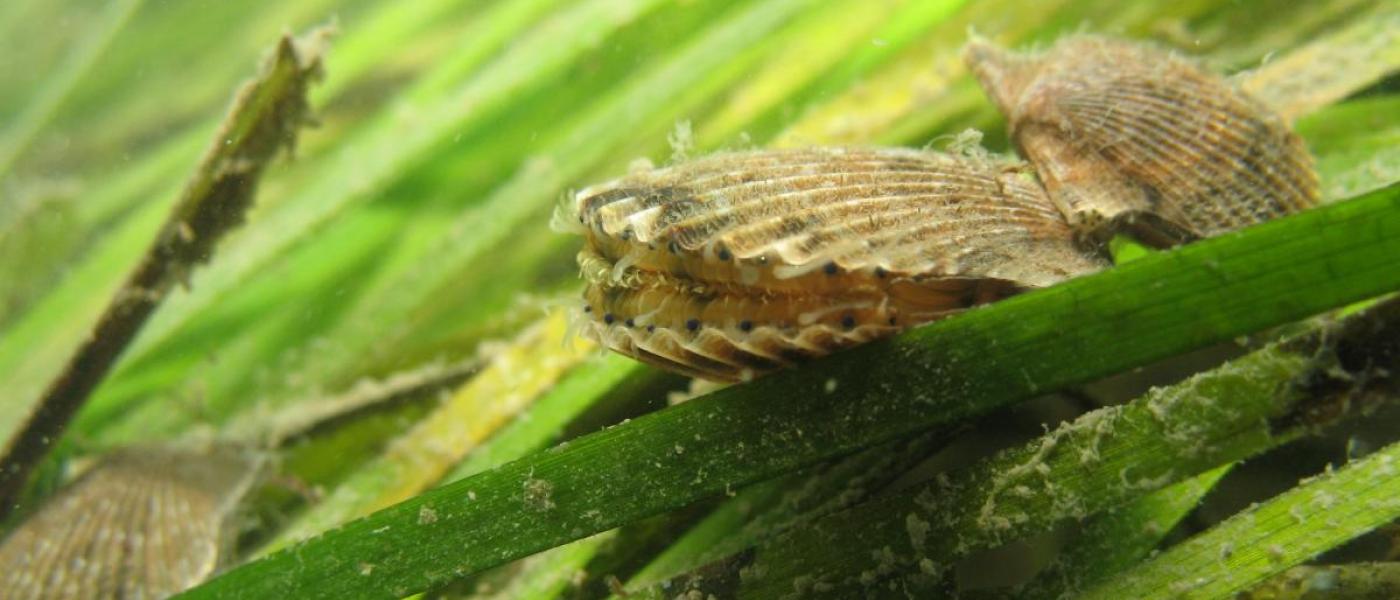
Nutrient Diet Leads to Record-Breaking Seagrass Recovery
Chesapeake Bay has seen the largest underwater grass recovery ever recorded, thanks to a three-decade nutrient pollution diet, a new study finds. (Photo: J. J. Orth/VIMS)
Riparian buffers
When allowed to grow alongside streams, forests and wetlands can act as powerful sponges, filtering out pollution from land before it reaches the water.
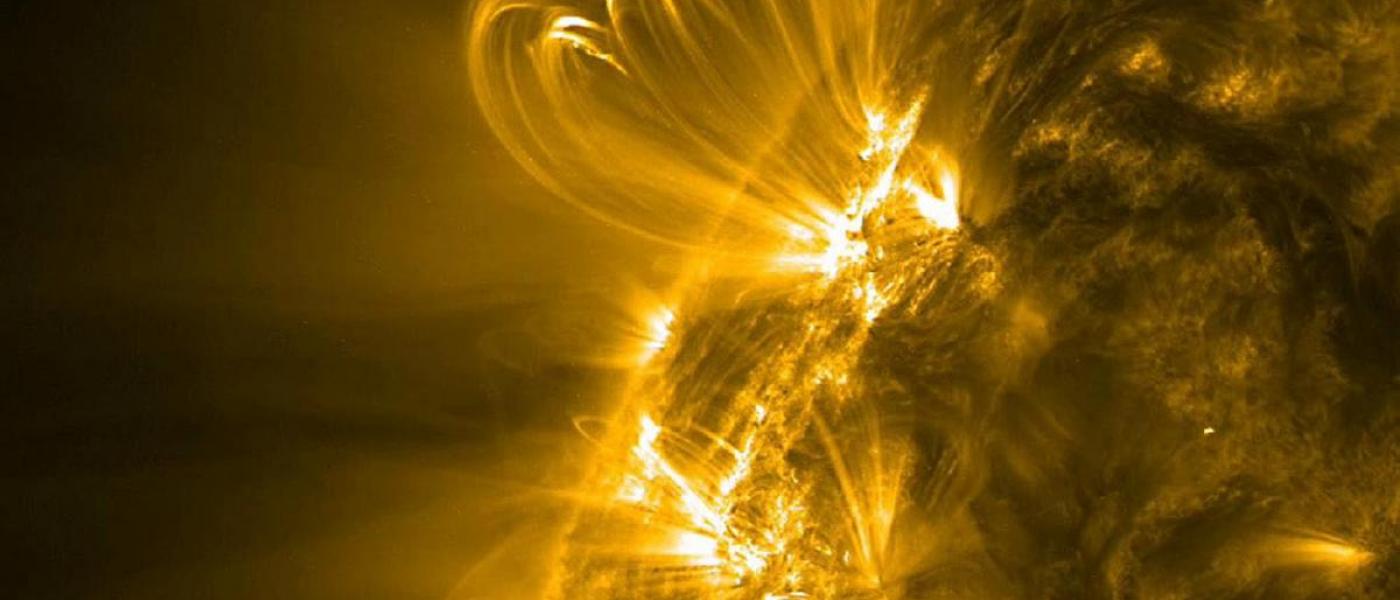
Ultraviolet Light and the Ocean
What could ultraviolet light do to the foundation of the marine food web? SERC scientists went to the South Pole with its springtime "ozone hole" to find out. (Photo: NASA)
Affiliated Labs
- Animal-Plant Interaction
- Ecological Modeling
- Microbial Ecology
- Nutrient Cycles
- Photobiology and Solar Radiation
Pollution has many faces. Some pollutants, like mercury, are dangerous even in small quantities. Others, like nutrient pollution, are harmful in excess when massive amounts of nitrogen and phosphorus stream into the water. And some, like ultraviolet radiation, are ambiguous: the same rays that can cause skin cancer and cataracts also help the body make vitamin D.
SERC researchers trace pollution from its origins in the air, the land, and the water. Nutrient pollution has a myriad of sources: exhaust from cars, fertilizers on farms and lawns, and sewage from cities and suburbs. When it reaches large bodies of water like the Chesapeake Bay, it can feed algal blooms that contribute to low-oxygen dead zones. On the mercury front, SERC microbial ecologists uncover hotspots where microbes transform mercury into methylmercury, a neurotoxin that contaminates our food webs, negatively impacting people and wildlife. And SERC photobiologists have monitored ultraviolet radiation from the forests of Maryland to the waters of the South Pole.
But SERC researchers are also looking for solutions. In the 1980s, they helped discover that riparian buffers (streamside forests and marshes) can act as sponges, soaking up nutrient pollution and keeping it out of the water. Today, SERC scientists have studied and sometimes led stream restorations, seeking to uncover what it takes to make restorations successful and what additional ripples a restoration can have on the environment. SERC’s microbial ecologists helped develop a technique to reduce methylmercury risk from mercury-contaminated sediments and soils. By understanding the nature of environmental problems and their origins, scientists are finding ways to overcome them.
Related Topics
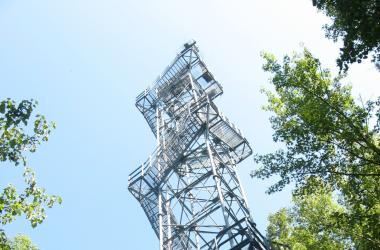
Air Pollution & Solar Radiation
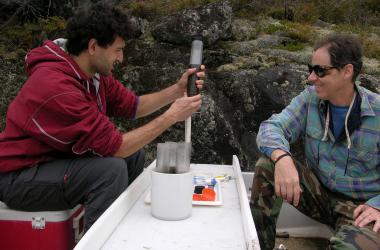
Nutrient Pollution
Thank you for visiting nature.com. You are using a browser version with limited support for CSS. To obtain the best experience, we recommend you use a more up to date browser (or turn off compatibility mode in Internet Explorer). In the meantime, to ensure continued support, we are displaying the site without styles and JavaScript.
- View all journals
- Explore content
- About the journal
- Publish with us
- Sign up for alerts
Collection 12 March 2021
2020 Top 50 Earth, Environmental, and Planetary Sciences Articles
We are pleased to share with you the 50 most downloaded Nature Communications articles* across Earth, environmental, and planetary sciences published in 2020. Featuring authors from around the world, these papers highlight valuable research from an international community.
Browse all Top 50 subject area collections here .
* Data obtained from SN Insights (based on Digital Science's Dimensions) and has been normalised to account for articles published later in the year.

Anthropogenic modification of forests means only 40% of remaining forests have high ecosystem integrity
Mapping and quantifying degree of forest modification is critical to conserve and manage forests. Here the authors propose a new quantitative metric for landscape integrity and apply it to a global forest map, showing that less than half of the world’s forest cover has high integrity, most of which is outside nationally designed protected areas.
- H. S. Grantham
- J. E. M. Watson
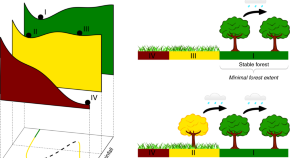
Hysteresis of tropical forests in the 21st century
Tropical rainforests partly create their own climatic conditions by promoting precipitation, therefore rainforest losses may trigger dramatic shifts. Here the authors combine remote sensing, hydrological modelling, and atmospheric moisture tracking simulations to assess forest-rainfall feedbacks in three major tropical rainforest regions on Earth and simulate potential changes under a severe climate change scenario.
- Ingo Fetzer
- Obbe A. Tuinenburg
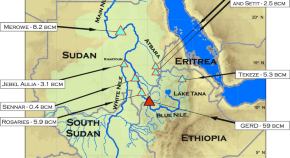
Understanding and managing new risks on the Nile with the Grand Ethiopian Renaissance Dam
Several dams and reservoirs exist along the Nile, most notably the HAD (Egypt) and GERD (Ethiopia) dams. Due to the lack of strategies, the authors here explore potential risks and solutions how to use both dams simultaneously.
- Kevin G. Wheeler
- Marc Jeuland
- Dale Whittington
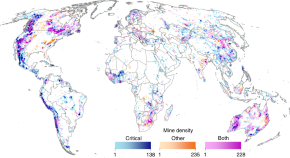
Renewable energy production will exacerbate mining threats to biodiversity
Renewable energy production is necessary to mitigate climate change, however, generating the required technologies and infrastructure will demand huge production increases of many metals. Here, the authors map mining areas and assess spatial coincidence with biodiversity conservation sites, and show that new mining threats to biodiversity may surpass those averted by climate change mitigation.
- Laura J. Sonter
- Marie C. Dade
- Rick K. Valenta
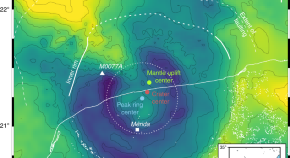
A steeply-inclined trajectory for the Chicxulub impact
The authors here present a 3D model that simulates the formation of the Chicxulub impact crater. Based on asymmetries in the subsurface structure of the Chicxulub crater, the authors diagnose impact angle and direction and suggest a steeply inclined (60° to horizontal) impact from the northeast.
- G. S. Collins
- Third-Party Scientists
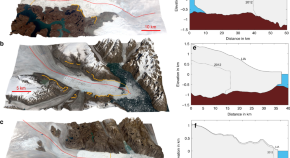
Centennial response of Greenland’s three largest outlet glaciers
The Greenland Ice Sheet is the largest land ice contributor to sea level rise and understanding the long-term glacier response to external forcing is key to improved projections. Here the authors show Greenland’s three largest outlet glaciers will likely exceed current worst-case scenario
- Shfaqat A. Khan
- Anders A. Bjørk
- Toni Schenk

The economic costs of planting, preserving, and managing the world’s forests to mitigate climate change
Forests are critical for stabilizing our climate, but costs of mitigation remain uncertain. Here the authors show the global forest sector could reduce emissions by 6.0 GtCO 2 yr −1 in 2055, or roughly 10% of the mitigation needed to limit warming to 1.5 °C by mid-century, at a cost of 393 billion USD yr −1 , or $281/tCO 2 .
- K. G. Austin
- J. S. Baker
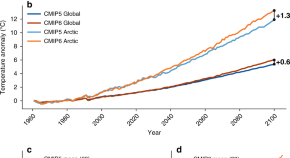
Greater Greenland Ice Sheet contribution to global sea level rise in CMIP6
The potential contribution of Greenland Ice Sheet to sea level rise in the future is known to be substantial. Here, the authors undertake new modelling showing that the Greenland Ice Sheet sea level rise contribution is 7.9 cm more using the CMIP6 SSP585 scenario compared to CMIP5 using multiple RCP8.5 simulations.
- Stefan Hofer
- Charlotte Lang
- Xavier Fettweis
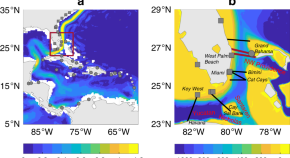
Likely weakening of the Florida Current during the past century revealed by sea-level observations
Understanding trends in ocean circulation and dynamics is hampered by a lack of long-term records. Here the author uses probabilistic reanalysis of available data to show that transport by the Florida Current has declined over the past 110 years, indicating a slowdown of Atlantic Ocean circulation.
- Christopher G. Piecuch
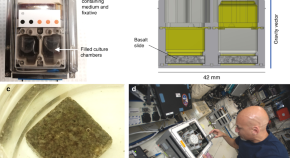
Space station biomining experiment demonstrates rare earth element extraction in microgravity and Mars gravity
Rare earth elements are used in electronics, but increase in demand could lead to low supply. Here the authors conduct experiments on the International Space Station and show microbes can extract rare elements from rocks at low gravity, a finding that could extend mining potential to other planets.
- Charles S. Cockell
- Rosa Santomartino
- René Demets
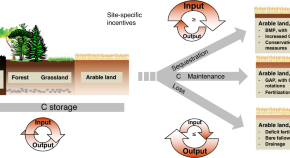
Towards a global-scale soil climate mitigation strategy
Reducing soil degradation and improving soil management could make an important contribute to climate change mitigation. Here the authors discuss opportunities and challenges towards implementing a global climate mitigation strategy focused on carbon sequestration in agricultural soils, and propose a framework for guiding region- and soil-specific management options.
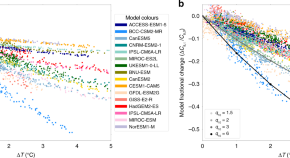
A spatial emergent constraint on the sensitivity of soil carbon turnover to global warming
The fate of the carbon locked away in soil is uncertain, and there are vast differences between models. Here the authors apply observational, spatio-temporal constraints on carbon turnover projections and find that uncertainty in estimations of carbon dynamics are reduced by 50%.
- Rebecca M. Varney
- Sarah E. Chadburn
- Peter M. Cox
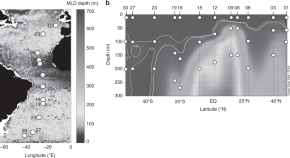
High concentrations of plastic hidden beneath the surface of the Atlantic Ocean
The risks posed by plastic contamination of the ocean cannot be assessed as their amount and location remain largely unknown. Here the authors show that large quantities of microplastics exist below the ocean surface over the entire Atlantic in quantities greater than previously estimated.
- Katsiaryna Pabortsava
- Richard S. Lampitt
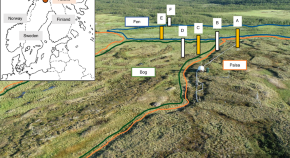
Iron mineral dissolution releases iron and associated organic carbon during permafrost thaw
Iron minerals trap carbon in permafrost, preventing microbial degradation and release to the atmosphere as CO 2 , but the stability of this carbon as permafrost thaws is unclear. Here the authors use nanoscale analyses to show that thaw conditions stimulate Fe-reducing bacteria that trigger carbon release.
- Monique S. Patzner
- Carsten W. Mueller
- Casey Bryce
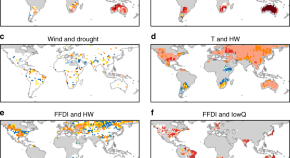
Global hotspots for the occurrence of compound events
Compound climate events such as floods and droughts together can cause severe socio-economic impacts. Here, the authors analyse global hazard pairs from 1980–2014 and find global hotspots for the occurrence of compound events.
- Nina N. Ridder
- Andy J. Pitman
- Jakob Zscheischler
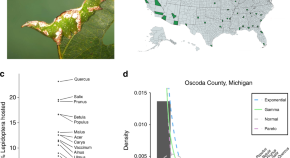
Few keystone plant genera support the majority of Lepidoptera species
Not all plants are equally able to support native insects. Here, the authors use data on interactions among >12,000 Lepidoptera species and >2000 plant genera across the United States, showing that few plant genera host the majority of Lepidoptera species; this information is used to suggest priorities for plant restoration.
- Desiree L. Narango
- Douglas W. Tallamy
- Kimberley J. Shropshire
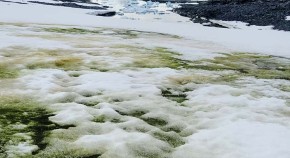
Remote sensing reveals Antarctic green snow algae as important terrestrial carbon sink
Snow algae bloom along the coast of Antarctica and are likely to be biogeochemically important. Here, the authors produced the first map of such blooms, show that they are driven by warmer temperatures and proximity to birds and mammals, and are likely to increase given projected climate changes.
- Andrew Gray
- Monika Krolikowski
- Matthew P. Davey
Farming fish in the sea will not nourish the world
Marine aquaculture is widely proposed as compatible with ocean sustainability, biodiversity conservation, and human nutrition goals. In this Perspective, Belton and colleagues dispute the empirical validity of such claims and contend that the potential of marine aquaculture has been much exaggerated.
- David C. Little
- Shakuntala H. Thilsted

Migrant birds and mammals live faster than residents
Migration is costly. In the first global analysis of migratory vertebrates, authors report that migratory birds and mammals have faster paces of life than their non-migratory relatives, and that among swimming and walking species, migrants tend to be larger, while among flying species, migrants are smaller.
- Andrea Soriano-Redondo
- Jorge S. Gutiérrez
- Stuart Bearhop
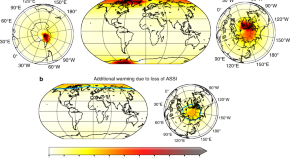
Global warming due to loss of large ice masses and Arctic summer sea ice
The disintegration of cryosphere elements such as the Arctic summer sea ice, mountain glaciers, Greenland and West Antarctica is associated with temperature and radiative feedbacks. In this work, the authors quantify these feedbacks and find an additional global warming of 0.43°C.
- Nico Wunderling
- Matteo Willeit
- Ricarda Winkelmann

Asteroid shower on the Earth-Moon system immediately before the Cryogenian period revealed by KAGUYA
Ancient impact events on Earth are not well characterized due to continuous re-surfacing of Earth. Here, the authors study impact craters on the Moon with ages up to 800 million years ago and present a cross correlation to Earth, linking up to mass extinction events throughout Earth’s history.
- Kentaro Terada
- Tomokatsu Morota
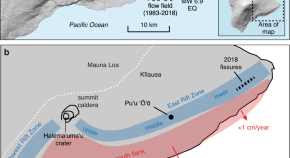
The cascading origin of the 2018 Kīlauea eruption and implications for future forecasting
- M. R. Patrick
- B. F. Houghton
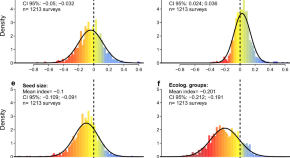
The erosion of biodiversity and biomass in the Atlantic Forest biodiversity hotspot
Quantifying forest degradation and biodiversity losses is necessary to inform conservation and restoration policies. Here the authors analyze a large dataset for the Atlantic Forest in South America to quantify losses in forest biomass and tree species richness, functional traits, and conservation value.
- Renato A. F. de Lima
- Alexandre A. Oliveira
- Paulo I. Prado
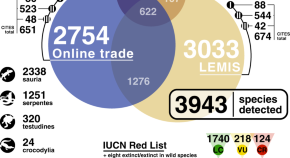
Thousands of reptile species threatened by under-regulated global trade
There are gaps in international efforts to monitor the wildlife trade, with many species potentially being undetected by the established monitoring groups. Here the authors use an automated web search to document the sale of reptiles online, revealing over 36% of all known reptile species are in trade, including many missing from official databases.
- Benjamin M. Marshall
- Colin Strine
- Alice C. Hughes

Organo–organic and organo–mineral interfaces in soil at the nanometer scale
Historically it has been maintained that soil organic carbon (SOC) is stabilized through interactions with mineral interfaces. Here the authors use cryo-electron microscopy and spectroscopy to show that SOC interactions can also occur between organic forms in patchy, disordered structure.
- Angela R. Possinger
- Michael J. Zachman
- Johannes Lehmann
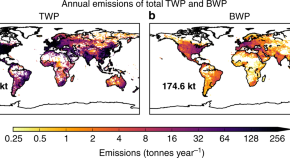
Atmospheric transport is a major pathway of microplastics to remote regions
Plastic pollution is a critical concern across diverse ecosystems, yet most research has focused on terrestrial and aquatic transport, neglecting other mechanisms. Here the authors show that atmospheric transport is a major pathway for road plastic pollution over remote regions.
- N. Evangeliou
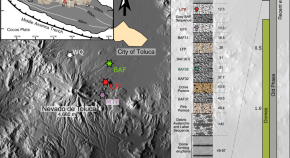
Determining the current size and state of subvolcanic magma reservoirs
This study makes use of the total spread of zircon ages and trace elements to study the thermal evolution of magmatic systems. Applied to Nevado de Toluca, the authors determine the size of its subvolcanic magma reservoir and assess its potential of re-activation.
- Gregor Weber
- Luca Caricchi
- Axel K. Schmitt
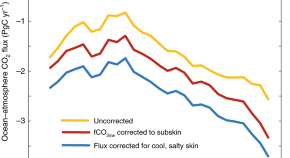
Revised estimates of ocean-atmosphere CO 2 flux are consistent with ocean carbon inventory
Ocean uptake of carbon dioxide impacts the climate, but flux estimates from surface measurements have not been corrected for temperature differences between surface and water sampling depth. Making that correction, the authors find previous estimates for ocean uptake have been substantially underestimated.
- Andrew J. Watson
- Ute Schuster
- Lonneke Goddijn-Murphy
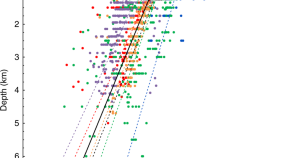
Large deep-sea zooplankton biomass mirrors primary production in the global ocean
Zooplankton biomass in the dark ocean is thought to be low and weakly coupled to epipelagic primary production, but recent evidence suggests otherwise. Here the authors analyse data from the Malaspina Circumnavigation Expedition and published data to estimate bathypelagic zooplankton biomass and assess its relationship to primary production, currently not well accounted for in oceanic C budget.
- S. Hernández-León
- R. Koppelmann
- C. M. Duarte
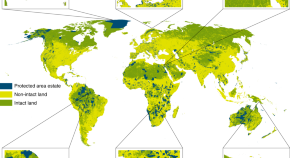
Just ten percent of the global terrestrial protected area network is structurally connected via intact land
The effectiveness of protected areas depends not only on whether they are intact, but also on whether they are mutually connected. Here the authors examine the structural connectivity of terrestrial protected areas globally, finding that less than 10% of the protected network can be considered connected.
- Michelle Ward
- Santiago Saura
- James E. M. Watson

Precise radiometric age establishes Yarrabubba, Western Australia, as Earth’s oldest recognised meteorite impact structure
The ~70 km-diameter Yarrabubba impact structure in Western Australia has previously been regarded as among Earth’s oldest meteorite craters, but has hitherto lacked absolute age constraints. Here, the authors determine a precise impact age of 2229 ± 5 Ma, which extends the terrestrial cratering record back in time by > 200 million years and establishes Yarrabubba as the oldest recognised meteorite impact structure on Earth.
- Timmons M. Erickson
- Christopher L. Kirkland
- Thomas M. Davison
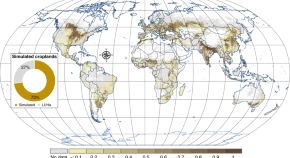
Global phosphorus shortage will be aggravated by soil erosion
Phosphorus is an essential nutrient critical for agriculture, but because it is non-renewable its future availability is threatened. Here the authors show that across the globe most nations have net losses of phosphorus, with soil erosion as the major route of loss in Europe, Africa and South America.
- Christine Alewell
- Bruno Ringeval
- Pasquale Borrelli
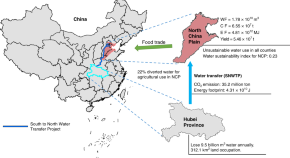
Impacts of irrigated agriculture on food–energy–water–CO 2 nexus across metacoupled systems
Local human activities can lead to cross-border environmental impacts through the food–energy–water–CO 2 nexus. Here, the authors report wide variations in environmental impacts of irrigated agriculture across counties within the North China Plain under different environmental and socioeconomic scenarios.
- Xiuzhi Chen
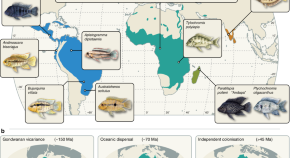
The genomic timeline of cichlid fish diversification across continents
Cichlids are a model for adaptive radiation, but the timing of their diversification is debated. Here the authors assemble 14 cichlid genomes, introduce a Bayesian approach to account for fossil-assignment uncertainty, and present a dated phylogenomic hypothesis of cichlid and teleost evolution.
- Michael Matschiner
- Astrid Böhne
- Walter Salzburger
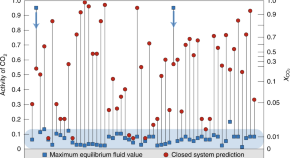
Pervasive subduction zone devolatilization recycles CO 2 into the forearc
The fate of subducted CO 2 remains debated, with estimates mainly from numerical predictions varying from wholesale decarbonation of the shallow subducting slab to massive deep subduction of CO 2 . Here, the authors present field-based data and show that ~40% to ~65% of the CO 2 in subducting crust is released via metamorphic decarbonation reactions at forearc depths.
- E. M. Stewart
- Jay J. Ague
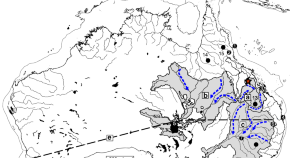
Extinction of eastern Sahul megafauna coincides with sustained environmental deterioration
The causes of the Upper Pleistocene megafauna extinction in Australia and New Guinea are debated, but fossil data are lacking for much of this region. Here, Hocknull and colleagues report a new, diverse megafauna assemblage from north-eastern Australia that persisted until ~40,000 years ago.
- Scott A. Hocknull
- Richard Lewis
- Rochelle A. Lawrence
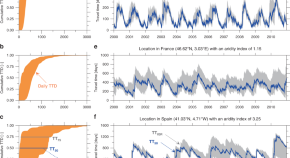
Strong hydroclimatic controls on vulnerability to subsurface nitrate contamination across Europe
Excess fertilizer use causes subsurface contamination. Here, the authors conduct an assessment of water quality vulnerability across Europe, finding that 75% of agricultural regions are susceptible to nitrate contamination for least one-third of the year, two times more than using standard estimation procedure.
- S. Attinger
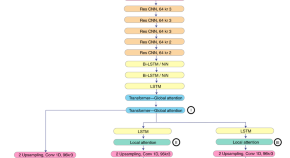
Earthquake transformer—an attentive deep-learning model for simultaneous earthquake detection and phase picking
The authors here present a deep learning model that simultaneously detects earthquake signals and measures seismic-phase arrival times. The model performs particularly well for cases with high background noise and the challenging task of picking the S wave arrival.
- S. Mostafa Mousavi
- William L. Ellsworth
- Gregory C. Beroza
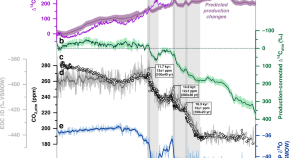
Glacial heterogeneity in Southern Ocean carbon storage abated by fast South Indian deglacial carbon release
A Southern Ocean influences on the carbon cycle is considered a key component of deglacial changes. Here, the authors show spatial differences in glacial Southern Ocean carbon storage that dissipated rapidly 14.6 kyr ago, revealing a South Indian Ocean contribution to rapid deglacial atmospheric CO 2 increases.
- Julia Gottschalk
- Elisabeth Michel
- Samuel L. Jaccard
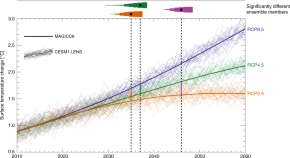
Delayed emergence of a global temperature response after emission mitigation
Strong mitigation of anthropogenic emissions is necessary, but it is not clear how fast these efforts would lead to temperature changes. Here, the authors find that there is a substantial delay between reductions of emissions and a detectable change in surface temperature for a number of climate forcers.
- B. H. Samset
- J. S. Fuglestvedt
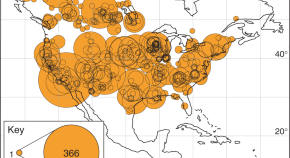
The human impact on North American erosion, sediment transfer, and storage in a geologic context
Human activities have accelerated soil erosion and landscape change in many areas. Here the authors show how rates of erosion, sediment transfer and alluvial sedimentation have increased by an order of magnitude across North America since European colonization, far exceeding the rates expected of natural processes.
- David B. Kemp
- Peter M. Sadler
- Veerle Vanacker
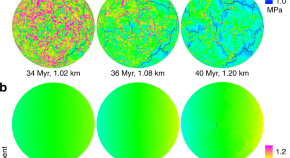
Breaking Earth’s shell into a global plate network
How Earth’s lithosphere first divided into tectonic plates remains uncertain. Here, the authors use 3D spherical shell models to demonstrate that anticipated warming of the early lithosphere should lead to thermal expansion and the initiation of a global network of rifts, dividing the lithosphere into tectonic plates.
- A. A. G. Webb
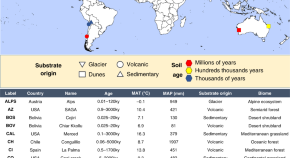
The influence of soil age on ecosystem structure and function across biomes
Soil age is thought to be an important driver of ecosystem development. Here, the authors perform a global survey of soil chronosequences and meta-analysis to show that, contrary to expectations, soil age is a relatively minor ecosystem driver at the biome scale once other drivers such as parent material, climate, and vegetation type are accounted for.
- Manuel Delgado-Baquerizo
- Peter B. Reich
- Noah Fierer
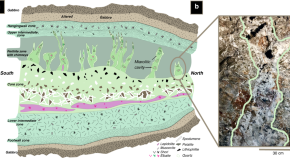

Episodes of fast crystal growth in pegmatites
Pegmatite crystals are thought to grow rapidly, yet their growth rates and conditions are not well constrained. Here, the authors find that the trace element distributions of pegmatitic quartz crystals indicate rapid growth in highly dynamic environments, suggesting that large meter-scale crystals can be formed within days.
- Patrick R. Phelps
- Cin-Ty A. Lee
- Douglas M. Morton

Regime shifts occur disproportionately faster in larger ecosystems
Little is known about how the speed of ecosystem collapse depends on ecosystem size. Here, Cooper, Willcock et al. analyse empirical data and models finding that although regime shift duration increases with ecosystem size, this relationship saturates and even large ecosystems can collapse in a few decades.
- Gregory S. Cooper
- Simon Willcock
- John A. Dearing
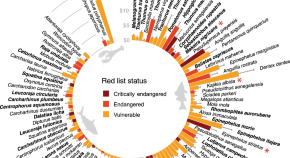
Over 90 endangered fish and invertebrates are caught in industrial fisheries
Due to legislative shortfalls, species of global conservation concern can still be captured in commercial fisheries. Here the authors show that 91 threatened species are reported in catch/landing databases, 13 of which are traded internationally despite their conservation concern.
- Leslie A. Roberson
- Reg A. Watson
- Carissa J. Klein
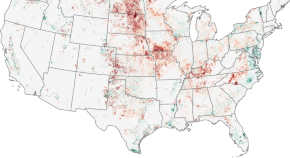
Cropland expansion in the United States produces marginal yields at high costs to wildlife
Conversion of natural ecosystems to cropland is a threat to most native wildlife. Here the authors quantify the impact of recent cropland expansion on the habitat of representative pollinator, bird, plant species across the conterminous United States, showing diminished crop yield returns at the cost of important habitat losses.
- Tyler J. Lark
- Seth A. Spawn
- Holly K. Gibbs
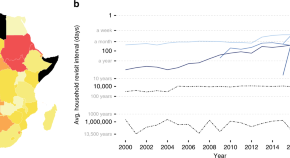
Using publicly available satellite imagery and deep learning to understand economic well-being in Africa
It is generally difficult to scale derived estimates and understand the accuracy across locations for passively-collected data sources, such as mobile phones and satellite imagery. Here the authors show that their trained deep learning models are able to explain 70% of the variation in ground-measured village wealth in held-out countries, outperforming previous benchmarks from high-resolution imagery with errors comparable to that of existing ground data.
- Christopher Yeh
- Anthony Perez
- Marshall Burke
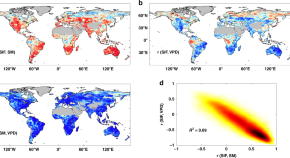
Soil moisture dominates dryness stress on ecosystem production globally
Dryness stresses vegetation and can lead to declines in productivity, increased emission of carbon, and plant mortality, but the drivers of this stress remain unclear. Here the authors show that soil moisture plays a dominant role relative to atmospheric water demand over most global land vegetated areas.
- Lukas Gudmundsson
- Sonia I. Seneviratne
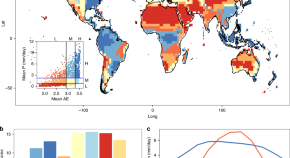
Climate change will affect global water availability through compounding changes in seasonal precipitation and evaporation
Adequate water availability is key to human and ecosystem sustainability. Here, the authors show that seasonally variable regimes become more variable, and the combined influence of seasonality and magnitude of climate variables will affect future water availability.
- Goutam Konapala
- Ashok K. Mishra
- Michael E. Mann
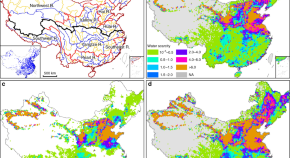
Pollution exacerbates China’s water scarcity and its regional inequality
The impact on inadequate water quality on water scarcity is unclear. Here the authors quantify China’s present-day water scarcity and show that inadequate water quality exacerbates China’s water scarcity, which is unevenly distributed across the country.
- Chenghu Zhou
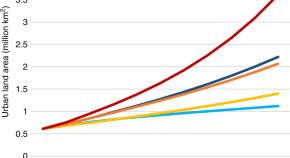
Mapping global urban land for the 21st century with data-driven simulations and Shared Socioeconomic Pathways
Here the authors develop a set of global, long-term, spatial projections of urban land expansion for understanding the planet’s potential urban futures. The global total amount of urban land increases by a factor of 1.8-5.9 over the 21st century, and the developed world experiences as much new urban development as the developing world.
- Brian C. O’Neill
Quick links
- Explore articles by subject
- Guide to authors
- Editorial policies
An official website of the United States government
The .gov means it’s official. Federal government websites often end in .gov or .mil. Before sharing sensitive information, make sure you’re on a federal government site.
The site is secure. The https:// ensures that you are connecting to the official website and that any information you provide is encrypted and transmitted securely.
- Publications
- Account settings
Preview improvements coming to the PMC website in October 2024. Learn More or Try it out now .
- Advanced Search
- Journal List
- v.6(30); 2021 Aug 3

Plastic Pollution: A Perspective on Matters Arising: Challenges and Opportunities
Austine ofondu chinomso iroegbu.
† Department of Chemical Sciences, University of Johannesburg, Doornfontein 2028, Johannesburg, South Africa
‡ Centre for Nanostructures and Advanced Materials, DSI-CSIR Nanotechnology Innovation Centre, Council for Scientific & Industrial Research, CSIR, Pretoria 0001, South Africa
Suprakas Sinha Ray
Vuyelwa mbarane.
§ State Information Technology Agency (SITA), 459 Tsitsa Street, Erasmuskloof 0048, Pretoria, South Africa
João Carlos Bordado
∥ Centro de Recursos Naturais e Ambiente (CERENA), Instituto Superior Técnico, Universidade de Lisboa, Av. Rovisco Pais, 1, 1049-001 Lisboa, Portugal
José Paulo Sardinha

Plastic pollution is a persistent challenge worldwide with the first reports evidencing its impact on the living and nonliving components of the environment dating back more than half a century. The rising concerns regarding the immediate and long-term consequences of plastic matter entrainment into foods and water cannot be overemphasized in light of our pursuit of sustainability (in terms of food, water, environment, and our health). Hence, some schools of thought recommend the revisitation and continuous assessment of the plastic economy, while some call for the outright ban of plastic materials, demonstrating that plastic pollution requires, more than ever, renewed, innovative, and effective approaches for a holistic solution. In this paper, dozens of reports on various aspects of plastic pollution assessment are collated and reviewed, and the impact of plastic pollution on both the living and nonliving components of the environment is discussed. Current challenges and factors hindering efforts to mitigate plastic pollution are identified to inform the presented recommendations while underscoring, for policymakers, stakeholders, and the scientific community, the exigency of finding sustainable solutions to plastic pollution that not only encompass existing challenges but also future threats presented by plastic pollution.
1. Pollution—An Overview
Pollution is a global phenomenon, a persistent challenge that is transnational (i.e., borderless) in nature, transinstitutional in purview, and transdisciplinary in solution scope. 1 − 3 As indicated in Figure Figure1 1 , pollution can arise naturally, for example, by saltwater intrusion into freshwater resources and volcanic eruptions that release dangerous gases, or it can be manmade, a result of anthropogenic activities such as the exploitation of the environment and its resources and the introduction of matter or energy into the environment that are not natural to it. 4 − 6 Substances or energies (e.g., material entropy) that are introduced into the environment through anthropogenic activities can upset and compromise the natural balance of the earth’s intricate and inter-related systems, causing a “domino effect”. 7 − 9 Pollution can also be considered as (an) unnatural disturbance(s) arising from the intrusion of energy or matter into the environment, which may result in the interruption (i.e., modification) or degradation of the natural state of a system or environment, thereby increasing the risk of the system or environment deviating from its initial state (i.e., original conditions and functions). For example, the water present in commercial petroleum products (e.g., gasoline) can be considered a pollutant because it affects the original conditions and functions of these products in motor engines. Hence, it can be inferred that chemical reactions usually occur as a result of unnatural disturbances (i.e., the agitation or excitation of the state of matter or a system), causing the transformation or transmutation of substances (i.e., matter) from one form to another (which may be reversible or irreversible); accordingly, pollution has the potential to change the dynamics of matter and environments, which consequentially impacts the natural characteristics of living and nonliving components. 8 , 10 Notwithstanding, we hold that matter or energy entering an environment cannot be considered pollution (or a pollutant) if the effect of such intrusion or disturbance on the environment or system is not negative, i.e., is (i) neutral or (ii) positive. Hence, we posit that meeting these conditions should be the basis for considering such matter or energy as “green” or “eco-friendly”. For example, sunlight is considered friendly to green vegetation but unfriendly to plastic materials; in the former, it is vital for photosynthesis, and in the latter, it is known to promote photodegradation.

Common sources of pollution.
Pollution has detrimental consequences, which cannot be overstated in light of current environmental challenges. For example, it has been reported that a slight deterioration in air quality, owing to pollution, significantly impairs the natural behavior of bees, interrupting their critical roles in the ecosystem and thereby threatening food security. 11 Elsewhere, it has been found that a strong correlation exists between congenital anomalies and community exposure to chemicals associated with environmental contaminants. 12 A recent study has shown that the deterioration in the quality of milk in breastfeeding mothers can be traced to environmental pollution; it further contends that pollutants, such as polychlorinated biphenyls (PCBs), entering the human body have the potential to disrupt and alter the natural balance of a mother’s milk with health consequences for breastfeeding infants that can range from allergies and endocrine disorders to impaired neurodevelopment. 13 To place the existential threat of pollution in context, a global health assessment has established that more than 20% of global deaths can be traced to pollution-related health complications. 14 Pollution impacts almost every aspect of our existence and the living and nonliving components of the environment. For example, satellite data spanning three decades evidence the devastating impact of global warming (a result of environmental pollution), which has shrunk Greenland’s ice sheets to almost nothing, thus contributing to rising global sea levels. 15
Plastic pollution is a pressing global challenge owing to the pervasive, near-unmanageable threat it poses to living and nonliving systems and the environmental stress it causes. 16 , 17 Herein, we define plastic pollution (encompassing macro-, micro-, and nanoplastic debris) as the intrusion or invasion by plastic materials (i.e., polymeric systems), either through direct introduction or degradation processes, of environments (to which they are not native) to negatively or undesirably impact such environments. Similar to greenhouse gases, persistent pollutants, and other environmental contaminants, plastic pollution cannot be restricted by territorial boundaries or legislation because it is able to migrate between water bodies, disperse through air, and be transported to remote locations through human intervention. 18 − 20
The following criteria are considered conditions for qualifying a pollutant as hazardous to the environment: 8 (i) its biological impact even at minute concentrations is significant (noticeable and observable); (ii) it easily diffuses into the atmosphere, is soluble in water, and has an affinity for accumulating in environments; (iii) it tends to persist in a given environment; (iv) it can impact a wide range of targets (living and nonliving), especially those directly linked to human health or important for environmental stability and functions; (v) its degradation byproducts or their combination with other environmental chemical compounds exhibit toxicity, persist, and accumulate in a target or exceed the original levels of the material; (vi) it is suitable for large-scale production and its benefits are considered to outweigh the concomitant cost of pollution. This perspective shows that plastic pollution satisfies all of these criteria and, thus, is hazardous to both living and nonliving systems in the environment.
A Google Scholar search using the search criteria “Plastic Pollution” at 10-year intervals in the last seven decades reveals that the number of publications on plastic pollution has increased, as shown in Figure Figure2 2 . Across the world, the issue of plastic pollution has brought about a paradigm shift in discourses on climate change and ocean and environmental sustainability. 21 , 22 In almost every country in the world, multiple individuals and groups have become environmental activists against plastic pollution. 23 In addition, governments, world leaders, and various stakeholders participate in discussions, conventions, and resolutions in concerted efforts to find a holistic solution to plastic pollution. 24 , 25

Number of publications between 1952 and 2021 on plastic pollution. The search engine was Google Scholar, while the keyword for the search was Plastic Pollution.
However, despite being a half-century-old problem, it is evident that the threat posed by plastic pollution is not abating and remediation will require, more than ever, renewed effort and a holistic approach with concrete commitments from all stakeholders. Borrelle et al. 17 estimated that more than 10% of the global plastic waste generated in 2016 found its way into aquatic environments. Moreover, they forecast that, without immediate intervention, by 2030, the world’s aquatic environments could contain more than 80 metric ton (Mt) of plastic debris. 17 Such a volume of plastic added to the world’s aquatic environments would displace an equal volume of water, shrinking aquatic habitats, increasing the likelihood of floods, and exacerbating global warming; 2 these phenomena, in turn, have countless negative consequences, such as endangering individuals and communities, destroying properties, and straining healthcare facilities and resources, government budgets, and the insurance industry, demonstrating the wider impact of plastic pollution. 26 − 28
Concerns regarding the mounting challenges of pervasive environmental and biological stressors, chiefly arising from the short- and long-term impacts of plastic pollution, have prompted the consolidation of the efforts (and associated financial, scientific, economic, and political resources) of stakeholders, worldwide, in the form of a sustainable development goal (SDG) initiative that prioritizes sustainable and healthy earth for all. 29 Therefore, discourses on environmental pollution such as plastic pollution should evaluate challenges, possible amelioration/mitigation, or control, with reference to the SDGs and current environmental issues.
This perspective differs from existing publications on plastic pollution ( Table 1 ) as it underscores key challenges and factors hindering global efforts to mitigate the menace of plastic pollution while highlighting various views on plastic pollution. It also discusses important developments and initiatives, aimed at mitigating the environmental impacts of plastic pollution, and presents recommendations that are based on a multidisciplinary approach. Policymakers, stakeholders (i.e., the plastic economy value chain), and the scientific community are alerted to the exigency of synergistically reshaping the current plastic economy to demonstrate a commitment toward the pursuit of green(er) plastics and support of blue sea initiatives, focusing on sustainable solutions that address the existing and future challenges presented by plastic pollution.
Plastics are polymeric systems (i.e., macromolecules), for example, polyethylene, polyacrylamides, polyesters, and polypropylene. Although plastics are generally polymers, not all polymers are plastics, such as natural cellulose, carbohydrates, proteins (e.g., leather), lignin, and natural rubber ( Hevea brasiliensis ). In this perspective, we consider plastic pollutants to be polymer-based materials in the environment, which may be plastics or not, that are potentially harmful.
2. A World of Polymers
We have always lived in the polymer age. Humans are essentially polymeric, from the deoxyribonucleic acid (DNA) that encodes our human traits to the protein that covers our body (skin) and our keratin-laden hair. Moreover, our living, walking polymeric forms are sustained by the polymers we consume in the forms of carbohydrates and proteins and protected by the polymer-based clothes we wear. Advances in polymer science and engineering over the years have led to the discovery and commercialization of various polymer-based systems or materials such as polycarbonates, nylons, polyimides, polyurethanes, and liquid crystals, which have found various domestic and industrial applications that shape our world and advance our quality of life. Polymers feature prominently in almost every sector of the economy, from industries that manufacture pharmaceuticals, composites, and tires to laboratories that perform DNA profiling for criminal investigations by law enforcement agencies, demonstrating that polymers and polymer science have contributed and continue to contribute to civilization; additional examples are presented in Figure Figure3 3 . 35 − 38 Owing to great minds such as Hermann Staudinger (1881–1965), Wallace Hume Carothers (1896–1937), Paul J. Flory (1910–1985), and Stephanie L. Kwolek (1923–2014) advancing the field of polymer science and engineering, plastics are considered one of man’s greatest feats in the field of science and technology. 39 , 40 In 1962, Fred Wallace Billmeyer Jr. (1919–2004) predicted that, with advances in polymer science and engineering, plastics will become the dominant materials of the future, surpassing steel, aluminum, and copper. 41 More than half a century later, this prediction seems accurate as, in recent times, plastics have outperformed competing materials, including wood, metal, and glass, as the material of choice in diverse domestic and industrial applications; the production of plastics exceeded 8 billion Mt between 1950 and 2015. 2 , 42

Immense contributions of polymers to human advancement and civilization cannot be overstated; polymers feature heavily in almost every sector of the economy.
Owing to their flexibility and adaptability for various applications, lightweight, moisture resistance, corrosion resistance, and low-cost plastics are sought-after materials for various applications. Commodity plastics such as polypropylene, which is a very cost-effective polymeric material that can be blow-molded, extruded, thermoformed, or injection-molded, are popular for the fabrication of products such as packaging films, plastic crates used for good transportation, storage containers (e.g., ice cream containers and yogurt containers), plastic caps, jerry cans, and hair combs. Other well-known commodity plastics include poly(vinyl chloride) (generally known as PVC and employed in piping and insulation systems), polyethylene (generally employed in packaging films), and poly(ethylene terephthalate) (PET; generally employed in beverage packaging). 36 , 43 Since our reliance on polymers increases in step with advances in science and technology (e.g., robotics, artificial intelligence, synthetic organs, insulation for energy conservation, and smart materials), a future that is not enriched and heavily dependent on plastics seems unlikely. 43 − 45
3. Health and Environmental Issues
There is no gainsaying that plastics have contributed immensely to the rise of human civilization; however, the distribution of plastic debris (macro-, micro-, and nanoplastics) in the environment and its entrainment into biological systems have become a serious issue. 46 Various health conditions such as thyroid dysfunction, obesity, diabetes, and reproductive impairment have been attributed to plastic pollution. 47 For example, it has been shown that nanoplastics impact negatively the composition and diversity of microbial communities in the human gut, which, considering emerging research evidencing the strong relationship between the gut and neural networks in the brain, could negatively impact the endocrine, immune, and nervous systems. 20 As already highlighted, pollution changes the dynamics of systems and environments with consequential impacts on the natural characteristics of their living and nonliving components; thus, it is reasonable to infer that the entrainment of nanoplastics into the human gut holds physiological consequences. The genotoxicity of micro- and nanoplastics to DNA has been established. It has been demonstrated that if the plastic matter is small enough to cross the nuclear membrane surrounding the DNA, damage can occur, impairing the DNA structure or forming lesions, which, unrepaired or misrepaired, can cause mutagenic processes that are considered to play a role in the carcinogenesis of cells. Additionally, it was found that the type and level of damage of DNA depend on the shape, functional groups, and chemical composition of the plastic debris. 48 The human airway is a key pathway for plastic fiber entrainment into the lungs, and biopersistence of the fibers depends on their length, structure, and chemical composition. Moreover, at certain exposure limits, all plastic fibers are likely to produce inflammation, which can lead to lung challenges such as the formation of reactive oxygen species with the potential to initiate cancerous growth through secondary genotoxicity. 49 Although there are few studies on the extent of the damage that prolonged exposure to plastic particles can cause to the human body (suggesting the need to increase research in this area), it is accepted that industry workers at textile facilities are at a high risk of contracting occupational diseases arising from high exposure to textile fibers. 50 It has long been established that constituents of plastic packaging chemically interact with or migrate into fat-containing foods; typical interactions include the migration of antioxidants from the plastic packaging into the food, sometimes bonding to the food surface. 51 Such transfer of packaging additives from the packaging material to its food content is a potential health risk. Furthermore, PET, a common plastic employed in the food and beverage industry, is a source of endocrine disruptors; 52 these endocrine disruptors leach from the plastic packaging into the consumables that it contains. Even at standard room temperature, phthalates (potential endocrine disruptors) are known to leach from PET packaging into various food contents in the presence of water. 52
The low thermal conductivities of plastic materials, although considered advantageous in certain applications (e.g., heat insulation), 43 contribute to global warming when these plastics are distributed in aquatic environments; they displace equal volumes of water and restrict heat flow from the sun to the aquatic environment, leading to a rise in sea levels and the dissipation of energy into the immediate environment. 2 The degradation pathways of plastics in the environment can also contribute to environmental stress. For example, Gewert et al. 53 posited that PVC, a very unstable polymer in the presence of UV radiation (+ h v), undergoes dechlorination in the environment, forming polyene moieties and hydrochloric acid (HCl) in the presence of water, as shown in Scheme 1 .

Reproduced with permission from Gewert, B.; Plassmann, M. M.; MacLeod, M. Pathways for degradation of plastic polymers floating in the marine environment. Environ. Sci.: Process. Impacts 2015 , 17, 1513–1521. 53 Copyright 2015, Royal Society of Chemistry, UK.
This dechlorination process and subsequent release of HCl have the potential to contribute to the acidification of aquatic environments by decreasing the pH level, in addition to the acidification caused by atmospheric CO 2 . It has been highlighted that increasing ocean acidity will aggravate global warming, 54 , 55 detrimentally affecting and possibly mutating habitats and the characteristics of various environments 56 , 57 to seriously undermine our goal of sustainable earth for future generations. However, a major concern must be raised at this point: the risk posed by PVC debris on living systems. Can PVC debris find its way into living systems? If it can, does it follow the above-mentioned degradation pathway? If it does, what health challenges do direct dechlorination and the subsequent release of HCl present living systems such as humans?
The load-bearing capacity of an environment is considered finite and it is believed that exceeding this capacity of an environment (and its living and nonliving components) to tolerate stressors such as synthetic waste (e.g., plastic debris) can result in unpredictable, possibly catastrophic, situations owing to a butterfly effect. 9
4. Challenges Associated with Plastic Pollution Mitigation
Factors militating against efforts to manage and limit the negative environmental impacts of plastic pollution are numerous and multifaceted; they include economic and political factors, a lack of commitment by governments and global plastic economy stakeholders, dissenting opinions of scientists, and under-reported or overlooked polluters. 2 , 58 − 61 Here, we highlight a few important challenges. For example, in October 2020, it was reported that the United States generated an estimated 42 Mt of plastic waste in 2016, of which between 0.14 and 0.41 Mt was allegedly dumped illegally into the environment (land and water) and another 0.15–0.99 Mt was exported to other countries such as South Africa, Indonesia, and Mexico, where it was inadequately recycled (either burnt or discarded in open landfill sites). It was further stated that between 2010 and 2016, the United States was the most significant contributor to plastic pollution in the environment, overtaking China. 62 This indicting report of a technologically and economically advanced country such as the United States and others 63 demonstrates one of the key challenges facing global efforts to mitigate plastic pollution, i.e., the tendency of global powers to pass the responsibility for their generated waste on to poorer nations, who are less equipped to recycle or manage the waste. Hence, we contend that the issue of plastic pollution and its mitigation strategies transcend the generally narrow public focus on single-use carrier bags (although they contribute to the problem) and concern powerful stakeholders such as multinational corporations and top brands that have the capacity (financially, politically, etc.) to undermine or circumvent concerted global efforts to address plastic pollution. For example, based on an audit undertaken in more than a dozen countries, it was found that well-known global brands, such as Coca-Cola, Nestlé, PepsiCo, and Unilever, are among the top sources of plastic pollution (for the third consecutive year); 64 yet, there are scant reports of these brands taking ownership of the environmental threat posed by plastic packaging used in their products, especially in countries in sub-Saharan Africa (e.g., Nigeria). 65
Multiple studies have demonstrated that automobile tires are significant contributors to microplastic pollution in the environment. For example, Kole et al. 66 demonstrated that the wear and tear of tires contribute significantly to the entrainment and distribution of plastic particles in the environment. They estimate the annual per capita emission of tire particles to range between 0.23 and 4.7 kg, with a global average of 0.81 kg. Furthermore, they contend that 5–10% of the plastic pollution in aquatic environments is derived from automobile tires, while 3–7% of the plastic particles in the air that we breathe is derived from automobile tires, which is a significant contribution to the global air burden. 66 However, they did not collate data on the amount of plastic matter, derived from tires, that enters the food chain (through water and air), or how much is consumed by ruminants owing to plastic matter trapped/settled on their food sources, e.g., grasses. Furthermore, they did not include comprehensive data from the wear and tear of bicycle tires or tires employed in the aviation industry since reports that quantify the contributions of these categories of plastic polluters are limited. A related study quantified the relative abundance of plastic matter (i.e., microplastic debris) generated by the wear and tear of automobile tires at roadside drains and in the natural environment near major road intersections, finding that it ranged from 0.6 ± 0.33 to 65 ± 7.36 in 5 mL of sampled material. The report also noted that plastic debris tends to act as a vector for other hazardous systems and thus persists in the environment with serious negative consequences. 67 Owing to increasing concerns that automobile users contribute substantially to microplastic distribution in the environment, the Swedish Government commissioned the Swedish National Road and Transport Research Institute (VTI) to conduct a comprehensive study of this matter between 2018 and 2020. The key findings of their study are summarized. 68
- At least half of Sweden’s microplastic pollution derives from tires.
- Particles as large as 20 μm are deposited on or near roads and are carried off by winds to remote places. In addition, rain or snow clean-up processes transport these particles to other locations.
- Stormwater transports tire-based microplastics into open waters, reservoirs, and containment areas.
- It is necessary to further investigate the transportation and fate of these generated microplastics in sewerage and natural organisms.
Notwithstanding the mounting evidence of tire-based microplastic pollution, the multibillion-dollar tire industry is resisting scrutiny of its contribution to plastic pollution and the imposition of sanctions and regulations through the intense lobbying of European Union (EU) lawmakers. The report further highlighted how the tire industry commissioned and published no less than ten studies to counter reports revealing the significant risk that tire particles pose to humans and the environment; 69 again demonstrating how polluters undermine efforts to mitigate the plastic pollution caused by their products. In addition, several studies have argued that because tire particles contain toxic substances, such as polycyclic aromatic hydrocarbons (phenanthrene, butylated hydroxyanisole, 2-methylnaphthalene, etc.) that are considered to pose serious health risks to living systems, 70 , 71 their distribution in the environment should not be trivialized.
Another factor limiting efforts to mitigate plastic pollution is the dissenting opinions and counteropinions held by scientists on various aspects of plastic pollution, e.g., sources, risk assessment, and toxicology. For example, Stafford and Jones 72 opine that addressing plastic pollution, such as ocean plastic pollution, is less pressing than addressing other environmental challenges such as climate change and biodiversity loss. They insist that emerging reports highlight the exigency of directing global efforts toward mitigating carbon emissions rather than expending energy on lesser threats, such as marine plastics. They further suggest that although ocean plastic pollution is a problem that needs attention, it does not pose an immediate ecological or toxicological threat at a planetary boundary level (i.e., the threat posed by plastic pollution is contextually less pressing than the threats posed by climate change and biodiversity loss that have long exceeded core planetary boundaries). 72 However, Avery-Gomm et al. 73 have challenged the position of Stafford and Jones, 72 arguing that global threats must continually be kept in perspective because undermining one threat by substituting it with another so-called “heftier” threat would be counterproductive in the global pursuit of sustainability. In their concluding remarks, they posit that the continuous discourse on plastic pollution has informed the improvement of the monitoring and risk evaluation of plastic pollution, as well as the development of frameworks for mitigation and remediation. 73 Elsewhere, an environmental toxicologist and risk assessor has argued that microplastics in marine and freshwater ecosystems do not pose any threat to the aquatic habitat as long as these pollutants are in low concentrations, despite the contradictory views of fellow scientists, referring to the threat posed by microplastics to aquatic habitats as a superficial risk. 74 However, this trivialization of the threat posed by plastic pollution on not only aquatic habitats but also terrestrial and arboreal environments is strongly rejected by Hale, 75 who insists that there is no basis to downplay the threat posed by plastic pollution to aquatic habitats. Hale contends that, in addition to plastic particle size, assessments of the toxicological impacts and consequences of plastic pollution in any given environment must consider the chemical compositions of the polymeric materials employed in the manufacture and production of the plastic materials; the shapes, surface areas, density, and persistence of the plastic particles; as well as the effects of additives (e.g., modifiers) and even sorbed pollutants (e.g., carriers and/or transfer agents). 75 Hale’s position is supported by Kramm et al., 76 who add that plastic pollution is a prototypically global and complex anthropogenic issue. They hold that a reductionist approach to addressing a serious environmental issue such as that presented by plastic pollution is detrimental to mitigation efforts. Moreover, they consider it high time that the scientific community takes responsibility for the environmental problems resulting from the work and inventions of scientists rather than trivializing or shirking responsibility. 76 Although some scientists may want to trivialize the threat of plastic pollution, it is generally accepted that any substance or energy can become toxic and environmentally disruptive at sufficient concentrations. 8 The fundamentally different opinions of scientists are a key challenge to forging cooperation; after all, a house divided against itself cannot stand. Such differences also convey disunity and present avenues or opportunities for plastic polluters to exploit, to avoid responsibility, to the detriment of the environment and, by extension, humanity.
Studies have evidenced that textiles and fibers are major contributors to the plastic materials that entrain into human lungs, food, and the environment ( Table 2 ). 49 , 77 However, because clothing is a primary human need, the textile industry directly and indirectly employs more than 100 million people globally and is a significant contributor to the gross domestic product (GDP) and economic growth of various nations. 78 , 79 In this context, addressing the plastic pollution resulting from the use of textiles and fibers is a challenge since any approach will have consequences (whether that approach involves banning the use of textiles and fibers or mitigating their contribution to plastic pollution as much as possible). Figure Figure4 4 shows how much textile lint accumulates in the lint trap of a commercial dryer in a laundry house. This commercial dryer features a trap that prevents lint from escaping; however, washing machines and dryers that do not feature appropriate filtration systems release significant volumes of textile fibers into the environment.

Lint accumulation from a winter blanket in a commercial dryer. (A) Winter blanket loaded inside a commercial dryer. (B) Accumulation of lint inside the lint trap during the drying of the blanket. (C) Unweighed lint accumulated in the lint trap from the winter blanket after a single dry cycle. Photo Credit: First author (AOCI).
Moreover, considering that most polymers employed in the manufacturing of synthetic fibers and textiles are derived from petroleum and fossil-based resources, plastic pollution mitigation becomes a challenge (especially for oil-dependent economies) when balancing economics and politics. 80 , 81
Products and polymer-based articles, such as toothbrushes, shoes (materials or soles may be made from plastics), insulated electrical cables and equipment, light switches, writing pens (i.e., plastic cases), writing and printing inks (employ polymeric systems such as drag-reducing agents and stabilizers), mattresses, wigs and artificial hair (usually derived from high-performance polymers), artificial nails (e.g., acrylics), kitchen wipes (composed of microfibers), automobile paints, phone casings, computer casings, plastic wristwatches, and marine paints, are usually overlooked or underestimated as significant contributors to plastic pollution. Collectively, the “insignificant” contributions of these products or articles to plastic pollution, owing to poor disposal or through the process of wear and tear/degradation, is less insignificant. Notwithstanding, several reports focus on single-use plastic carrier bags as the primary plastic pollutant menacing our environment. 84 , 85 While we do not fault the positions held by these scientists, we argue that almost everyone releases plastic matter into the environment on a daily basis, e.g., through the shedding of textile fibers from our clothing. Hence, a more holistic approach to the management and control of plastic pollution is necessary to realize a sustainable environment. A small leak will sink a great ship; hence, we must beware of the plastic fibers that billions shed from their clothes daily or that is derived from insignificant contributors. It is our opinion that most people have little or no idea that their footwear (made from polymeric materials) also contributes to plastic pollution in the environment through wear and tear. As people tread on road surfaces, these surfaces abrade their footwear and accumulate plastic particles, which are subsequently washed away by rain into open waters. Furthermore, reports on the contributions of automobile and marine paints/coatings to plastic pollution through wear and degradation are limited. We submit that the contributions of automobile and marine paints/coatings to plastic pollution must be analyzed and quantified, as they represent potential secondary or primary sources of micro- and nanoplastic stressors in the environment. Moreover, the advanced paints and coatings (e.g., anticorrosive paints and coating) 86 , 87 that scientists and technologists are developing may pose additional environmental challenges when such materials leach, degrade, or form sediments in particular environments. It is worth noting that during the environmental degradation of paints and coatings, sorbed pollutants or additives may combine with biogenic systems and unpredictably alter living and nonliving systems in the environment. These plastic pollutant sources are usually overlooked or understudied, resulting in a knowledge gap that must be addressed to formulate a holistic approach to the management and control of plastic pollution in various environments.
5. Opportunities
Evidently, plastic pollution is a global challenge, and, as has been demonstrated, it meets all of the criteria of an environmental hazard for both the living and nonliving components of the environment. It is also apparent that a plastic-free future is unlikely despite the threat plastic pollution poses to the environment. 25 In addition, emerging data indicate an increase in global plastic pollution owing to the demand for personal protective equipment, 88 , 89 such as facemasks, to limit the spread of COVID-19. Besides, even if we were to ban the production and use of plastics, we would still need to address the plastic pollution currently present in our water, atmosphere, soil, consumables (e.g., table salts), and even vegetation (e.g., wheat and lettuce). 90 − 92 Hence, concerted global efforts are required to mitigate, manage, and control the current and possible future threats plastic debris distribution in the environment poses to its living and nonliving systems. Fortunately, various courses of action can be taken to realize this goal.
5.1. Plastic Education in National Curricula
Because prevention is better than cure, environmental responsibility and sustainability must be taught (formally and informally) from childhood, be it at home or in religious or formal education settings, to instill an appreciation of life and the environment. Such an educational approach is comparable to comprehensive sex education (CSE) that forms part of school curricula and teaches students life skills that enable them to make appropriate and healthy choices concerning their sexual lives. 93 We hold that incorporating plastic education into the national curricula is critical to mitigating, managing, and controlling plastic pollution and fostering sustainability. 94 We have enumerated elsewhere 2 the opportunities a plastic education curriculum presents. Hence, we support the call by the comity of nations for a global curriculum on plastic pollution, taught from kindergarten to the tertiary level, that addresses existing and emerging environmental and sustainability goals and objectives. For example, it has been established that handwashing clothes limits the amount of plastic fibers that ends up in the environment and prolongs the life span of fabrics. Although most people would consider using washing machines to do their laundry, a greater understanding of the limitations of these conveniences in mitigating plastic pollution may change behavior. It is believed that one of the reasons plastic pollution persists is the disconnect between scientific knowledge and the formative knowledge of the population. The population should be equipped with sufficient knowledge concerning the dangers and detrimental impact of plastic pollution (i.e., heightened risk awareness); instilling this risk awareness through formative education from childhood will promote the acceptance and support of policies and initiatives formulated to mitigate plastic pollution.
Religious and cultural institutions must actively participate in educating society on the value of sustainable earth and environment. It has been observed that culture, tradition, and religion all overwhelmingly influence the psyche, politics, emotional intelligence, and approach to life of individuals; 95 , 96 hence, addressing a global issue such as plastic pollution requires a rethink of our educational systems and the roles they play in promoting a sustainable environment. Human behaviors are ranked as some of the main challenges to addressing environmental issues; however, educational, religious, cultural, and traditional organizations can influence the attitudes and behaviors of their members in terms of environmental issues and are best placed to convince the population of the dire need to manage and control plastic pollution through behavioral change and ethical best practice. 2 , 97
Furthermore, global education systems should place greater emphasis on “responsible science”, where every scientific pursuit considers the environment to avoid engineering our own destruction. Scientists must understand that sustainability is their core mandate and must take ownership of the environmental challenges in which they are complicit. We believe that the formal and informal education sectors are critical to achieving the SDGs 29 and posit that plastic pollution mitigation, management, and control can only be achieved through the cooperation of all stakeholders, i.e., every human on the earth, for divided we fall. In closing, we emphasize that incorporating plastic education in national curricula to increase risk awareness is an opportunity that should not be squandered.
5.2. Green(er) Alternatives
We have previously mentioned that for a material to be considered green or eco-friendly, the effect of its intrusion or degradation in any given environment should either be neutral (have no net effect) or positive (energy-efficient, easily recyclable or reusable, etc.). In our view, the concept of “green plastics” should, in addition to biodegradability, encompass biocompatibility as well as a net neutral or positive impact on the environment. Hence, a “green plastic” should be an alternative polymeric material with properties or characteristics that are comparable or superior to those of conventional polymeric materials but that demonstrates less environmental impact. Such plastics can be biobased or fossil-based materials. 98 There has been an increasing and persistent call for rethinking the plastic economy in terms of the future of the environment; the sustainability of civilization; and the pursuit of green(er) chemistry, sustainable chemicals, and a circular economy. 99 − 102 Consequently, research that explores green(er) alternatives to conventional plastic materials has increased. For example, on June 5, 2014, Avantium ( https://www.avantium.com/ ) Technologies, headquartered in Amsterdam (The Netherlands), reportedly reached an agreement with international brands, such as Coca-Cola, Danone, Swire, and others, to produce packages exclusively from 2,5-furandicarboxylic acid (FDCA), a carbohydrate-based material, industrially known as poly(ethylene furanoate) (PEF), which affords many advantages over fossil-based PET, the dominant plastic material employed industry-wide in beverage packaging. 103 The advantages of PEF over PET include a higher gas barrier and better water, thermal, and tensile properties. 101
In recent years, a myriad of green(er) plastics with the potential to replace conventional plastics in various domestic and industrial applications has emerged. For example, nanocellulose has recently gained prominence as a versatile, benign, ubiquitous, and sustainable material that can be modified, spun, drawn, molded, and even cast, finding applications in almost every economic sector and replacing plastics and other conventional materials such as steel. 104 In addition to its abundance, nanocellulose has been demonstrated to represent a green(er) alternative to plastics used in, among others, the packaging industry, membrane fabrication, and composites with properties and characteristics comparable to and even exceeding those of conventional plastics in terms of resilience, lightweight, and strength. 105 As nanocellulose research and development advances, it is hoped that nanocellulose will replace conventional plastic materials in many domestic and industrial applications to promote our SDGs. The increasing number of green(er) alternatives to conventional plastics, such as DNA biodegradable materials, 106 lignin biodegradable and biocompatible composite films, 107 chitin biocompatible and biodegradable plastics and fibers, 108 , 109 biocompatible and nontoxic plastics derived from lactic acid, 110 is a testament to the promising technologies available to mitigate plastic pollution. In a yet-to-be-published work, we demonstrate that bamboo straws are not only green(er) than plastic straws but also sustainable and do not negatively impact the environment. We also posit that other green(er) articles, such as tires, shoes, and clothing, may become possible in the near future with concerted effort and political will.
5.3. Revision of Extended Producer Responsibility (EPR)
As previously noted, in too many cases, the cost of pollution is considered tolerable in terms of a narrow cost–benefit analysis; thus, the negative impact of plastic pollution on, among others, our ecosystem and health, with a cost of more than USD 2 trillion per annum is usually under-reported. 47 , 111 Moreover, because most of the plastic debris generated inland generally finds its way into aquatic ecosystems, the oceans are one of the environments worst hit by plastic pollution, with an estimated impact of over USD 1 trillion per annum in terms of the loss in ocean productivity. 112 As pointed out by Forrest et al., 47 the current extended producer responsibility (EPR) and other plastic-related laws must be reviewed to reflect the exigency of the threat posed by plastic pollution; moreover, “voluntary” financial contributions from entities throughout the value chain of the plastic economy would generate considerable funds for innovative waste management schemes and environmental remediation. The goal of a circular plastic economy will remain elusive unless processes and technologies exist that ensure that the recycling of waste plastic is economically viable; 47 to promote the realization of a circular plastic economy, such technologies and processes must not only be cost-competitive but also enable the production of high-purity monomers (that are comparable to virgin resins) from waste plastic recovered from the environment. 113 , 114 As long as plastic recycling is disincentivized by its high cost, realizing and sustaining a circular plastic economy will be expensive, which is one of the major reasons that stakeholders in the plastic economy value chain have not fully embraced the concept of a circular plastic economy despite the recognized benefits. 115 Furthermore, we suggest that tariffs and levies on reclaimed or recycled plastic goods and materials should be reviewed throughout the value chain to promote their economic viability and enable them to compete with products produced from virgin resins, thus encouraging businesses to engage in environmental remediation. In addition, policies should be formulated to encourage consumers to use reusable and recycled products, thus incentivizing the reclamation of plastic wastes.
Elsewhere, we have argued 2 that despite the potential benefits of a circular economy, such as job creation, infrastructure development, and a low-carbon economy, we do not foresee the realization of a sustainable circular plastic economy without the cooperation of policymakers, governments, and the population. Hence, the synergistic cooperation of all stakeholders is imperative to plastic pollution mitigation.
6. Conclusions
Pollution is a global phenomenon and no nation or continent is immune to its negative environmental impact. Plastic pollution, in particular, is hazardous to the living and nonliving components of the environment. The negative impact of macro-, micro-, and nanoplastics on the environment and living organisms results from a combination of inherent characteristics and toxicity, the leaching of additives or constituent compounds, and the release of persistent sorbed pollutants. Although studies concerning the impact of plastic matter on various ecosystems, such as soil and air, are limited, the available literature demonstrates the exigency of revisiting the entire plastic economy value chain to ensure a sustainable environment.
To meaningfully address this global challenge, the scientific community must take ownership of the environmental challenges in which it is complicit as well as a remedial action. The political will of governments, cooperation of stakeholders, and determination of the population are imperative to the success of plastic pollution mitigation. Although plastics have contributed immensely to the progress and advancement of our civilization, we must ensure that posterity inherits sustainable earth. The time for action is now.
7. Future Prospects
Plastic pollution is a global phenomenon that exacerbates global warming and flooding and must be mitigated to achieve environmental sustainability. While plastic pollution presents a serious environmental threat, numerous opportunities exist that can be harnessed to mitigate, manage, and control this global problem. However, our understanding of plastic pollution is incomplete and further investigation is required to fully elucidate this problem. For example, studies on the accumulation of plastic debris as sediment in water beds (e.g., ocean floors), as a result of the phenomenon of convergence caused by the persistent directional flow of surface water, need to be investigated. We argue that (with the exception of polyethylene, polypropylene, and expanded polystyrene) a significant portion of plastic debris, such as polyesters, rubber particles, polyurethanes, PET, poly(vinyl chloride), linear low-density polyethylene, and high-density polyethylene, with specific gravities exceeding 1 g/cm 3 , sink to the bottom of the oceans. It is necessary to investigate whether these plastic particles undergo biodegradation and are biocompatible with the life forms inhabiting the ocean floors. The degradation pathways or processes of these plastic materials in the absence of light and oxygen, which are the conditions that exist at ocean floors, must be determined. Do these plastic materials resist anaerobic degradation processes on the ocean floor? What is the impact of free volume or molecular impermeability on the chemical and biological resistance of these plastics? The composition of ocean beds is not easy to study; however, modified nuclear microscopy and micro-Fourier transform infrared (FTIR) mapping may facilitate such investigations. In addition, understanding the degradation pathways of nanoplastics may reveal ways to break plastic materials down into their constituent chemical compounds that can be captured and reused. 116 It is, furthermore, necessary to elucidate the biochemical kinetics and interactions of polymeric systems (e.g., plastic and rubber), their degradation pathways in living systems, the possible risk they pose to living organisms, and their potential to cause living cell mutations and physiological changes. Finally, facile and inexpensive sensors must be developed to monitor our consumables, such as food and water, for plastic debris. A real-time monitoring system of water distribution networks would enable governments to protect water resources and the health of their populations by preventing people from ingesting harmful amounts of plastic materials. However, what amount of plastic constitutes a harmful amount of plastic for an average human is unclear. Perhaps medical science can determine this amount.
Acknowledgments
The authors (SSR and AOCI) thank the Council for Scientific and Industrial Research (HGER74p) and the Department of Science and Innovation (HGERA8x) for financial support.
Author Contributions
⊥ A.O.C.I. and S.S.R. contributed equally to this work.
The authors declare no competing financial interest.
- Pacheco Ferreira A. Environmental Fate of Bioaccumulative and Persistent Substances - A Synopsis of Existing and Future Actions . Rev. Gerenc. Políticas Salud 2008, 7 , 14–23. [ Google Scholar ]
- Iroegbu A. O. C.; Sadiku R. E.; Ray S. S.; Hamam Y. Plastics in Municipal Drinking Water and Wastewater Treatment Plant Effluents: Challenges and Opportunities for South Africa—a Review . Environ. Sci. Pollut. Res. 2020, 27 , 12953–12966. 10.1007/s11356-020-08194-5. [ PubMed ] [ CrossRef ] [ Google Scholar ]
- Bernhardt A.; Caravanos J.; Fuller R.; Leahy S.; Pradhan A.. Pollution Knows No Borders ; Global Alliance On Health And Pollution: Sweden, 2019. [ Google Scholar ]
- Edwards B. A.; Kushner D. S.; Outridge P. M.; Wang F. Fifty Years of Volcanic Mercury Emission Research: Knowledge Gaps and Future Directions . Sci. Total Environ. 2021, 757 , 143800 10.1016/j.scitotenv.2020.143800. [ PubMed ] [ CrossRef ] [ Google Scholar ]
- Bashir I.; Lone F. A.; Bhat R. A.; Mir S. A.; Dar Z. A.; Dar S. A.. Concerns and Threats of Contamination on Aquatic Ecosystems . In Bioremediation and Biotechnology ; Springer International Publishing: Cham, 2020; pp 1–26. [ Google Scholar ]
- Ecology of Industrial Pollution ; Batty L. C.; Hallberg K. B., Eds.; Cambridge University Press: Cambridge, 2010. [ Google Scholar ]
- Ray S. S.; Iroegbu A. O. C.; Bordado J. C. Polymer-Based Membranes and Composites for Safe, Potable, and Usable Water: A Survey of Recent Advances . Chem. Afr. 2020, 3 , 593–608. 10.1007/s42250-020-00166-z. [ CrossRef ] [ Google Scholar ]
- Holdgate M. W. A Perspective of Environmental Pollution , 1st ed.; The Syndics of the Cambridge University Press: The Pitt Building, Trumpington Street, Cambridge CB2 1RP, Great Britain, 1979. [ Google Scholar ]
- Frondel M.; Oertel K.; Rubbelke D. The Domino Effect in Climate Change . Int. J. Environ. Pollut. 2002, 17 , 201. 10.1504/IJEP.2002.000666. [ CrossRef ] [ Google Scholar ]
- WorldWildlife. Pollution—Threats. https://www.worldwildlife.org/threats/pollution #::text=Pollution may muddy landscapes%2Cpoison,or kill plants and animals.&text=Long-term exposure to air,somespecies unsafe to eat (accessed Jan 20, 2021).
- Thimmegowda G. G.; Mullen S.; Sottilare K.; Sharma A.; Mohanta S. S.; Brockmann A.; Dhandapany P. S.; Olsson S. B. A Field-Based Quantitative Analysis of Sublethal Effects of Air Pollution on Pollinators . Proc. Natl. Acad. Sci. U.S.A. 2020, 117 , 20653–20661. 10.1073/pnas.2009074117. [ PMC free article ] [ PubMed ] [ CrossRef ] [ Google Scholar ]
- Dolk H.; Vrijheid M. The Impact of Environmental Pollution on Congenital Anomalies . Br. Med. Bull. 2003, 68 , 25–45. 10.1093/bmb/ldg024. [ PubMed ] [ CrossRef ] [ Google Scholar ]
- Pajewska-Szmyt M.; Sinkiewicz-Darol E.; Gadzała-Kopciuch R. The Impact of Environmental Pollution on the Quality of Mother’s Milk . Environ. Sci. Pollut. Res. 2019, 26 , 7405–7427. 10.1007/s11356-019-04141-1. [ PMC free article ] [ PubMed ] [ CrossRef ] [ Google Scholar ]
- Prüss-Ustün A.; Wolf J.; Corvalán C.; Bos R.; Neira M.. Preventing Disease Through Healthy Environments: A Global Assessment of the Burden of Disease from Environmental Risks ; World Health Organization: Geneva, Switzerland, 2016. [ Google Scholar ]
- France24. Climate Change: Greenland’s Ice Sheet has Melted Past the Point of No Return , https://www.france24.com/en/20200815-climate-change-greenland-s-ice-has-melted-past-the-point-of-no-return (accessed Aug 16, 2020).
- Thushari G. G. N.; Senevirathna J. D. M. Plastic Pollution in the Marine Environment . Heliyon 2020, 6 , e04709 10.1016/j.heliyon.2020.e04709. [ PMC free article ] [ PubMed ] [ CrossRef ] [ Google Scholar ]
- Borrelle S. B.; Ringma J.; Law K. L.; Monnahan C. C.; Lebreton L.; McGivern A.; Murphy E.; Jambeck J.; Leonard G. H.; Hilleary M. A.; Eriksen M.; Possingham H. P.; De Frond H.; Gerber L. R.; Polidoro B.; Tahir A.; Bernard M.; Mallos N.; Barnes M.; Rochman C. M. Predicted Growth in Plastic Waste Exceeds Efforts to Mitigate Plastic Pollution . Science 2020, 369 , 1515–1518. 10.1126/science.aba3656. [ PubMed ] [ CrossRef ] [ Google Scholar ]
- Wilke C. Plastics Are Showing up in the World’s Most Remote Places, Including Mount Everest ; Science News: Washington, DC, 2020. [ Google Scholar ]
- Borrelle S. B.; Rochman C. M.; Liboiron M.; Bond A. L.; Lusher A.; Bradshaw H.; Provencher J. F. Opinion: Why We Need an International Agreement on Marine Plastic Pollution . Proc. Natl. Acad. Sci. U.S.A. 2017, 114 , 9994–9997. 10.1073/pnas.1714450114. [ PMC free article ] [ PubMed ] [ CrossRef ] [ Google Scholar ]
- Teles M.; Balasch J. C.; Oliveira M.; Sardans J.; Peñuelas J. Insights into Nanoplastics Effects on Human Health . Sci. Bull. 2020, 65 , 1966–1969. 10.1016/j.scib.2020.08.003. [ PubMed ] [ CrossRef ] [ Google Scholar ]
- Shen M.; Huang W.; Chen M.; Song B.; Zeng G.; Zhang Y. (Micro)Plastic Crisis: Un-Ignorable Contribution to Global Greenhouse Gas Emissions and Climate Change . J. Cleaner Prod. 2020, 254 , 120138 10.1016/j.jclepro.2020.120138. [ CrossRef ] [ Google Scholar ]
- Marlin D.; Ribbink A. J. The African Marine Waste Network and Its Aim to Achieve ‘Zero Plastics to the Seas of Africa . S. Afr. J. Sci. 2020, 116 , 8104 10.17159/sajs.2020/8104. [ CrossRef ] [ Google Scholar ]
- Eriksen M. Junk Raft: An Ocean Voyage and a Rising Tide of Activism to Fight Plastic Pollution ; Beacon Press Books: Boston, MA, 2017. [ Google Scholar ]
- Haward M. Plastic Pollution of the World’s Seas and Oceans as a Contemporary Challenge in Ocean Governance . Nat. Commun. 2018, 9 , 667 10.1038/s41467-018-03104-3. [ PMC free article ] [ PubMed ] [ CrossRef ] [ Google Scholar ]
- United Nations Environmental Assembly. Towards a Pollution-Free Planet ; United Nations Environment Programme: Nairobi, Kenya, 2017. [ Google Scholar ]
- Vousdoukas M. I.; Mentaschi L.; Voukouvalas E.; Bianchi A.; Dottori F.; Feyen L. Climatic and Socioeconomic Controls of Future Coastal Flood Risk in Europe . Nat. Clim. Change 2018, 8 , 776–780. 10.1038/s41558-018-0260-4. [ CrossRef ] [ Google Scholar ]
- Hudson P.; Botzen W. J. W.; Aerts J. C. J. H. Flood Insurance Arrangements in the European Union for Future Flood Risk under Climate and Socioeconomic Change . Global Environ. Change 2019, 58 , 101966 10.1016/j.gloenvcha.2019.101966. [ CrossRef ] [ Google Scholar ]
- Tabe-Ojong M. P. J.; Boakye J. A.; Muliro M. Mitigating the Impacts of Floods Using Adaptive and Resilient Coping Strategies: The Role of the Emergency Livelihood Empowerment Against Poverty Program (LEAP) in Ghana . J. Environ. Manage. 2020, 270 , 110809 10.1016/j.jenvman.2020.110809. [ PubMed ] [ CrossRef ] [ Google Scholar ]
- The UN. The Sustainable Development Goals Report , https://unstats.un.org/sdgs/report/2020 (accessed Nov 27, 2020).
- Sivan A. New Perspectives in Plastic Biodegradation . Curr. Opin. Biotechnol. 2011, 22 , 422–426. 10.1016/j.copbio.2011.01.013. [ PubMed ] [ CrossRef ] [ Google Scholar ]
- Chae Y.; An Y.-J. Current Research Trends on Plastic Pollution and Ecological Impacts on the Soil Ecosystem: A Review . Environ. Pollut. 2018, 240 , 387–395. 10.1016/j.envpol.2018.05.008. [ PubMed ] [ CrossRef ] [ Google Scholar ]
- Windsor F. M.; Durance I.; Horton A. A.; Thompson R. C.; Tyler C. R.; Ormerod S. J. A Catchment-scale Perspective of Plastic Pollution . Global Change Biol. 2019, 25 , 1207–1221. 10.1111/gcb.14572. [ PMC free article ] [ PubMed ] [ CrossRef ] [ Google Scholar ]
- Picó Y.; Barceló D. Analysis and Prevention of Microplastics Pollution in Water: Current Perspectives and Future Directions . ACS Omega 2019, 4 , 6709–6719. 10.1021/acsomega.9b00222. [ PMC free article ] [ PubMed ] [ CrossRef ] [ Google Scholar ]
- Zhang Y.; Kang S.; Allen S.; Allen D.; Gao T.; Sillanpää M. Atmospheric Microplastics: A Review on Current Status and Perspectives . Earth-Sci. Rev. 2020, 203 , 103118 10.1016/j.earscirev.2020.103118. [ CrossRef ] [ Google Scholar ]
- Deng H.; Wei R.; Luo W.; Hu L.; Li B.; Di Y.; Shi H. Microplastic Pollution in Water and Sediment in a Textile Industrial Area . Environ. Pollut. 2020, 258 , 113658 10.1016/j.envpol.2019.113658. [ PubMed ] [ CrossRef ] [ Google Scholar ]
- Charles E.; Carraher J.. Carraher’s Polymer Chemistry , 10th ed.; Taylor & Francis Group, LLC: Boca Raton, FL, 2018. [ Google Scholar ]
- Liechty W. B.; Kryscio D. R.; Slaughter B. V.; Peppas N. A. Polymers for Drug Delivery Systems . Annu. Rev. Chem. Biomol. Eng. 2010, 1 , 149–173. 10.1146/annurev-chembioeng-073009-100847. [ PMC free article ] [ PubMed ] [ CrossRef ] [ Google Scholar ]
- Lowman A. M.; Morishita M.; Kajita M.; Nagai T.; Peppas N. A. Oral Delivery of Insulin Using PH-responsive Complexation Gels . J. Pharm. Sci. 1999, 88 , 933–937. 10.1021/js980337n. [ PubMed ] [ CrossRef ] [ Google Scholar ]
- Patterson G. Polymer Science from 1935–1953 ; Springer Briefs in Molecular Science;Springer: Berlin, 2014. [ Google Scholar ]
- Thompson R. C.; Swan S. H.; Moore C. J.; vom Saal F. S. Our Plastic Age . Philos. Trans. R. Soc. B Biol. Sci. 2009, 364 , 1973–1976. 10.1098/rstb.2009.0054. [ PMC free article ] [ PubMed ] [ CrossRef ] [ Google Scholar ]
- Billmeyer F. W. Textbook of Polymer Science , 3rd ed.; Wiley: New York, 1962. [ Google Scholar ]
- Geyer R.; Jambeck J. R.; Law K. L. Production, Use, and Fate of All Plastics Ever Made . Sci. Adv. 2017, 3 , e1700782 10.1126/sciadv.1700782. [ PMC free article ] [ PubMed ] [ CrossRef ] [ Google Scholar ]
- Andrady A. L.; Neal M. A. Applications and Societal Benefits of Plastics . Philos. Trans. R. Soc. B Biol. Sci. 2009, 364 , 1977–1984. 10.1098/rstb.2008.0304. [ PMC free article ] [ PubMed ] [ CrossRef ] [ Google Scholar ]
- Ghosh S.; Nitin B.; Remanan S.; Bhattacharjee Y.; Ghorai A.; Dey T.; Das T. K.; Das N. C. A Multifunctional Smart Textile Derived from Merino Wool/Nylon Polymer Nanocomposites as Next Generation Microwave Absorber and Soft Touch Sensor . ACS Appl. Mater. Interfaces 2020, 12 , 17988–18001. 10.1021/acsami.0c02566. [ PubMed ] [ CrossRef ] [ Google Scholar ]
- Kim C.; Batra R.; Chen L.; Tran H.; Ramprasad R. Polymer Design Using Genetic Algorithm and Machine Learning . Comput. Mater. Sci. 2021, 186 , 110067 10.1016/j.commatsci.2020.110067. [ CrossRef ] [ Google Scholar ]
- Fadare O. O.; Wan B.; Guo L. H.; Zhao L. Microplastics from Consumer Plastic Food Containers: Are We Consuming It? . Chemosphere 2020, 253 , 126787 10.1016/j.chemosphere.2020.126787. [ PubMed ] [ CrossRef ] [ Google Scholar ]
- Forrest A.; Giacovazzi L.; Dunlop S.; Reisser J.; Tickler D.; Jamieson A.; Meeuwig J. J. Eliminating Plastic Pollution: How a Voluntary Contribution From Industry Will Drive the Circular Plastics Economy . Front. Mar. Sci. 2019, 6 , 627 10.3389/fmars.2019.00627. [ CrossRef ] [ Google Scholar ]
- Rubio L.; Marcos R.; Hernández A. Potential Adverse Health Effects of Ingested Micro- and Nanoplastics on Humans. Lessons Learned from in Vivo and in Vitro Mammalian Models . J. Toxicol. Environ. Heal. Part B 2020, 23 , 51–68. 10.1080/10937404.2019.1700598. [ PubMed ] [ CrossRef ] [ Google Scholar ]
- Gasperi J.; Wright S. L.; Dris R.; Collard F.; Mandin C.; Guerrouache M.; Langlois V.; Kelly F. J.; Tassin B. Microplastics in Air: Are We Breathing It In? . Curr. Opin. Environ. Sci. Health 2018, 1 , 1–5. 10.1016/j.coesh.2017.10.002. [ CrossRef ] [ Google Scholar ]
- Chen G.; Feng Q.; Wang J. Mini-Review of Microplastics in the Atmosphere and Their Risks to Humans . Sci. Total Environ. 2020, 703 , 135504 10.1016/j.scitotenv.2019.135504. [ PubMed ] [ CrossRef ] [ Google Scholar ]
- vom Bruck C. G.; Figge K.; Rudolph F. Interaction of Fat- Containing Food with Plastics Packaging . J. Am. Oil Chem. Soc. 1981, 58 , 811–815. 10.1007/BF02665586. [ CrossRef ] [ Google Scholar ]
- Sax L. Polyethylene Terephthalate May Yield Endocrine Disruptors . Environ. Health Perspect. 2010, 118 , 445–448. 10.1289/ehp.0901253. [ PMC free article ] [ PubMed ] [ CrossRef ] [ Google Scholar ]
- Gewert B.; Plassmann M. M.; MacLeod M. Pathways for Degradation of Plastic Polymers Floating in the Marine Environment . Environ. Sci.: Processes Impacts 2015, 17 , 1513–1521. 10.1039/C5EM00207A. [ PubMed ] [ CrossRef ] [ Google Scholar ]
- Barford E. Rising Ocean Acidity Will Exacerbate Global Warming . Nature 2013, 7 , 40842 10.1038/nature.2013.13602. [ CrossRef ] [ Google Scholar ]
- Service R. F. Rising Acidity Brings an Ocean of Trouble . Science 2012, 337 , 146–148. 10.1126/science.337.6091.146. [ PubMed ] [ CrossRef ] [ Google Scholar ]
- Corrales X.; Coll M.; Ofir E.; Heymans J. J.; Steenbeek J.; Goren M.; Edelist D.; Gal G. Future Scenarios of Marine Resources and Ecosystem Conditions in the Eastern Mediterranean under the Impacts of Fishing, Alien Species and Sea Warming . Sci. Rep. 2018, 8 , 14284 10.1038/s41598-018-32666-x. [ PMC free article ] [ PubMed ] [ CrossRef ] [ Google Scholar ]
- Dell’Acqua O.; Ferrando S.; Chiantore M.; Asnaghi V. The Impact of Ocean Acidification on the Gonads of Three Key Antarctic Benthic Macroinvertebrates . Aquat. Toxicol. 2019, 210 , 19–29. 10.1016/j.aquatox.2019.02.012. [ PubMed ] [ CrossRef ] [ Google Scholar ]
- Raszewski S. Introduction . The International Political Economy of Oil and Gas ; Springer International Publishing: Cham, 2018; pp 1–6. [ Google Scholar ]
- Balmaceda M. M. Differentiation, Materiality, and Power: Towards a Political Economy of Fossil Fuels . Energy Res. Soc. Sci. 2018, 39 , 130–140. 10.1016/j.erss.2017.10.052. [ CrossRef ] [ Google Scholar ]
- Jambeck J. R.; Geyer R.; Wilcox C.; Siegler T. R.; Perryman M.; Andrady A.; Narayan R.; Law K. L. Plastic Waste Inputs from Land into the Ocean . Science 2015, 347 , 768–771. 10.1126/science.1260352. [ PubMed ] [ CrossRef ] [ Google Scholar ]
- Liu C.; Thang Nguyen T.; Ishimura Y. Current Situation and Key Challenges on the Use of Single-Use Plastic in Hanoi . Waste Manage. 2021, 121 , 422–431. 10.1016/j.wasman.2020.12.033. [ PubMed ] [ CrossRef ] [ Google Scholar ]
- Law K. L.; Starr N.; Siegler T. R.; Jambeck J. R.; Mallos N. J.; Leonard G. H. The United States’ Contribution of Plastic Waste to Land and Ocean . Sci. Adv. 2020, 6 , eabd0288 10.1126/sciadv.abd0288. [ PMC free article ] [ PubMed ] [ CrossRef ] [ Google Scholar ]
- Ritchie H.; Roser M.. Plastic Pollution , https://ourworldindata.org/plastic-pollutio (accessed Mar 23, 2021).
- Roper W. Worst Plastic Polluters in 2020 , https://www.statista.com/chart/23720/worst-polluting-companies/#::text=According to the Break Free, in the world for 2020. (accessed Mar 23, 2021).
- Dumbili E.; Henderson L.. The Challenge of Plastic Pollution in Nigeria . Plastic Waste and Recycling ; Elsevier, 2020; pp 569–583. [ Google Scholar ]
- Kole P. J.; Löhr A. J.; Van Belleghem F.; Ragas A. Wear and Tear of Tyres: A Stealthy Source of Microplastics in the Environment . Int. J. Environ. Res. Public Health 2017, 14 , 1265 10.3390/ijerph14101265. [ PMC free article ] [ PubMed ] [ CrossRef ] [ Google Scholar ]
- Knight L. J.; Parker-Jurd F. N. F.; Al-Sid-Cheikh M.; Thompson R. C. Tyre Wear Particles: An Abundant yet Widely Unreported Microplastic? . Environ. Sci. Pollut. Res. 2020, 27 , 18345–18354. 10.1007/s11356-020-08187-4. [ PubMed ] [ CrossRef ] [ Google Scholar ]
- Andersson-Sköld Y.; Johanesson M.; Gustafsson M.; Järlskog I.; Lithner D.; Polukarova M.; Strömvall A.-M.. Microplastics from Tyre and Road Wear - A Literature Review ; Swedish National Road and Transport Research Institute: Sweden, 2020. [ Google Scholar ]
- Brock J.; Geddie J.. Tire Industry Pushes Back Against Evidence of Plastic Pollution , https://www.reuters.com/article/us-tyres-plastic-environment-insight-idUSKCN22413H (accessed Mar 23, 2021).
- Sibeko M. A.; Adeniji A. O.; Okoh O. O.; Hlangothi S. P. Trends in the Management of Waste Tyres and Recent Experimental Approaches in the Analysis of Polycyclic Aromatic Hydrocarbons (PAHs) from Rubber Crumbs . Environ. Sci. Pollut. Res. 2020, 27 , 43553–43568. 10.1007/s11356-020-09703-2. [ PubMed ] [ CrossRef ] [ Google Scholar ]
- Kelly F. J.; Fussell J. C. Air Pollution and Airway Disease . Clin. Exp. Allergy 2011, 41 , 1059–1071. 10.1111/j.1365-2222.2011.03776.x. [ PubMed ] [ CrossRef ] [ Google Scholar ]
- Stafford R.; Jones P. J. S. Viewpoint – Ocean Plastic Pollution: A Convenient but Distracting Truth? . Mar. Policy 2019, 103 , 187–191. 10.1016/j.marpol.2019.02.003. [ CrossRef ] [ Google Scholar ]
- Avery-Gomm S.; Walker T. R.; Mallory M. L.; Provencher J. F. There Is Nothing Convenient about Plastic Pollution. Rejoinder to Stafford and Jones “Viewpoint – Ocean Plastic Pollution: A Convenient but Distracting Truth?” . Mar. Policy 2019, 106 , 103552 10.1016/j.marpol.2019.103552. [ CrossRef ] [ Google Scholar ]
- Burton G. A. Stressor Exposures Determine Risk: So, Why Do Fellow Scientists Continue to Focus on Superficial Microplastics Risk? . Environ. Sci. Technol. 2017, 51 , 13515–13516. 10.1021/acs.est.7b05463. [ PubMed ] [ CrossRef ] [ Google Scholar ]
- Hale R. C. Are the Risks from Microplastics Truly Trivial? . Environ. Sci. Technol. 2018, 52 , 931. 10.1021/acs.est.7b06615. [ PubMed ] [ CrossRef ] [ Google Scholar ]
- Kramm J.; Völker C.; Wagner M. Superficial or Substantial: Why Care about Microplastics in the Anthropocene? . Environ. Sci. Technol. 2018, 52 , 3336–3337. 10.1021/acs.est.8b00790. [ PubMed ] [ CrossRef ] [ Google Scholar ]
- Cai Y.; Yang T.; Mitrano D. M.; Heuberger M.; Hufenus R.; Nowack B. Systematic Study of Microplastic Fiber Release from 12 Different Polyester Textiles during Washing . Environ. Sci. Technol. 2020, 54 , 4847–4855. 10.1021/acs.est.9b07395. [ PubMed ] [ CrossRef ] [ Google Scholar ]
- Shishoo R. The Global Textile and Clothing Industry: Technological Advances and Future Challenges ; WoodHead Publishing: U.K., 2012. [ Google Scholar ]
- Guan Z.; Xu Y.; Jiang H.; Jiang G. International Competitiveness of Chinese Textile and Clothing Industry – a Diamond Model Approach . J. Chin. Econ. Foreign Trade Stud. 2019, 12 , 2–19. 10.1108/JCEFTS-01-2018-0003. [ CrossRef ] [ Google Scholar ]
- Cohen D. F. S.; Kirshner J.. 6. The Cult of Energy Insecurity and Great Power Rivalry Across the Pacific . In The Nexus of Economics, Security, and International Relations in East Asia ; Stanford University Press, 2020; pp 144–176. [ Google Scholar ]
- Prontera A. The New Politics of Energy Security in the European Union and Beyond ; Routledge: Abingdon, Oxon; New York, NY, 2017. [ Google Scholar ]
- Henry B.; Laitala K.; Klepp I. G. Microfibres from Apparel and Home Textiles: Prospects for Including Microplastics in Environmental Sustainability Assessment . Sci. Total Environ. 2019, 652 , 483–494. 10.1016/j.scitotenv.2018.10.166. [ PubMed ] [ CrossRef ] [ Google Scholar ]
- Sait S. T. L.; Sørensen L.; Kubowicz S.; Vike-Jonas K.; Gonzalez S. V.; Asimakopoulos A. G.; Booth A. M. Microplastic Fibres from Synthetic Textiles: Environmental Degradation and Additive Chemical Content . Environ. Pollut. 2021, 268 , 115745 10.1016/j.envpol.2020.115745. [ PubMed ] [ CrossRef ] [ Google Scholar ]
- Schnurr R. E. J.; Alboiu V.; Chaudhary M.; Corbett R. A.; Quanz M. E.; Sankar K.; Srain H. S.; Thavarajah V.; Xanthos D.; Walker T. R. Reducing Marine Pollution from Single-Use Plastics (SUPs): A Review . Mar. Pollut. Bull. 2018, 137 , 157–171. 10.1016/j.marpolbul.2018.10.001. [ PubMed ] [ CrossRef ] [ Google Scholar ]
- Xanthos D.; Walker T. R. International Policies to Reduce Plastic Marine Pollution from Single-Use Plastics (Plastic Bags and Microbeads): A Review . Mar. Pollut. Bull. 2017, 118 , 17–26. 10.1016/j.marpolbul.2017.02.048. [ PubMed ] [ CrossRef ] [ Google Scholar ]
- Armelin E.; Oliver R.; Liesa F.; Iribarren J. I.; Estrany F.; Alemán C. Marine Paint Fomulations: Conducting Polymers as Anticorrosive Additives . Prog. Org. Coat. 2007, 59 , 46–52. 10.1016/j.porgcoat.2007.01.013. [ CrossRef ] [ Google Scholar ]
- Harb S. V.; Trentin A.; Uvida M. C.; Hammer P.. Advanced Organic Nanocomposite Coatings for Effective Corrosion Protection . Corrosion Protection at the Nanoscale ; Elsevier, 2020; pp 315–343. [ Google Scholar ]
- Ammendolia J.; Saturno J.; Brooks A. L.; Jacobs S.; Jambeck J. R. An Emerging Source of Plastic Pollution: Environmental Presence of Plastic Personal Protective Equipment (PPE) Debris Related to COVID-19 in a Metropolitan City . Environ. Pollut. 2021, 269 , 116160 10.1016/j.envpol.2020.116160. [ PMC free article ] [ PubMed ] [ CrossRef ] [ Google Scholar ]
- Patrício Silva A. L.; Prata J. C.; Walker T. R.; Duarte A. C.; Ouyang W.; Barcelò D.; Rocha-Santos T. Increased Plastic Pollution Due to COVID-19 Pandemic: Challenges and Recommendations . Chem. Eng. J. 2021, 405 , 126683 10.1016/j.cej.2020.126683. [ PMC free article ] [ PubMed ] [ CrossRef ] [ Google Scholar ]
- Li L.; Luo Y.; Li R.; Zhou Q.; Peijnenburg W. J. G. M.; Yin N.; Yang J.; Tu C.; Zhang Y. Effective Uptake of Submicrometre Plastics by Crop Plants via a Crack-Entry Mode . Nat. Sustain. 2020, 3 , 929–937. 10.1038/s41893-020-0567-9. [ CrossRef ] [ Google Scholar ]
- Rillig M. C. Plastic and Plants . Nat. Sustain. 2020, 3 , 887–888. 10.1038/s41893-020-0583-9. [ CrossRef ] [ Google Scholar ]
- Zhang Q.; Xu E. G.; Li J.; Chen Q.; Ma L.; Zeng E. Y.; Shi H. A Review of Microplastics in Table Salt, Drinking Water, and Air: Direct Human Exposure . Environ. Sci. Technol. 2020, 54 , 3740–3751. 10.1021/acs.est.9b04535. [ PubMed ] [ CrossRef ] [ Google Scholar ]
- Global Education Monitoring Report (UNESCO). Global Education Monitoring Report (UNESCO). Facing the Facts: The Case for Comprehensive Sexuality Education ; Policy Paper #39, Geneva, Switzerland, 2019.
- Leal Filho W.; Raath S.; Lazzarini B.; Vargas V. R.; de Souza L.; Anholon R.; Quelhas O. L. G.; Haddad R.; Klavins M.; Orlovic V. L. The Role of Transformation in Learning and Education for Sustainability . J. Cleaner Prod. 2018, 199 , 286–295. 10.1016/j.jclepro.2018.07.017. [ CrossRef ] [ Google Scholar ]
- Cesur R.; Mocan N. Education, Religion, and Voter Preference in a Muslim Country . J. Popul. Econ. 2018, 31 , 1–44. 10.1007/s00148-017-0650-3. [ CrossRef ] [ Google Scholar ]
- Baynes J.; Herbohn J.; Gregorio N.; Unsworth W.; Tremblay É. H. Equity for Women and Marginalized Groups in Patriarchal Societies during Forest Landscape Restoration: The Controlling Influence of Tradition and Culture . Environ. Conserv. 2019, 46 , 241–246. 10.1017/S0376892919000079. [ CrossRef ] [ Google Scholar ]
- Heberlein T. A. Navigating Environmental Attitudes ; Oxford University Press: New York, 2012. [ PubMed ] [ Google Scholar ]
- Rujnić-Sokele M.; Pilipović A. Challenges and Opportunities of Biodegradable Plastics: A Mini Review . Waste Manage. Res. 2017, 35 , 132–140. 10.1177/0734242X16683272. [ PubMed ] [ CrossRef ] [ Google Scholar ]
- To M. H.; Uisan K.; Ok Y. S.; Pleissner D.; Lin C. S. K. Recent Trends in Green and Sustainable Chemistry: Rethinking Textile Waste in a Circular Economy . Curr. Opin. Green Sustainable Chem. 2019, 20 , 1–10. 10.1016/j.cogsc.2019.06.002. [ CrossRef ] [ Google Scholar ]
- Kümmerer K.; Clark J. H.; Zuin V. G. Rethinking Chemistry for a Circular Economy . Science 2020, 367 , 369–370. 10.1126/science.aba4979. [ PubMed ] [ CrossRef ] [ Google Scholar ]
- Iroegbu A. O.; Sadiku E. R.; Ray S. S.; Hamam Y. Sustainable Chemicals: A Brief Survey of the Furans . Chem. Afr. 2020, 3 , 481–496. 10.1007/s42250-020-00123-w. [ CrossRef ] [ Google Scholar ]
- Amulya K.; Katakojwala R.; Ramakrishna S.; Venkata Mohan S. Low Carbon Biodegradable Polymer Matrices for Sustainable Future . Compos. Part C: Open Access 2021, 4 , 100111 10.1016/j.jcomc.2021.100111. [ CrossRef ] [ Google Scholar ]
- Levant D.; van der Meulen M. J.. Avantium raises 36M Investment from Swire Pacific, The Coca-Cola Company, Danoneand ALPLA , https://www.avantium.com/press-releases/avantium-raises-e36m-investment-swire-pacific-coca-cola-company-danone-alpla/ (accessed Apr 26, 2021).
- Ray S. S.; Ofondu Chinomso Iroegbu A. Nanocellulosics: Benign, Sustainable, and Ubiquitous Biomaterials for Water Remediation . ACS Omega 2021, 6 , 4511–4526. 10.1021/acsomega.0c06070. [ PMC free article ] [ PubMed ] [ CrossRef ] [ Google Scholar ]
- Thomas B.; Raj M. C.; Athira K. B.; Rubiyah M. H.; Joy J.; Moores A.; Drisko G. L.; Sanchez C. Nanocellulose, a Versatile Green Platform: From Biosources to Materials and Their Applications . Chem. Rev. 2018, 118 , 11575–11625. 10.1021/acs.chemrev.7b00627. [ PubMed ] [ CrossRef ] [ Google Scholar ]
- Wang D.; Cui J.; Gan M.; Xue Z.; Wang J.; Liu P.; Hu Y.; Pardo Y.; Hamada S.; Yang D.; Luo D. Transformation of Biomass DNA into Biodegradable Materials from Gels to Plastics for Reducing Petrochemical Consumption . J. Am. Chem. Soc. 2020, 142 , 10114–10124. 10.1021/jacs.0c02438. [ PubMed ] [ CrossRef ] [ Google Scholar ]
- Wang H.; Yuan T.-Q.; Song G.; Sun R. Advanced and Versatile Lignin-Derived Biodegradable Composite Film Materials Toward a Sustainable World . Green Chem. 2021, 23 , 3790–3817. 10.1039/D1GC00790D. [ CrossRef ] [ Google Scholar ]
- He M.; Wang X.; Wang Z.; Chen L.; Lu Y.; Zhang X.; Li M.; Liu Z.; Zhang Y.; Xia H.; Zhang L. Biocompatible and Biodegradable Bioplastics Constructed from Chitin via a “Green” Pathway for Bone Repair . ACS Sustainable Chem. Eng. 2017, 5 , 9126–9135. 10.1021/acssuschemeng.7b02051. [ CrossRef ] [ Google Scholar ]
- Zhu K.; Tu H.; Yang P.; Qiu C.; Zhang D.; Lu A.; Luo L.; Chen F.; Liu X.; Chen L.; Fu Q.; Zhang L. Mechanically Strong Chitin Fibers with Nanofibril Structure, Biocompatibility, and Biodegradability . Chem. Mater. 2019, 31 , 2078–2087. 10.1021/acs.chemmater.8b05183. [ CrossRef ] [ Google Scholar ]
- Nguyen V. P.; Yoo J.; Lee J. Y.; Chung J. J.; Hwang J. H.; Jung Y.; Lee S.-M. Enhanced Mechanical Stability and Biodegradability of Ti-Infiltrated Polylactide . ACS Appl. Mater. Interfaces 2020, 12 , 43501–43512. 10.1021/acsami.0c13246. [ PubMed ] [ CrossRef ] [ Google Scholar ]
- Raynaud J. Valuing Plastics: The Business Case for Measuring, Managing and Disclosing Plastic Use in the Consumer Goods Industry ; Richens J.; Russell A., Eds.; United Nations Environment Programme, 2014. [ Google Scholar ]
- Beaumont N. J.; Aanesen M.; Austen M. C.; Börger T.; Clark J. R.; Cole M.; Hooper T.; Lindeque P. K.; Pascoe C.; Wyles K. J. Global Ecological, Social and Economic Impacts of Marine Plastic . Mar. Pollut. Bull. 2019, 142 , 189–195. 10.1016/j.marpolbul.2019.03.022. [ PubMed ] [ CrossRef ] [ Google Scholar ]
- Rahimi A.; García J. M. Chemical Recycling of Waste Plastics for New Materials Production . Nat. Rev. Chem. 2017, 1 , 0046 10.1038/s41570-017-0046. [ CrossRef ] [ Google Scholar ]
- Ragaert K.; Delva L.; Van Geem K. Mechanical and Chemical Recycling of Solid Plastic Waste . Waste Manage. 2017, 69 , 24–58. 10.1016/j.wasman.2017.07.044. [ PubMed ] [ CrossRef ] [ Google Scholar ]
- Staub C. Low Virgin Plastics Pricing Pinches Recycling Market Further , https://resource-recycling.com/plastics/2020/05/06/low-virgin-plastics-pricing-pinches-recycling-market-further/ (accessed May 1, 2021).
- Bianco A.; Sordello F.; Ehn M.; Vione D.; Passananti M. Degradation of Nanoplastics in the Environment: Reactivity and Impact on Atmospheric and Surface Waters . Sci. Total Environ. 2020, 742 , 140413 10.1016/j.scitotenv.2020.140413. [ PubMed ] [ CrossRef ] [ Google Scholar ]
233 Pollution Essay Topics + Examples
Environmental pollution comes in many forms: noise, light, plastic, greenhouse gas emissions, etc. If you’re looking for interesting topics about pollution for essay or research paper, you’re at the right place! StudyCorgi has prepared a list of catchy pollution titles for your writing assignments. On this page, you’ll find research questions about pollution of different types. Read on to find a good research title about pollution for your paper!
🏆 Best Essay Topics on Pollution
✍️ pollution essay topics for college, 👍 good pollution research topics & essay examples, 🌶️ hot pollution essay examples, 🎓 most interesting pollution research titles, 💡 simple pollution topics for research paper, 📌 easy pollution essay topics, ❓ pollution research questions.
- Causes and Effects of Pollution
- Water Pollution Causes, Effects and Solutions
- Effects of Water Pollution on Human Health
- Effects of Air Pollution on Health
- Air Pollution: Effects
- Reduce Plastic Pollution: What Can We Do Today?
- Air Pollution Solutions: How to Improve Air Quality
- The Acid Rain Pollution: Causes and Solutions Acid rain is an environmental problem induced by accumulating acidic compounds in the atmosphere. Acid rain is harmful to the environment in both positive and negative ways.
- Pollution as a Global Challenge Pollution is a global environmental problem that diminishes the quality of life of communities across the world.
- Pollution Forms, Effects and Mitigation This article discusses the major forms of pollution, including air, water, noise, and soil pollution. It puts on sources of pollutants, effects of pollution, and methods of mitigating pollution.
- Community’s Role in Fighting Air Pollution People living in industrial areas form communities and do their best to close industrial plants or force them to reduce the emission of harmful substances.
- The Amazon Pollution and Its Effect on Birds The impact of the pollution of the Amazon on birds, their populations, and habits is significant and is the object of concern to many stakeholders.
- Multidisciplinary Approach to Water Pollution This paper shows how the multidisciplinary approach addresses water pollution as a public health issue. It is important to understand what the model entails.
- Plastic Pollution: Study the Problem The problem of plastic pollution has damaged physical health of people around the globe. Social practices can address the problem in a variety of ways.
- Environmental and Public Health Risks Caused by Plastic Pollution Plastic toxicity is an issue globally. Vulnerability to harmful chemicals used in the manufacture of plastics has detrimental repercussions for human health.
- Air Pollution: Conducting a Quantitative Study In conducting a quantitative study, the major research question would be: “what are the potential contributors to air pollution and how can they be prevented?”
- Pollution and Children’s Health Environmental pollution poses a significant threat to children’s health worldwide, especially in low- and middle-income countries (LMICs).
- Marine Pollution in Australia This paper will set out to engage in a detailed discussion about marine pollution in Australia. It will begin by highlighting the major sources of marine pollution.
- Preventing Land Pollution With Effective Measures This paper explores the issue of land pollution, its causes, and the importance of preventative measures and discusses the role of activities aimed at extracting economic benefits.
- The Problem of Ocean Pollution Today One of the main causes of the oceans being polluted is trash that includes various manufactured products like plastic bottles, shopping bags, food wrappers, and cigarettes.
- Noise Pollution: Potential Solutions Citizens may apply multiple useful cost-effective techniques to reduce noise pollution in their apartments by themselves.
- Soil Pollution: Causes and Effects There are two types of soil contamination: specific (occurring in small areas) and widespread (affecting large regions).
- Plastic Pollution – Problem of Modern World Today, almost every person knows that plastic kills millions of animals every year by entanglement or starvation.
- Plastic Pollution Through the Lens of Social Sciences When analyzing the problem through the lens of social sciences, it becomes clear that the problem of plastic pollution is complicated.
- Marine Pollution: Causes and Consequences Changes in marine and ocean conditions can directly affect the global climate because of their close connection to the planet’s energy fluxes and biogeochemical cycles.
- Electric Vehicles: Addressing Air Pollution The environmental damages and air pollution levels are partially the result of the extensive use of vehicles that run on gas. However, electric vehicles can solve this problem.
- Garbage Pollution’s Impact on Air, Water and Land Garbage pollutes the planet, and to stop this adverse effect, the authorities’ involvement is needed. One solution lies in the plane of economics and politics.
- Air Pollution in New York City The emissions from cars, buses, trucks and burning of fuels play a significant role in polluting the air in New York City, which becomes harmful to people.
- Environmental Pollution: Causes and Consequences Environmental pollution is currently one of the most important and prevalent issues in modern life. Every day, a human appears to contribute to the pollution of our green world.
- Noise Pollution: A Closer Look at the Problem Environmental noises are widespread all over the world and are particularly typical for densely populated cities.
- A Threat to the Natural Habitat of Opossums Due to Pollution Because the natural habitat of opossums is gradually decreased due to the human actions, these animals can become a major problem in the cities, where trash is poorly managed.
- Environmental Pollution Effects on Health Environmental contaminations such as lead taxation, noise and air pollution harmfully affect physical, psychological health and behavioral patterns of adults and children.
- Environmental Wellness and Problem of Air Pollution Air pollution is one of the main factors affecting the environment. It can be considered as any change in its properties that has a deleterious effect.
- How Pollution Is Poisoning the Leisure and Recreation Industry This paper will critically examine the sources of pollution and how pollution impacts the leisure and recreation industry.
- The Problem of Environmental Water Pollution This paper discusses a public health concern by explaining the causes of water pollution, how it affects human communities, and the possible strategies.
- Pollution And Health: An Analysis Global warming is a real threat to the global community, and we can save the future generations by employing simple solutions to considerably minimize pollution and the global warming.
- International Marine Pollution Law International Marine law is essential in governing the natural resources from illegal acts of pollution that poses dangers to marine life and the life depending on the waters of oceans or seas.
- Environmental Pollution: Causes and Solutions Pollution of the oceans, depletion of the ozone layer, and air quality in large cities adversely affect the health of people and animals.
- Air Pollution in the UAE and Its Management The following project focuses on investigating the problem of air pollution in the UAE and how it can be managed.
- Marine Pollution and Its Anthropogenic Factors This paper examines the causes of the environmental problem of marine pollution, primarily related to anthropogenic factors, and considers its consequences.
- Recent News About Plastic Pollution For discussion of plastic pollution and associated health problem, was presented an article written by Laura Parker (2020) in National Geographic.
- Industrial Pollution in China and the USA Industries in China and the USA produce sulfur dioxide gas into the atmosphere, when it rains the gas reacts with water to produce sulphuric acid.
- Traffic and Pollution in Los Angeles In Los Angeles, high car fuel consumption causes both environmental and health issues. The most cost-effective solution is to replace all cars in the city with donkeys.
- Iron Ore Industry and Environmental Pollution This paper is an economic analysis of environmental pollution as a current issue or problem facing the iron ore industry.
- Noise Pollution as a Problem in Los Angeles Los Angeles is a bustling city: cars are humming, construction works are underway, dogs are barking, and music concerts are held outdoors; it does not fall silent at night.
- Noise Pollution and Its Effect on Health This type of pollution is typical for industrial and modern post-industrial society and is most often associated with life in a large city with an active infrastructure.
- Beijing Looks for Answers to Air Pollution Beijing has undertaken various projects aimed at improving the city’s infrastructure, reducing pollution from coal-fired power plants, and reducing vehicle emissions.
- Water Pollution Effects on Human Health The paper describes the effects of water pollution on human health from the perspective of existing findings on this topic and the assessment of information.
- Plastic Pollution in Arizona and Recycling Measures It is advisable to use existing approaches in combination and stay informed of the latest advances in technology to achieve the best effects and prevent the issue from compounding.
- Will Banning Plastic Bags Not Solve Pollution Problem? While banning plastic bags is necessary, it remains a controversial issue. This essay aims to prove that this measure is not sufficient.
- Gasoline Consumption Statistics and Reduction of Environmental Pollution Gasoline is made out of processed crude oil and has a very strong smell. It contains over 150 chemicals that include the BTEX compounds, that is, benzene, toluene, ethyl benzene and xylene.
- The WWF’s Environmental Advertisement on Marine and Ocean Pollution Visual image can also make a convincing point, and this is particularly applicable to social and environmental advertising.
- The Issue of Environment Pollution in Peru For their scavenger habits, the Peruvians use black vultures, or coragyps atrarus. This species is extensive in population and does not fall under special protection.
- Research Project on Environmental Pollution in Brooklyn The issue of environmental pollution is widespread around the world. People attempt to change the situation with their forces.
- Land Pollution and Ways to Minimize Pollution in the US The biggest environmental challenge that has been witnessed in the US is land pollution – the disposal of material wastes into the soil or substances that can contaminate it.
- The Problem of Environmental Pollution: Fresh Water One of the more important concerns that are fast becoming a major threat is pollution and no form of pollution seemed to be bigger than that of freshwater pollution.
- Water Pollution This essay seeks to examine the concept of water pollution, its causes, effects and solutions to water pollution.
- Air Pollution and Coping Strategies Many human activities cause air pollution, including emissions from vehicles and power plants, negatively impacting human health and economic efficiency.
- Air Pollution and Exposure Reduction in India This paper explains what I would teach Indian citizens regarding the delicate particulate matter (PM2.5) effects and the strategies to implement to reduce PM2.5 exposures.
- Aspects of Global Pollution of Water Global pollution of water resources has devasting effects on the environment that include the destruction of the ocean ecosystem and biodiversity.
- Water Pollution in the Florida State The researchers claimed that plastic pollution was caused by the tourists and citizens who live along the coastline and dumping from the industries.
- Environmental Issues: Air Pollution One of the central environmental problems in today’s world is air pollution. With the development of cities, people expand the reach of their technology.
- Air Pollution in South Carolina In South Carolina, one of the most urgent environmental problems is air pollution with ozone and particles, which is hazardous to human health due to deadly diseases likelihood.
- The Impact of COVID-19 on Air Pollution Mobility changes in all types of indoor and outdoor settings have a substantial long-term influence on CO emissions at the national and regional levels.
- Plastic Pollution: Recycle More or Produce Less? It is essential to resist the capitalistic urge to consume and produce more and, among other innovative solutions, scale down the volume of the virgin plastic generated.
- The Aerodyne Research Firm: Air Pollution Studies Aerodyne Research is a limited liability company that researches air and air pollution levels, one of the world’s most pressing environmental issues today.
- Water Pollution and How to Address It A person must protect nature – in particular water resources. After all, the possibilities of water resources are not unlimited and sooner or later, they may end.
- Electric Vehicles: The Roles in Air Pollution The main purpose of electric vehicles is to eliminate the direct contribution to air pollution through emissions.
- Water Pollution: Effects and Treatment Pollution of water bodies is a serious hazard to humans and the aquatic ecology, and population growth is hastening climate change.
- Air Pollution Crisis and Climate Change in China Air pollution is a serious problem in many countries, including China. The main source of air pollutants is fumes from burning fuels in industries or vehicles.
- Methodological Flaws in Studies of Air Pollution and COVID-19 Death Rates The research reviews the considerations related to studying the correlation between ambient air pollution and its effects on the symptoms of COVID-19.
- Waste Pollution as a Global Environmental Problem Waste pollution is a global environmental problem that threatens life on Earth, as it is associated with the devastation of ecological resources and economic issues.
- Impact of Water Pollution: Water Challenges of an Urbanizing World Water is a source of life on Earth, and it is one of the very first needs of living beings. It is a vital resource for the development of the economic and social sectors.
- Environmental Pollution in China During the last years, environmental degradation in China has been becoming severe, but if people and government are aware and involved, it will be possible to improve the situation.
- Advocacy Regarding Environmental Pollution in Brooklyn This letter is intended to address several points to seek a contribution to the severe problem of environmental pollution because of multiplying businesses in Brooklyn.
- Environmental Pollution in China: Pollution Emissions and Solutions Pollution emissions in China have an extremely negative effect on the whole planet and play one of the primary roles in the adverse state of air and water.
- Air Pollution in the United States Environmental problems affect climatic conditions negatively. In this case, we will discuss air pollution. Air pollution introduces harmful substances into the air.
- Air Quality and Pollution: Solution Measures This essay will discuss various policies and measures that can be implemented to facilitate a better quality of air for generations to come.
- Air Pollution Crisis in China and Its Impact on Economy In large industrialized countries such as China, the emission of carbon dioxide has a negative impact on climate conditions, which is hitting the national economy.
- The Effects of Air Pollution The paper addresses air pollution, its causes, significant pollutants, adverse effects of indoor pollutants and air pollution, and air pollution control.
- Papahanaumokuakea Plastic Sea Pollution This paper discusses the article devoted to the plastic sea pollution affecting Papahanaumokuakea Marine National Monuments.
- Pollution Rights Trading Will Effectively Control Environmental Problems The further use of the cap-and-trade system and its constant perfection can contribute to controlling the environmental issues related to harmful emissions.
- Von Wong on Environmental Pollution Awareness The subject of the study discussed in the following review considers the works of Mr. Wong and their significance in raising environmental awareness.
- Outdoor Air Pollution and Uncontrolled Asthma in the San Joaquin Valley, California The study’s purpose was to examine the relationship between air pollution and cases of uncontrolled asthma in the San Joaquin Valley.
- The Drastic Effects of Human Pollution on the Environment To deal with pollution, an individual can help a fair share by cleaning up trash after themselves and taking note of the issue around them.
- Air Pollution and Its Consequences The paper states that air pollution has been an increasingly major problem affecting the economy, people’s health, and the environment.
- Water Pollution of New York City Rivers The aim of the analysis was to assess the effects of CSOs on water quality and the environment at different sites along the Harlem River.
- Hydraulic Fracking and Methane Pollution in the US Hydraulic fracking and methane emissions in the US is a highly contentious matter, and various groups have different positions on the issue.
- Ozone Pollution Policy in Seoul by Yoo & Chae According to Yoo and Chae, ozone pollution is a serious issue in Seoul, Korea: “The number of ozone warnings has increased from 2 in 1995 to 10 in 1996, to 19 in 1997”.
- Corporations and Environment: Pollution Management in the European Union In this essay, the research is about the pollution management regulations in the European Union with comparison to the other countries in the world.
- Fish Consumption Limits Due to Mercury Pollution Fish is vital in any healthy diet. They are a lean, low-calorie source of protein and are normally recommended by health experts around the world.
- Role of Small Gas-Powered Engines in Air Pollution The purpose of this paper is to discuss the role of small gas-powered engines in air pollution and the associated controversy.
- The Correlation Between Air Pollution and Health The sampled study analyzes and explains how air pollution affect life expectancy and other measures of health.
- Air Pollution Resulting From Small Gas Powered Engines The paper seeks to discuss the effects of small gas-powered engines on air pollution and suggest possible solutions to reduce the levels of air pollution.
- The Causes of Water Pollution Water pollution is a significant decrease in water resources’ quality due to the ingress of various chemicals and solid waste. The causes of pollution are related to human activities.
- The Importance of Solving a Social Issue of Environmental Plastic Pollution Plastic single-use cheap objects constitute a large volume of all waste globally, forming big plastic patches in the oceans, seas, and land, thus harming the marine and land wildlife.
- How Air Pollution Impacts Health Air pollution causes a wide range of serious health abnormalities in one’s body. It severely affects the respiratory system, leading to a number of complications.
⭐ Catchy Pollution Essay Topics
- The Impact of Air Pollution on Human Health and Well-Being Air pollution causes a wide range of health abnormalities in one’s body. A number of pollutants can cause lung cancer and even some non-lung cancer forms.
- The World’s Focus On Plastic Pollution People should not pick battles in the global war on ecology. There are numerous issues to tackle, and, according to researchers, humanity does not have a lot of time.
- Milestone 3: Plastic Pollution Plastic pollution is a global issue that affects every person on our planet directly or indirectly. The problem of plastic pollution became evident in the late 1960s.
- How Pollution Affects Humans and Environment The purpose of this research paper is to establish the outcome pollution of ways pollution affects humans and the environment as well as ponder upon the ways to combat the issue.
- The Problem of Plastic Pollution: Negative Impacts The problem of plastic pollution affects biodiversity and human wellness. In particular, birds, animals, and fish die from entanglement and starvation.
- Air Pollution as a Health Risk Factor: Policy Proposal Air pollution is one of the most critical health risk factors. Prolonged exposure to polluted air can result in cancer and respiratory and cardiovascular diseases.
- Providing Solutions for Air Pollution The reasons for air pollution regulations, explaining the concept of averaging time in the U.S. National Ambient Air Quality Standards (NAAQS), explaining emission offsets.
- Noise Pollution Issue Investigation The essay defines the problem of noise pollution as quite serious, as harmful sounds can have a negative impact on human health.
- Burning Issue of Water Pollution in Washington The problem of polluted drinking water in Washington should be solved immediately despite various obstacles, such as pressure for money, etc.
- Marina Barrage: Land Contamination and Noise Pollution Assessment Methods and techniques of noise pollution control involve measuring the noise level several times during the non-rainy season.
- Environmental Pollution Impact and Ways to Reduce It Pollution can be defined as the introduction of contaminants into the environment which can cause environmental imbalances, instability and harm to living organisms.
- The Alleviation Plans to Air Pollution Throughout the World Air Quality Mitigation Plan is a proposed project which aims at reducing the emissions that affect the air quality by at least fifteen percent.
- Evaluation of Three Solutions to the Problem of Pollution Externalities In economics terms an externality or a spill-over can be defined as an effect caused by a party that is not directly concerned with making the economic decision.
- Three Solutions to Problem of Pollution Externalities Pollution, which is a negative externality are caused by production or consumption processes. Pollution is divided in several types which include water, air, land, radioactive, noise, and thermal pollution.
- Water and Soil Pollution: Effects on the Environment Water and soil pollution is the process of contaminating water and soil. In this project, we will investigate the apparent main pollutants of the Spring Mill Lake.
- Bioremediation Technology Against Environmental Pollution The rapid environmental pollution which occurs due to poor solid waste disposal can be collected by the use of bioremediation technology.
- Methods of Planet Pollution Prevention The world is currently experiencing several environmental problems. The majority of these problems are due to drastic globalization and the vast natural processes.
- Air Pollution: Effects and Regulations This essay analyzes the air pollution effects and regulations based on a simple observation of a smoke coming from a large smokestack.
- Can Pollution Free Corporations Exist? A multinational corporation refers to an enterprise that delivers services in at least two countries. In addition to this, a multi-national corporation manages production establishments.
- Water Pollution Index of Batujai Reservoir, Central Lombok Regency-Indonesia Despite having 6% of the world’s water resources, Indonesia’s environmental policies have not only been raising concerns but also pushed the country to the brink of water crisis.
- Evaluating the Efficacy of Government Spending on Air Pollution Control: A Case Study From Beijing While living in a city often means better conditions and access to goods and services, rapid urban development has been associated with adverse health outcomes due to air pollution.
- Pollution Impact on the Environment Pollution destroys the environment and kills all kinds of living organisms that inhabit the planet. The mortality rate of people with cancer grows every year.
- Industrial Pollution and Environmental Regulation Environmental regulations should be not be overlooked by manufacturing companies because they can be forced to pay heavy fines if their activities detrimentally affect the environment.
- Reducing the Rate of Pollution This work presents a proposal of the project aimed at developing a strategy initiated by the E227 Global Solutions Company to reduce the rate of pollution it generates annually.
- Chemical Pollution and Loans in Business Ethics This paper examines two scenarios and evaluates the application of different ethical approaches to offer solutions to the dilemmas facing victims.
- Beijing’s Air Pollution Crisis Resolution Beijing’s struggle with poor air quality is far from over. Nevertheless, the government demonstrated its commitment to reducing particulate matter in the atmosphere.
- Global Food Supplies, Overpopulation and Pollution The essay explores the problem of the threats to global food supplies and presents solutions and a critique of their effectiveness in alleviating this challenge.
- Pollution and Noise as Environmental Health Issues This paper explores the concept of environmental health and the issues related to its use. On the whole, a detailed explanation of the term “environmental health” is provided.
- Clean Air Act: Overall Air Pollution Reducing The problem of environmental pollution and, in particular, the air became especially urgent after the emergence of large industrial enterprises operating on harmful fuel.
- Air Pollution Threats: Parent Education The purpose of this pamphlet is to educate parents on the dangers of air pollution and suggest preventive strategies to keep their children safe.
- Air Pollution Health Risks Information Campaign This paper is dedicated to developing and planning an information campaign about Air Pollution Health Risks in a suburban community with a population of 20,000.
- Environmental Pollution (Fresh Water) In terms of the water Pollution, conditioning it would be analyzed whether it has declined or improved over the past few years and if so the degree would be determined.
- Relationships Between Asthma and Air Pollution
- Water Pollution and Its Effects on the Environment
- Causes and Negative Effects of Acid Rain Pollution
- Environmental Problems and Policies in Kazakhstan: Air Pollution, Waste, and Water
- Particulate Matter Air Pollution: Effects on the Cardiovascular System
- Tackling Environmental Pollution With Green Taxes
- Understanding China’s Urban Pollution Dynamics
- Types, Effects, and Controls of Air Pollution
- Environment Pollution Significantly Harms the Species of Dolphin
- Trees: Water Pollution and Natural Air Filter
- The Hazardous Acid Rain, a Form of Air Pollution
- Water Shortage and Pollution of Water Source Crisis
- Marine Life, Ocean Pollution, and Other Human Environmental Impacts
- What Can the Public Do to Curb Pollution
- Analysis Harm and Causes of Noise Pollution
- Natural Gas, Pollution, and Our Environment
- Transportation: Pollution and Public Transport Issues
- Noise Pollution and Control in Heckler & Koch
- Heat Transfer, Energy Saving and Pollution Control in UHP Electric-Arc Furnaces
- Water Pollution Filthy Treatment Control Sewage
- Pollution and General Degradation of the Ecology Biology
- What Will the Effects Be if We Don’t Stop Plastic Pollution in Our Oceans
- How Power Plants Around Lake Erie Have Caused Environmental Pollution
- Controlling Automotive Air Pollution: The Case of Colombo City
- Forest Fires, Air Pollution, and Mortality in Southeast Asia
- Air and Water Pollution in New Orleans
- Valuing Health Impacts From Air Pollution in Europe
- What Are the Leading Factors of Water Pollution Around the World
- Coal Pollution Invades Water, Air, and Land
- Environmental Pollution and Population Health in Russian Regions
- Valuing the Health Impacts of Air Pollution in Hong Kong
- Military Training Exercises, Pollution, and Their Consequences for Health
- Why Air Pollution Can Harm the Environment Dramatically
- Noise Pollution: Practical Solutions to a Serious Problem
- The Causes and Effects of Acid Rain, a Form of Air Pollution
- How Trees Prevent Air Pollution?
- Haze: Air Pollution and Current Visibility Problems
- Light Pollution, and the Effects of Light Pollution
- Global Warming and Its Correlation With the Amount of Pollution Worldwide
- Industrial Pollution and Export-Oriented Policies in Brazil
- Policy Implications Toward Green Economics in Pollution Prevention: Theory and Problems in Japan
- Coral Reef Pollution Can Hurt Bermuda’s Tourism Industry
- Household Electrification and Indoor Air Pollution
- Unwatched Pollution: The Effect of Incomplete Monitoring on Air Quality
- Will Pollution Free Cars Become a Reality of the Near Future
- Ethanol-Blended Gasoline Policy and Ozone Pollution in Sao Paulo
- Will COVID-19 Containment and Treatment Measures Drive Shifts in Marine Litter Pollution?
- Negative Pollution Taxes for Controlling Wind Erosion
- Water Pollution Affects Plants and Organisms Living
- Transportation and Air Pollution in the United States
- How Do Golf Courses Affect Water Pollution and Depletion?
- Air Quality, Air Pollution and the Impacts on the Climate
- State Responsibility for Transboundary Air Pollution in International Law
- Light Pollution, Sleep Deprivation, and Infant Health at Birth
- Reducing Air Pollution Through the Use of Oxygenated Gasoline
- Light Pollution: The Dark Side of Outdoor Lighting
- Environmental Pollution and Natural Resource Management
- Air and Water Pollution in Saigon
- Greenhouse Gas Pollution and the United States
- Indoor Air Pollution and Its Effect on Your Health
- Water Pollution Through Urban and Rural Land
- Water Scarcity and Pollution: Don’t Let Our Tear Become Last Drop of Water
- The Factors That Contributes to Pollution and Their Effects on Our World
- Environmental Regulations, Air and Water Pollution, and Infant Mortality in India
- Climate Change and Air Pollution in Australia
- Smog Pollution and Its Effects on Human Health
- Impact of the Oil Industry on Air Pollution
- Strategies for Mitigating Air Pollution in Mexico City
- Factors That Causes Water Pollution and Its Effects on the World Today
- Technology, International Trade, and Pollution From Us Manufacturing
- Noise Pollution and Mitigation in Urban Developments
- Plastic Pollution and Its Effects on the Environment
- The Los Angeles Basin Pollution Problems
- The Sources, Environmental Impact, and Control of Water Pollution
- Are Chinese Green Transport Policies Effective for Anti-Pollution?
- Are Emission Performance Standards Effective in Pollution Control?
- What Are the Seven Types of Pollution?
- How Is Pollution Caused?
- Are Land Values Related to Ambient Air Pollution Levels?
- What Are the Harmful Effects of Pollution?
- Why Is It Important to Stop Pollution?
- What Will Happen if We Don’t Stop Air Pollution?
- What Are the Future Effects of Pollution?
- Are There Increasing Returns to Pollution Abatement?
- When Did Pollution Start Happening?
- What Is the Biggest Pollution Problem?
- Can Scooters Cut Down Commutes and Air Pollution?
- What Is Man-Made Pollution?
- How Is Pollution Harmful to Animals?
- How Has Pollution Changed Over the Years?
- Can Urban Pollution Shrink Rural Districts?
- Which Country Has No Pollution?
- How Does Pollution Affect Climate?
- Can Voluntary Pollution Prevention Programs Fulfill Their Promises?
- Does Air Pollution Crowd Out Foreign Direct Investment Inflows?
- How Does Pollution Affect the Ocean?
- Does Air Pollution Help Reduce Global Warming?
- How Does Pollution Affect Natural Resources?
- Does Disclosure Reduce Pollution?
- Why Is Environment Pollution Increase?
- Does Pollution Cause Acid Rain?
- How Can Leaders Tackle With Water Pollution in China?
- How Does Plastic Pollution Affect Humans?
- Why Does Air Pollution Can Harm the Environment Dramatically?
Cite this post
- Chicago (N-B)
- Chicago (A-D)
StudyCorgi. (2021, November 12). 233 Pollution Essay Topics + Examples. https://studycorgi.com/ideas/pollution-essay-topics/
"233 Pollution Essay Topics + Examples." StudyCorgi , 12 Nov. 2021, studycorgi.com/ideas/pollution-essay-topics/.
StudyCorgi . (2021) '233 Pollution Essay Topics + Examples'. 12 November.
1. StudyCorgi . "233 Pollution Essay Topics + Examples." November 12, 2021. https://studycorgi.com/ideas/pollution-essay-topics/.
Bibliography
StudyCorgi . "233 Pollution Essay Topics + Examples." November 12, 2021. https://studycorgi.com/ideas/pollution-essay-topics/.
StudyCorgi . 2021. "233 Pollution Essay Topics + Examples." November 12, 2021. https://studycorgi.com/ideas/pollution-essay-topics/.
These essay examples and topics on Pollution were carefully selected by the StudyCorgi editorial team. They meet our highest standards in terms of grammar, punctuation, style, and fact accuracy. Please ensure you properly reference the materials if you’re using them to write your assignment.
This essay topic collection was updated on January 8, 2024 .

An official website of the United States government
Here’s how you know
Official websites use .gov A .gov website belongs to an official government organization in the United States.
Secure .gov websites use HTTPS A lock ( Lock A locked padlock ) or https:// means you’ve safely connected to the .gov website. Share sensitive information only on official, secure websites.
JavaScript appears to be disabled on this computer. Please click here to see any active alerts .
Research on Health Effects from Air Pollution
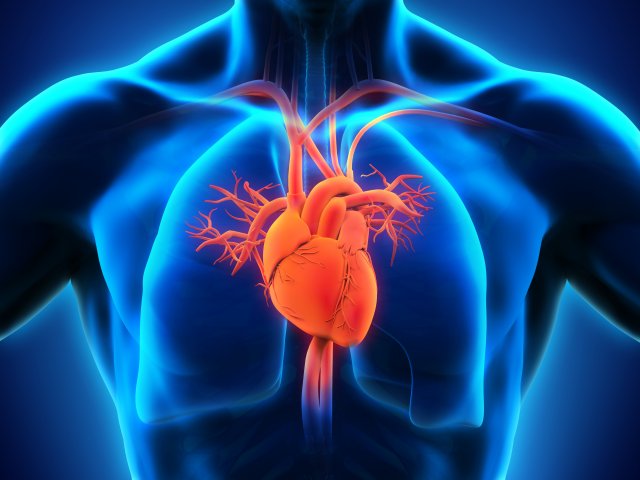
Decades of research have shown that air pollutants such as ozone and particulate matter (PM) increase the amount and seriousness of lung and heart disease and other health problems. More investigation is needed to further understand the role poor air quality plays in causing detrimental effects to health and increased disease, especially in vulnerable populations. Children, the elderly, and people living in areas with high levels of air pollution are especially susceptible.
Results from these investigations are used to support the nation's air quality standards under the Clean Air Act and contribute to improvements in public health.
On this page:
Health Effects of Air Pollutants on Vulnerable Populations
Long-term and short-term effects from exposure to air pollutants.
- Multipollutant Exposures and Changes in Environmental Conditions
- Leveraging Big Data for Innovations in Health Science
Health Effects of Wildfire Smoke
Public health intervention and communications strategies, integrated science assessments for air pollutants.

Research has shown that some people are more susceptible than others to air pollutants. These groups include children, pregnant women, older adults, and individuals with pre-existing heart and lung disease. People in low socioeconomic neighborhoods and communities may be more vulnerable to air pollution because of many factors. Proximity to industrial sources of air pollution, underlying health problems, poor nutrition, stress, and other factors can contribute to increased health impacts in these communities.
There is a need for greater understanding of the factors that may influence whether a population or age group is at increased risk of health effects from air pollution. In addition, advances to analytical approaches used to study the health effects from air pollution will improve exposure estimates for healthy and at-risk groups.
The research by EPA scientists and others inform the required reviews of the primary National Ambient Air Quality Standards (NAAQS), which is done with the development of Integrated Science Assessments (ISAs). These ISAs are mandated by Congress every five years to assess the current state of the science on criteria air pollutants and determine if the standards provide adequate protection to public health.
Research is focused on addressing four areas:
- Identifying and characterizing whether there are key reproductive factors and critical stages of development that are impacted by air pollution exposures;
- Determining the role of acute and chronic sociodemographic factors in air pollution health disparities;
- Understanding how diet modifies responses to air pollution;
- Evaluating long-term lifestyle and chronic disease effects on air pollution-induced respiratory and cardiovascular responses
A multi-disciplinary team of investigators is coordinating epidemiological, human observational, and basic toxicological research to assess the effects of air pollution in at-risk populations and develop strategies to protect these populations, particularly those with pre-existing disease. The results from these products will improve risk assessments by clarifying the role of modifying factors such as psychosocial stress (e.g. noise) and diet, and determining the impact of individual susceptibility on the relationship between air pollutant exposures and health.
Related Links
- Healthy Heart Research
- Integrated Science Assessments
- Criteria Air Pollutants
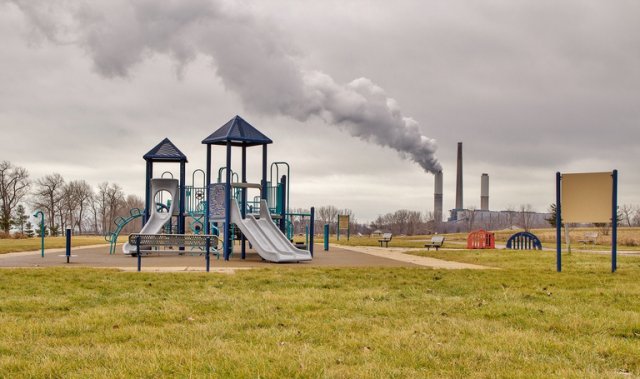
People can experience exposure to varying concentrations of air pollution. Poor air quality can impact individuals for a short period of time during the day, or more frequently during a given day. Exposure to pollutants can also occur over multiple days, weeks or months due to seasonal air pollution, such as increased ozone during the summer or particulate matter from woodstoves during the winter.
The health impact of air pollution exposure depends on the duration and concentrations, and the health status of the affected populations. Studies are needed to increase knowledge of the exposure duration and the possible cumulative increase in risk.
The research is focused on three main areas:
- Short-term peak exposures, such as wildfires, traffic-related sources, or other episodic events;
- Intermittent and cumulative exposures;
- Mechanisms underlying the exposure risks
Researchers are evaluating the health responses of intermittent multiple days versus one-day air pollution exposure in controlled human exposure, animal, and in vitro models and associated cellular and molecular mechanisms. They are employing population-based models and electronic health records to assess the health effects of short-term and long-term exposures and identifying populations at greatest risk of health effects. The work is improving our understanding of the possible cumulative effects of multiple short-term peak exposures and the relationship of these exposures to longer-term exposures and risks.
Multipollutant Exposures and Changes in Environmental Conditions

EPA research is providing information to understand how individuals may respond to two or more pollutants or mixtures and how environmental conditions may impact air quality. While risk estimates for exposure to individual criteria air pollutants such as PM and ozone are well established, the acute and cumulative effects of combinations of pollutants is not well understood. In addition, research is needed to determine how changes in the environment affect both pollutant formation and subsequent responsiveness to exposures in healthy and susceptible individuals.
The research is focused on three specific questions:
- What is the role of temperature and photochemical aging on the health impact of wildfire smoke and air pollution mixtures?
- What is the effect of changing environmental conditions (i.e., temperature and humidity) on responsiveness to air pollution?
- Does prior pollutant exposure modify responsiveness to subsequent exposures?
The integrated, multi-disciplinary research includes:
- Epidemiologic analyses of environmental influences on morbidity and mortality in populations,
- Simulations of changing environmental conditions in multi-pollutant formation in atmospheric chamber studies coupled with clinical and toxicological assessments in healthy and at-risk populations,
- Evaluation of pre-exposure as a modifying effect on subsequent exposures
The results are revealing how changes in environmental conditions affect pollutant formation and subsequent health impact in at-risk populations. The research findings are informing EPA’s Integrated Science Assessments for criteria air pollutants and assisting with future regulatory decisions on the National Ambient Air Quality Standards (NAAQS).
Leveraging Big Data for Innovations in Health Science

EPA is at the cutting edge of health science, using electronic health records, novel data systems, tissue-like advanced cellular models, molecular approaches, and animal models to evaluate the health impacts of air pollution. Researchers are using these powerful new techniques to identify factors that may increase sensitivity and vulnerability to air pollution effects.
The research is building capacity for future risk assessment and regulatory analyses that go beyond traditional lines of evidence to more clearly define populations and lifestages at increased risk of health effects from air pollution.
To continue to protect public health from poor air quality, researchers must consider new epidemiological, toxicological and clinical approaches to understand the health risks of poor air quality and the biological mechanisms responsible for these risks. At the center of these new research approaches is an explosion of data availability and methodological approaches for handling large clinical and molecular datasets, also known as "big data."
While data of increasing size, depth, and complexity have accelerated research for many industries and scientific fields, big data is sometimes less recognized for the impacts it is having on environmental health studies. Increasingly, researchers are able to examine vulnerable populations with unprecedented precision and detail while also evaluating hundreds of thousands of molecular biomarkers in order to understand biological mechanisms associated with exposure.
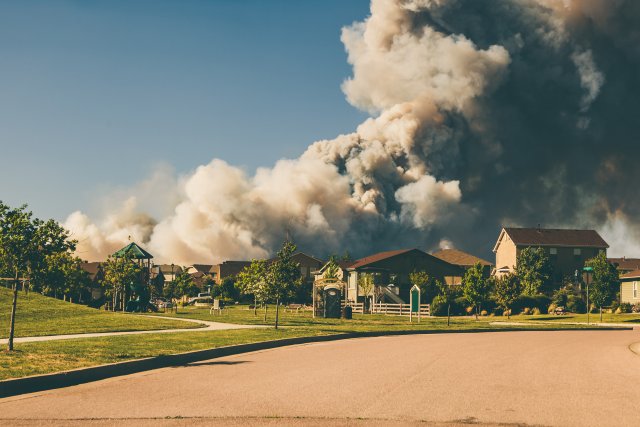
Larger and more intense wildfires are creating the potential for greater smoke production and chronic exposures in the United States, particularly in the West. Wildfires increase air pollution in surrounding areas and can affect regional air quality.
The health effects of wildfire smoke can range from eye and respiratory tract irritation to more serious disorders, including reduced lung function, exacerbation of asthma and heart failure, and premature death. Children, pregnant women, and the elderly are especially vulnerable to smoke exposure. Emissions from wildfires are known to cause increased visits to hospitals and clinics by those exposed to smoke.
It is important to more fully understand the human health effects associated with short- and long-term exposures to smoke from wildfires as well as prescribed fires, together referred to as wildland fires. EPA is conducting research to advance understanding of the health effects from different types of fires as well as combustion phases. Researchers want to know:
- What is the full extent of health effects from smoke exposure?
- Who is most at risk?
- Are there differences in health effects from different wildfire fuel types or combustion phases (burning versus flaming)?
- What strategies and approaches are most effective in protecting public health?
- What are the environmental, social and economic impacts of wildfire emissions?
- Wildland Fire Research
- Smoke-Ready Toolbox for Wildfires
- Smoke Sense Project and App

Many communities throughout the United States face challenges in providing advice to residents about how best to protect their health when they are exposed to elevated concentrations of air pollutants from motor vehicle and industrial emissions and other sources of combustion, including wildland fire smoke.
Researchers are studying intervention strategies to reduce the health impacts from exposure to air pollution as well as ways to effectively communicate these health risks. To translate the science for use in public health communication and community empowerment, EPA is collaborating with other federal agencies, such as the Centers for Disease Control and Prevention (CDC) and the National Heart, Lung, and Blood Institute (NHLBI), and state and local agencies and tribes. The objectives are to identify ways to lower air pollution exposure or mitigate the biological responses at individual, community or ecosystem levels, and ultimately evaluate whether such interventions have benefits as measured by indicators of health, well-being or economics.
Studies are evaluating the interactions between behavior and social and economic factors to more thoroughly understand how these factors may influence health and well-being outcomes, which can inform effective and consistent health risk messaging.
- Healthy Heart Initiative and Research
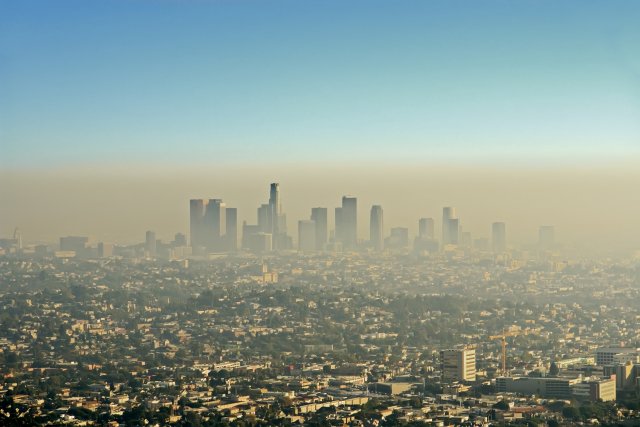
EPA sets National Ambient Air Quality Standards (NAAQS) for six principal criteria air pollutants —nitrogen oxides, sulfur oxides, particulate matter, carbon monoxide, ozone and lead—all of which have been shown to be harmful to public health and the environment.
The Agency’s Integrated Science Assessments (ISAs) form the scientific foundation for the review of the NAAQS standards by providing the primary (human health-based) assessments and secondary (welfare-based, e.g. ecology, visibility, materials) assessments. The ISAs are assessments of the state of the science on the criteria pollutants. They are conducted as mandated under the Clean Air Act.
- Air Research Home
- Air Monitoring & Emissions
- Air Quality Modeling
- Wildland Fires
- Health Effects from Air Pollution
- Air & Energy
- Outreach, Tools & Resources

Environmental Science and Pollution Research
Environmental Science and Pollution Research (ESPR) serves the international community in all broad areas of environmental science and related subjects with emphasis on chemical compounds.
- Covers all areas of Environmental Science and related subjects.
- Publishes on the natural sciences, but also includes the impacts of legislation, regulation, and the economy on pollution control.
- Safeguards international and interdisciplinary character through a global network of editorial board members.
- Official publication of the EuCheMS Division of Chemistry and the Environment.
- Authors from participating institutions can publish Open Choice at no cost.
- Philippe Garrigues
Societies and partnerships
Latest issue
Volume 31, Issue 16
Latest articles
Influences of tobacco straw return with lime on microbial community structure of tobacco-planting soil and tobacco leaf quality.
- Chaoqiang Jiang
- Chaolong Zu

Structural simulation and performance evaluation of a novel synthesized ZIF in the adsorption of MO from aqueous solutions
- Vida Ravankhah
- Sohrab Fathi

Predictors of quitting smoking behavior: evidence from Pakistan
- Assad Ullah Khan
- Sareer Ahmad

Nanocellulose-stabilized nanocomposites for effective Hg(II) removal and detection: a comprehensive review
- Karthik Chinnappa
- Caroline Dharmaraj Glory Bai
- Pandi Prabha Srinivasan

Health risk assessment of heavy metal pollutants in Iranian hen eggs: a systematic review and meta-analysis
- Fatemeh Esfarjani
- Abdolsamad Abedi
- Fatemeh Mohammadi-Nasrabadi

Journal updates
Meet the editors.
Learn more about the ESPR editors!
Special Issues
We invite you to browse through recently published special issues of Environmental Science and Pollution Research: Click here to get an overview of ESPR issues! All manuscripts will be peer reviewed as usual and following the journal's policies , with final decisions made by the Editor-in-Chief.
Special Issue Proposal Form
Call for Papers: Special Issue on Integrating Geospatial Intelligence and Machine Learning for Smart Environmental Monitoring and Management (IGIML23)
Journal information.
- Astrophysics Data System (ADS)
- Biological Abstracts
- CAB Abstracts
- Chemical Abstracts Service (CAS)
- Current Contents/Agriculture, Biology & Environmental Sciences
- Engineering Village – GEOBASE
- Google Scholar
- INIS Atomindex
- Japanese Science and Technology Agency (JST)
- OCLC WorldCat Discovery Service
- Science Citation Index Expanded (SCIE)
- Semantic Scholar
- TD Net Discovery Service
- UGC-CARE List (India)
Rights and permissions
Springer policies
© Springer-Verlag GmbH Germany, part of Springer Nature
- Find a journal
- Publish with us
- Track your research

We apologize for the inconvenience...
To ensure we keep this website safe, please can you confirm you are a human by ticking the box below.
If you are unable to complete the above request please contact us using the below link, providing a screenshot of your experience.
https://ioppublishing.org/contacts/
- Frontiers in Earth Science
- Geochemistry
- Research Topics
Environment and Health
Total Downloads
Total Views and Downloads
About this Research Topic
Environment and Health includes research articles dealing with innovative investigations and modern approaches on environmental pollution and its potential interference with ecosystems and human health. The Research Topic is primarily focused on the study of interactions, pathways and transfer of pollutants ...
Keywords : Environment, Human Health Safety, Ecosystem Health, Pollution
Important Note : All contributions to this Research Topic must be within the scope of the section and journal to which they are submitted, as defined in their mission statements. Frontiers reserves the right to guide an out-of-scope manuscript to a more suitable section or journal at any stage of peer review.
Topic Editors
Topic coordinators, recent articles, submission deadlines.
Submission closed.
Participating Journals
Total views.
- Demographics
No records found
total views article views downloads topic views
Top countries
Top referring sites, about frontiers research topics.
With their unique mixes of varied contributions from Original Research to Review Articles, Research Topics unify the most influential researchers, the latest key findings and historical advances in a hot research area! Find out more on how to host your own Frontiers Research Topic or contribute to one as an author.
261 Pollution Essay Topics & Essay Examples
The problem of environmental pollution is one of the main subjects for discussion worldwide. Manufacturing, carbon emissions, plastic, etc., have an adverse impact on air, water, and soil entire the world. That is why it is crucial to understand the problem and develop solutions to mitigate our negative effects on Earth.
In this article, you will find interesting research questions about pollution, ideas for your argumentative and persuasive papers, and essay examples to inspire.
Keep reading!
💡 8 Tips for Writing Essays on Pollution
🏆 best pollution topic ideas & essay examples, 🥇 captivating pollution research topics, 🌩️ shocking pollution essay examples and topic ideas, 🎓 simple & easy topics related to pollution, ✅ most interesting pollution topics to write about, ✍️ pollution essay topics for college, ❓ research questions about pollution.
There is a rising interest in ecological awareness and an overall building desire to move towards sustainable living within society. Thus, a pollution essay requires much more than merely outlining cause and effect occurrences.
Tackling a topic that should be both conscientious and demanding may be a difficult task, but with these few tips below, you can quickly address all pollution essay topics. Here are some ideas on how to make your assigned essay more comfortable to write:
Do your research beforehand. This action will help you start your bibliography, which you should begin by writing down every book and article you hope to use.
Additionally, doing so will help you better understand your subject and be more comfortable writing about it. Readers can always feel when writers are too vague because they want to avoid some aspects of a problem.
Introduce your issue from a historical viewpoint. You should explain the origin of your problem, outlining what changes began affecting the environment and why.
Doing so not only allows engaging your readers but also prevents needlessly confusing them by being evasive about your subject.
If some key terms and processes are not common knowledge, then you should explain them. Topics on pollution have tricky terminology, and you should allow your readers to read your essay while on the same level of knowledge as you.
For example, if you are writing about air pollution, then the terms you use may range from “particulate matter” to “hygroscopicity,” depending on the complexity of your essay’s subject.
The pollution essay thesis statement is a guiding line throughout your writing process. Every sentence you write should relate to your central argument and help advance it forward.
From when you start outlining until you write your conclusion and even when revising your draft, you should always ask yourself whether your writing helps you uphold your thesis.
Use credible sources to support your writing. Book and journal titles, research papers, and even interviews with respected scientists are good examples of what you should include in a bibliography.
You may also use pollution essay quotations to demonstrate scientists’ opinions or statistical numbers. When you reference your facts, your readers trust your writing and accept it as credible and truthful, as well as show a good understanding of the subject.
Give your essay an appropriate heading. Your pollution essay titles should clue your readers in on your argument. Using a “talking” title, which explains your subject at a glance, is a useful way of making your essay stand out among others.
If your subject ties together different issues, then you should think about using subheadings to make your essay more readable.
For example, when writing about nonpoint source pollution, you may need to mention its effects on both ocean and forest environments.
Doing so in different sections of your essay may help you structure your thoughts and bring together your arguments for a well-written conclusion.
Read sample essays written by others to help you understand your subject and essay structure better. Doing so will help you be consistent with your chosen citation style and immerse yourself in your research.
However, do not commit an academic offense by plagiarizing from the work of others.
Need more tips? Want to read an essay example? Visit IvyPanda!
- Water Pollution: Causes, Effects and Possible Solutions This is why clean water is required in all the places to make sure the people and all the living creatures in the planet live a good and healthy life.
- Air and Water Pollution in the Modern World The high number of vehicles in the city has greatly promoted air pollution in the area. Poor sewerage system, high pollution from industries and automobiles are among the major causes of air and water pollutions […]
- How to Protect the Egypt Nile River From Pollution? The secret to the overflowing waters of the Nile is linked to the five months in a year of rain experienced in Ethiopia.
- Water Pollution: Causes, Effects, and Prevention Farmers should be encouraged to embrace this kind of farming which ensures that the manure used is biodegradable and do not end up accumulating in the water bodies once they are washed off by floods.
- Pollution Caused by Transportation The growth of consignment and travelers’ mobility is associated with the rise of negative impacts of transportation through pollutants. Additionally, the pollutants can be related to fuels’ refining and distribution as well as manufacturing and […]
- Garbage Pollution Electronic waste can also be recycled and refurbished.’Reduce’, ‘Reuse’ and ‘Recycle’ are the 3Rs that go a long way in handling the issue of garbage.
- Noise Pollution: Effects, Causes, and Potential Solutions According to the International Program on Chemical Safety, “an adverse effect of noise is defined as a change in the morphology and physiology of organism that results in an impairment of functional capacity, or an […]
- The Impact of Groundwater Pollution on Agriculture and Its Prevention People have to be aware about the impact of their activities on groundwater and be able to improve the conditions, they live under, and this piece of writing will inform each reader about each detail […]
- Ocean Pollution and the Fishing Industry In essence, the activities of over six billion people in the world are threatening the survival and quality of water found in the oceans, lakes and other inland water catchment areas.
- Water Pollution in the Philippines: Metropolitan Manila Area In this brief economic analysis of water pollution in Metro Manila, it is proposed to look at the industrial use of waters and the household use to understand the impact that the population growth and […]
- Environmental Pollution and Its Effect on Health In climate change, due to air pollution, the main force to prevent environmental disasters need to change the approach to the production of substances from fossil fuels.
- Cultural Pollution:Traditions and Historical Concepts The cultures traditions and historical concepts of the Middle East have over the centuries been characterised as by a distinct sense of variety that stems from a whirlwind of customs and traditions.
- Environmental Pollution: Causes and Solutions The consequences that have risen as a result of neglecting to take care of the environment have now become a reality to the whole of mankind.
- Air Travel as a Cause of Severe Pollution Ecologists cite the growth of air travel as one of the factors that are contributing to environmental pollution. Restricting air transport can minimize the amount of noise that airplanes make, therefore improving the quality of […]
- Coca-Cola India and Water Pollution Issues The first difficulty that the representatives of the Coca-Cola Company happened to face due to their campaign in the territory of India was caused by the concerns of the local government.
- Air Pollution and Its Impact on Human Health Community needs assessment is a systematic process in which the health educator, the nurse and other health care professionals together with the members of the community determine the health problems & needs of the community […]
- The Problem of Ocean Pollution in Modern World Wastes such as toxic matter, plastics, and human wastes are some of the major sources of pollution in the ocean. Many people consume fish as food; when marine life is affected by toxic substance in […]
- Pollution as a Big Problem That Faces the World Pollution is human made, pausing devastating health issues among the community at large, and its management cuts across all spectrums of societies including cultural, political, ethnic, and educational backgrounds Various forms of pollution have contributed […]
- Car Air Pollution Further, NO2 can prevent the flow of oxygen in the blood to other parts of the body like the brain. These toxic substances settle in the lungs and disrupt the normal flow of air in […]
- Nurse Associate’s Role in Air Pollution Prevention This paper analyzes current health promotion strategies in Somerset and the United Kingdom, obstacles to preventative health strategies, health screening programs, the impact of psycho-social, economic, and behavioral factors, epidemiology and genomics, vaccination and immunization […]
- Air Pollution Impacts on Weather and Climate Air pollution is rated to be the major cause of discomfort in the living creatures of the world for air is essential for the survival of every living creature.
- The World Oceans Pollution and Overfishing Human beings have taken a lot of time to realize the need for ocean conservation to the extent that the ocean has succumbed to ecological challenges that have affected their lives in a variety of […]
- Hudson River Pollution Concerns Unfortunately, the Industrial Revolution and the subsequent advancement of the local and national economy have turned the River into an object of environmental pollution.
- The Effects of Noise Pollution Noise pollution meaning When speaking about the effects of noise pollution, it is necessary to highlight some fundamentals of the issue.
- Environmental Pollution: Causes and Consequences The essay will provide an overview of pollution and proffer solutions to combating pollution for a sustainable environment and health. Preventing pollution lowers the cost to the environment and the economy.
- Integrated Pollution Prevention and Control Environmental management is dynamic and it is concurrent to the existing management strategies and agenda of the company. Statutes and legislations pertaining to environmental compliance enforce the need to implement environmental management and monitoring of […]
- Smog, Its Harm and Pollution Reduction Progress Smog can be defined as the mixture of solid and liquid fog and smoke particles that are formed under the impact of high humidity and calm air.
- Acid Rain and Ozone Pollution Acid rain and ozone pollution are a form of pollution, which entails the release of gaseous and dust particles in quantities that destroy the integrity of the atmosphere and affect organisms in their respective habitats […]
- The Ocean Pollution Problem Overview Ocean pollution is the unfavorable upshot due to the entrance of chemicals and particulate substances into the ocean. The land is the key source of ocean pollution in the form of non-point water pollution.
- Plastic Pollution From a Sociological Standpoint Wagner, as well as Miranda and de Carvalho-Souza, are in favor of increased recycling efforts to prevent more plastic from escaping into the sea.
- Air Pollution in Beijing and Its Effects on Society It is worth noting that different regions/countries/cities in the world have different levels of air pollution depending on the intensity/presence of causing agents and the techniques applied in dealing with air pollution.
- Cashion Water Quality: Spatial Distribution of Water Pollution Incidents This essay discusses the quality of water as per the report of 2021 obtained from the municipality, the quality issue and the source of pollution, and how the pollution impacts human health and the environment […]
- Environmental Factors and Health Promotion: Indoor and Outdoor Air Pollution This presentation offers some information about the damage of air pollution and presents a health promotion plan with helpful resources and evidence from research.
- Noise and Sound Pollution The noise pollution should be considered by the duration of the sound, the frequency of noise, and whether there is any control to the sound or not.
- Water Pollution: OIL Spills Aspects The effects of the oil spill on a species of ducks called the Harlequin ducks were formulated and the author attempted to trace out the immediate and residual effects of the oil on the birds.
- American Society on Health and Pollution’s Activity The organization is purposed to inspire newly elected leaders to act as examples and lead the way in the promotion of a green economy that is sustainable for all American citizens.
- Importance of Mercury Water Pollution Problem Solutions The severity of the mercury contamination consequences depends on the age of the person exposed to the contamination, the way of contamination, the health condition, and many other factors.
- Reducing Traffic Noise Pollution in Cairo In conclusion, it seems reasonable to state that the issue of traffic noise pollution is rapidly growing in Egypt’s capital Cairo and increasingly impacts public health.
- Technological Applications in Industrial Pollution Prevention I also understand that pollution prevention emerged from the need to protect the environment from degradation and that appropriate regulations require manufacturers to put in place measures to prevent the release of dangerous emissions.
- Pollution and Neglect in America During his stay in Ohio, he is realizing an increase in challenges, which he attributes to neglect by the members of the society.
- Environmental Pollution and Increased Birds Death The increase in the population of different animals may also cause the death of birds. This leads to the extinction of some animals and birds hence massive death.
- Air Pollution in Beijing and the Decision-Making Bias Severe air pollution in Beijing did not become a subject of worldwide concern and discussion until the 2008 Beijing Olympics, which brought the issue to the attention of the global public due to the immense […]
- Smog and Air Pollution in Los Angeles The city is often covered with a yellow veil in the sky, so the problem of smog is an actual problem of the state.
- Graveyard Ship Pollution in Kuwait The main legal issue of this case is the collision of two ships that led to the killing of millions of people and the dumping of waste along the sea.
- Environmental Pollution and Human Health The effects of sprawl on health workers are discussed in the article by Pohanka. It is similarly essential to take social justice and fairness into account because the effects of sprawl on population health are […]
- The Ecogeographical Impact of Air Pollution The weakness of the text is that the safety of NPs and their probable toxic effects on human health and the environment are not evaluated.
- Water Pollution as a Crime Against the Environment In particular, water pollution is a widespread crime against the environment, even though it is a severe felony that can result in harm to many people and vast territories.
- Carbon Offsets: Combatting Environmental Pollution I think that using other organizations or projects to offset an entity’s carbon footprint avoids the main goal of any present environmental protection efforts sustainability.
- Environmental Pollution: Waste Landfilling and Open Dumping The solution is simple and practical it is necessary to put efforts into further development of hard industries and stop financing the research of the issue that is useless.
- Air Pollution and Impact of Transportation Emissions of greenhouse gases, air pollution, the release of ballast water, aquatic invasive species, and oil and chemical leaks are only some of the environmental problems that marine transportation continues to cause.
- Pollution and Respiratory Disease in Louisiana The United States of America is an industrial powerhouse, a powerful nation that devoted much of its time to the growth and development of the petrochemical industry.
- Beat Plastic Pollution Essay These tips will help people to reduce the circulation of plastic in their lives. In conclusion, the best method to protect the environment is to minimize the accumulation of plastic waste by recycling, composting, and […]
- Air Pollution and Lung Disease To design a study in order to explore the link between lung disease and air pollution, it would be possible to follow a four-step process started by identifying the level or unit of analysis.
- Environmental Justice: Pollution However, the issue of environmental racism transcends national boundaries and is likely to be repeated in other regions of the world.
- Air Pollution in China: Atmospheric Chemistry and Physics One of the most acute environmental problems in China is air pollution, which the authorities are trying to solve, but still, many people, factories, and active processes of globalization do not allow environmental programs to […]
- CSR Initiatives in Reducing Pollution and Carbon Emissions in GCC The purpose of this paper is to conduct a literature review evaluating the impact of CSR initiatives in reducing pollution and carbon emissions in GCC and the Middle East.
- The Negative Impact of Soil Pollution The picture does not show where the water is coming from, and that is how to determine whether the pollution is from a non-point source.
- Algae Explosion and Nitrogen Pollution in Lakes One of the most problematic aspects of nitrogen pollution as a form of nutrient pollution in lakes is the algae explosion.
- A Pollution Concern in the Anacostia River In addition, the unending sedimentation affected the river’s ecosystem due to the lack of sunshine, especially at the bottom of the river.
- Air Pollution and Child Health Conducting research, leading scholars, and summarizing the results of their efforts allowed the organization to investigate the numerous ways air pollution damages the human body.
- Environmental Protection: Pollution and Fossil Fuels The term used to describe a combination of oil and petroleum-related businesses, fossil fuel has been continuously cited as being dangerous for the planet.
- Issue of Pollution of Everest A policy that can be put in place by Nepal to address the current state of pollution on Everest is limiting the number of climbers to the mountain. The increase in the number of people […]
- The Impact of Atmospheric Pollution on Human Health and the Environment Atmospheric pollution is a set of environmental problems associated with releasing chemicals and accumulating concentrations of natural gases in the air.
- Air Pollution and Vulnerability to Covid-19 In other words, the findings will be used as one of the key arguments for showing that air pollution is detrimental to both individual and societal health.
- Poor Waste Disposal and Pollution in California For instance, the rapid increase in the number of factories and industries in California has led to more waste products in the state.
- Technical Report Pollution in Cities of Trinidad Many people who live in the environment close to the dumping sites are exposed to the daily combustion of the refuse, coupled with the inhalation of the emissions from the combusted material.
- Cultural Pollution in the Middle East The importance of the cultural patriarchal society suffers the whims of the feminist movement that has underscored the cultural values and roles of women.
- Fundamentals of Air Pollution The components of secondary air pollution include ozone and nitrogen oxides. Smog occurs when “car exhausts are exposed to direct sunlight”.
- The Reduction of Agricultural Nutrient Pollution: Possible Solutions The nutrients that are contained in fertilizer or manure may reach water basins and cause a dramatic increase in the populations of phytoplankton and algae.
- The Perspectives of Pollution for International Business Turning to the society’s role in changing the unsustainable system, the most important part of the discussion is usually dedicated to the role-changing possibility in the governmental structure.
- Pollution Problem: Sewage Spills in San Jose Water is a crucial element for all known forms of life to be able to live. Groundwater quality is essential for human consumption and social and economic activities.
- Equipment to Monitor Pollution Emissions In assessing the situation, the vital aspects are: the quality of the decision, the commitment of the subordinates, the knowledge of the leader, the structure of the problem, the probability of subordinates’ commitment, sharing the […]
- Global Plastic Pollution Problem and Its Drivers The primary challenge is the production and use of plastic products, which overwhelm the environment’s capacity to withstand. It cannot be burned because of air contamination, and the process of recycling equally results in plastic […]
- Plastic Pollution and Its Consequences Water in vapor form is also a product of combusted carbon-rich molecules and forms part of the hydrosphere from where it is absorbed into the biosphere.
- Newark Water Crisis: Water Pollution Problem The main problem was rooted in the fact that lead levels in the drinking water were highly elevated, which is dangerous and detrimental to the population’s health.
- Pollution Caused by Plastic Materials However, it is important to note that regardless of the many pleasant and appealing uses of plastics, the numerous health problems and dangers presented to the environment are gruesome.
- Pollution and Illegal Dumping in Chilliwack River Chilliwack River Watershed maintenance is under great pressure because of differing use of resources and activity, high demands for growth and recreation, and impacts to quality of water and riparian habitation from different water-use and […]
- Simply Green Products Firm: Pollution Allegations The natural decomposition is the surety that the company to the environmentalist organizations and the citizens. There is considerable proof that the company has been the primary producer of the packaging materials for the orchards […]
- Atmospheric Pollution Constituents A department dealing with the effects of atmospheric pollutants in the vicinity of an industrial complex has established a data table of measurements of a purity index Y on a scale of 0 to 1000 […]
- Air Pollution: The Problem’ Review Indoor pollution and related conditions are a big burden to the already suffering world according to the reports of the world health organization that it’s the 8th most important risk factor and is perceived to […]
- Law, Property Rights, and Air Pollution In the law of torts, ‘harm’ is considered when there is physical invasion to a person there fore in the case there was no violation of this law as the secretary was not harmed by […]
- Air Pollution in Middle East: Saudi Arabia The rate of air pollution in the world has increased gradually since the advent of the industrial revolution in the early 1800s.
- Global Pollution and Climate Change Both of these works address the topic of Global pollution, Global warming, and Climate change, which are relevant to the current situation in the world.
- Health Science: Pollution and Health The spill was apparently a result of the containing dam wall being weak and the ensuing heavy rains rapidly increased the volume of the contents resulting in breaking of the reservoir.
- Point vs. Non-Point Air Pollution To determine the air pollution source of a large smoke stack, one has to assess the physical characteristics of the smoke; description of the color concentration intensity is it grey or extremely dark?
- Noise Pollution: Best Practicable Means Magistrates’ Court identified Statutory Nuisance in the case and forwarded an abatement order against respondents along with a huge fine for their misconduct that led to noise pollution.
- Public Policy Issue: Particle Pollution in Chicago Metropolitan Area The Chicago metropolitan area has been mentioned quite a number of times in American Lung Association’s State of the Air 2008, an annual report that grades the quality of the air across the different cities […]
- Noise Pollution: Environmental Issue in Lagos, Nigeria The aim of the study would be to understand and evaluate the amount of noise pollution in Lagos, Nigeria and its affects on public health.
- Air Pollution and Health Issues in the US The industry of health care is closely connected to the industrial activities sector, which has the largest impact on the atmosphere through polluting the air, soil, and waters.
- Thames Water Company’s Pollution Issue and Ecocentrism Fines can be treated as a strong solution to this issue even though it is not presupposed by the ethical theory discussed, as they ensure that some funds can be spent on protecting the environment.
- Air Pollution Externalities and Possible Solutions In order to fully integrate public utility, power generation, policy and use of nuclear power in light of the growing concerns on the depletion of natural forms of energy as well as degradation of the […]
- Industrial Pollution in China and USA The pollution of world’s environment with industrial wastes is highly intensified and according to the authors’ opinion the scientific approach is the most significant and useful tool for the purpose of quick resolving of this […]
- Air Pollution and Ecological Perspectives of the Atmosphere The major contributors to CO2, one of the main pollutants in the atmosphere, are the burning of fossil fuels and deforestation.
- Pollution Is a Consistent Demolition of the Earth Pollution means the introduction into the environment of substances or energy that is liable to cause hazards to human health, harm to living resources and ecological systems, damage to structure or interfere with the legitimate […]
- Air Pollution and Its World History From the times of industrial revolution, smoke pollution was a concern and continues to be one with vehicles and industries replacing coal and wood.
- Water Pollution in a Community: Mitigation Plan Though for the fact that planet earth is abundant with water and almost two-thirds of the planet is made up of water still it is viewed that in future years, a shortage of water may […]
- The Influence of Global Warming and Pollution on the Environment This essay is going to address global warming from a psychological point of view with an emphasis on the psychological and social reasons that make it important to tackle this problem which is threatening the […]
- Atmospheric Chemistry – Pollution Ozone, a photochemical pollutant, is formed by the oxidation of explosive organic compounds in the presence of sunlight and oxides of nitrogen in the atmosphere.
- Construction Technology and Air Pollution Hot-list section has new and transferable technology and highlights the features that appeal to construction companies, specifies and designers, owners of the building and end users.
- As China Roars, Pollution Reaches Deadly Extremes The idea is to harness the excess waters of the Yangtze River to replenish the Yellow River which perennially suffers from lack of water and the formation of silt.
- Pollution Control Policy: Glodal Issues Global warming poses a great problem for the global biosphere since it affects the habitat of most of the natural occupants of the global hemisphere.
- Earth’s Atmosphere and Natural Pollution The stratosphere is the next layer of the atmosphere and is from that 7 17 km range to about 30 km above the earth’s surface.
- Atmospheric Pollution and Global Warming Green forests help in soaking the suspended particles in the air and thus clean the air for all of us to breathe.
- Recurrent Pollution of the Tisza River of Hungary The Tisza basin is located almost precisely in the geographical center of Europe and crosses the near-future boundary of the European Union.
- Marine Pollution: Management and International Legislation Marine environment refers to: the physical, chemical, geological and biological components, conditions and factors which interact and determine the productivity of, state, condition and quality of the marine ecosystem, the waters of the seas and […]
- Marine Pollution: Sources, Types, Pathways, and Status By examining sources, types, pathways, and status of water contamination in the context of the World Ocean, it is clear that most marine pollution caused by human actions, especially the mismanagement of plastic debris.
- The Public Perceptions of Air Pollution and Related Policies in London The primary questions for consideration are the public perceptions of air pollution and related policies in London and other cities of the United Kingdom, previous surveys regarding existing policies related to the environment or air […]
- Concerns of Ocean Ecosystem Pollution The range of adverse outcomes for ocean ecosystems can be discussed in volumes; however, the current discussion will focus on trash in the ocean waters, acidification, and the disruption of the marine life cycles.
- Food Distribution and Water Pollution Therefore, food distribution is one of the central reasons for water pollution. According to Greenpeace, one of the ways to improve the ecology of the planet is by creating healthy food markets.
- How China Cuts Its Air Pollution 5, which is the smallest and one of the most harmful polluting particles, were 54 percent lower in the last quarter of 2017 as compared to the same period in 2016, specifically in Beijing.
- Haze Pollution in China One of the outstanding aspects of pollution in the country is that the Chinese are highly desensitized and aware of issues surrounding this matter.
- Pollution and Federal Environmental Policy Pollution continues to influence the flora and the fauna of the United States, as well as people in urban and even rural areas.
- Plastic Pollution and Social Institutions The purpose of this paper is to investigate the political and economic barriers that hamper the efforts to reduce plastic pollution and discuss the ways in how they could be overcome.
- Social Activism Against Plastic Pollution Of the 30 million tons of plastic waste in the United States in 2009, only 7% were sent for recycling, which primarily damages marine life.
- Climate Change: Reducing Industrial Air Pollution One of the most effective measures of air quality in the USA is the Air Quality Index, which estimates air conditions by concentrations of such pollutants as particle solution, nitrogen and sulfur dioxide, carbon monoxide, […]
- Pollution as a Social Issue and Mass Media’s Role The reason why plastic pollution gained traction only during the 21st century is directly connected to the invention of the Internet and the technological advances in electronics.
- Environmental Ethics. Optimal Pollution: Reality or Myth? The effects of globalization and environmental change have caused the resurgence of environmentalism, yet the necessity to sustain industries and the global economy invalidates the idea of a pollution-free environment.
- Environmental Pollution and Contamination The rains are known to corrode marble and metals, cause respiratory diseases in human beings and increase the acidity of the soil.
- Low Pollution Car Engine The following is a discussion on the introduction of the low pollution car engine and its benefits to the UAE. In addition, pollution and climate change will be a thing of the past.
- Chemistry: Environmental Pollution in Hungary The acidification of water bodies leads to the death of numerous species that are susceptible to the presence of acid. Part of the problem is caused by the fact that Hungary is currently forced to […]
- Environmental Pollution Analysis The author explains that the damaging alterations have become possible due to the use of a large number of pesticides in the area.
- Coal Pollution in China as an Environmental Problem Thesis: Coal pollution in China has been a significant cause of environmental pollution-China being one of the largest coal producers in the world- therefore, necessitating the development of appropriate measures to reduce its severity.
- Air Pollution, Its Constituents and Health Effects The National Ambient Air Quality Standards are the regulations or policies that are adopted by states to ensure the safety of the environment.
- The Deepwater Horizon Oil Platform Pollution The oil spillage in the sea can result to the death of sea animals as well as plants that thrive in the water because of the dangerous chemicals that are contained in the oil.
- Air Pollution in the United Arab Emirates’ Cities In the article called Evaluating the Potential Impact of Global Warming on the UAE Residential Buildings, the author focuses on the negative consequences of global warming on the situation in the United Arab Emirates.
- Advanced Pollution Prevention in the United States In the United States, the overview of the previous legislation shows that the government used to enforce measures that would deal with pollution control which occurred at the final stage of production processes. The Pollution […]
- Climate Change, Air Pollution, Soil Degradation Then followed by outdoor air pollution, soil degradation which can also be called as soil contamination, global overpopulation, drinking water pollution, nuclear waste build-up, disappearing of the water supplies, indoor air pollution, depletion of the […]
- China Shenhua Energy Company: Pollution Reducing Although the Chinese government recognized the issue of pollution and announced a course for liberalization of the economy and a greater emphasis on ecology during the 12th 5-year plan, the transformation from a coal-based energy […]
- Air Pollution in Washington State and Healthy Living of People The problem of air pollution is closely related to the issue of the energy supply of the US. Due to the high level of air pollution in Washington state, there is a growing threat to […]
- Environmental Pollution in the Petroleum Industry At the same time, it threatens nature and creates many long-term issues related to pollution of air, soil, water, the weakening of the ozone layer, and the facilitation of the greenhouse gas effect.
- Air Pollution as a Factor for Renal Cancer Therefore, to prevent renal cancer, it is crucial to examine the primary causes and look for better strategies to curb the issue.
- Podocnemis Lewyana: Habitat Loss, Overfishing and Pollution The second factor is overhunting, which in the case of Magdalena River Turtle leads to the inability of these animals to locate food.
- Pollution in the San Francisco Bay The rivers provide fresh water for domestic use to many civilians, and it is apparent that the authorities have given the power plant the freedom to test the quantity of chemicals in the waste water.
- Indoor Air Pollution: The Silent Killer in Rural India The video “Indoor air pollution: The silent killer” discusses the detrimental impact of indoor air pollution in rural Indian households on people’s health. The problem of indoor air pollution is rather significant, and people should […]
- Water Pollution and Associated Health Risks The results of plenty of studies indicate the existence of the relation between the contamination of water by hazardous chemicals and the development of respiratory and cardiovascular diseases, cancer, asthma, allergies, as well as reproductive […]
- Air Pollution and China’s Governmental Measures The consequences of air pollution in China are already becoming evident, and not only they are the reason for environmental problems, but also they have a significant influence on the health of Chinese people living […]
- Lake Erie Water Pollution There are worries among the members of the community that the lake could be facing another episode of high toxicity, and they have called for the authorities to investigate the main causes of the pollution […]
- Environmental Pollution and Green Policies Although various scholars are of the view that green technology reduces the level of pollution, adequate research on the use of this form of technology needs to be conducted so as to fully contain environmental […]
- “Fort McMurray Fires Cause Air Pollution” by McDiarmid As a rule, the air in Canada is clean and rich in oxygen; however, when the wildfire burst, it affected the ozone layer to a significant degree.
- Air Pollution as the Trigger of the Ecological Catastrophe The key data collection tool is a survey that is targeted at determining the main factors of air pollution, finding out the social opinion regarding the quality of air in different cities, and estimating the […]
- Agricultural Nutrient Pollution and Its Reduction The solutions that have been proposed for the issue are varied: there is the possibility of upgrading farms with the help of better technologies, controlling the use of fertilizers and waste discharge with the help […]
- Water & Air Pollution and Health Issues in Brazil The main environmental effects of pollution include the destruction of marine habitats, water scarcity, and anoxia. The conclusion is informative because the writer includes strategies to alleviate the problem of air and water pollution in […]
- Air Pollution and Respiratory Illnesses in Nigeria The purpose of the article presented was to test the relationship of the respiratory system illness and air pollution in developing countries, especially in Africa.
- Air Pollution Impact on Children’s Health in the US In these parts of the country, the level of air pollution is much higher. Nevertheless, the growing number of vehicles in the United States contributes to air pollution.
- Traffic-Related Air Pollution and Health Effects It emphasizes the fact that air contamination has a negative influence on the health of the representatives of the general public.
- Nebraska Pollution Prevention Project The article is about Nebraska’s Partners in Pollution Prevention program and the benefits it has brought to the state in the reduction of pollution caused by small businesses.
- Storm Water Pollution Prevention Plan All players need to be trained in significant areas of business so as they can handle them with care and beware of the potential they have in causing damage.
- Water Pollution in the US: Causes and Control Although water pollution can hardly be ceased entirely, the current rates of water pollution can be reduced by resorting to the sustainable principle of water use in both the industrial area and the realm of […]
- Economic View on Water and Pollution Some of the water is found in the continents’ rivers, lakes and in the subsurface. This research tries to explain the importance of water especially in an economist’s perspective by explaining the uses of water […]
- Air Pollution in Los Angeles The escalation of congestion in the city has worsened the problem of air pollution because of the volume of unhealthy air emitted in the atmosphere.
- Noise Pollution: Urban Traffic Noise Besides these two, noise also has an effect on the learning of an individual so that it distracts the individual in a way that s/he is not able to learn, as would be the case […]
- Environmental Revolution: Air Pollution in China For instance, a case study of the current pollution levels in China reveals that the country is struggling with the management of hazy weather.
- Pollution & Climate Change as Environmental Risks
- The Knoxville City’s Environmental Pollution
- Aviation’s Environmental Impact and Pollution
- Environmental Behavior and Air Pollution in Ohio
- Water Pollution and Management in the UAE
- Pollution of the Ganges and Its Main Factors
- Pollution Externalities Role in Management Economics
- Marine Pollution and the Anthropogenic Effects Upon It
- The New York City Air Pollution
- Air Pollution Effects on the Health and Environment
- Dealing With Air Pollution
- Environmental Justice and Air Pollution in Canada
- Environment Destruction: Pollution
- Big Coal and the Natural Environment Pollution
- Principles of Air Pollution Control and Analysis
- New York City Air Pollution Problem
- China’s Air Pollution Problem
- Pollution and Human Health
- Business and Pollution Inequality in Poor States
- China’s Air Pollution Is Not Unique
- Water Pollution and Its Challenges
- An Investigation of Green Roofs to Mitigate Air Pollution With Special Reference to Tehran, Iran
- Air Pollution: Human Influence on Environment
- Kuwait’s Desert Pollution
- Water Pollution Sources, Effects and Control
- Issues in Non-Point Source Pollution
- Air Pollution Sources in Houston
- Pollution Prevention in the Industrial Production
- Pollution Caused by Medium-Sized Enterprises and the Means to Prevent It
- Air Pollution: Public Health Impact
- Solutions to the Los Angeles Metropolitan Watershed Pollution Problem
- Economic Impact of Industrial Pollution in China
- Environmental Impacts of Air Pollution
- Pollution in Beijing, China
- Nitrate and Phosphate Pollution of Freshwater Ecosystem: Sources, Impacts and Cost Effective Measurements
- Automobile Pollution in the US
- Chloramine in Drinking Water: When the Threat of Pollution Emerges
- How Mechanical Engineering Used to Prevent and Fix Oil Pollution
- Technologies for Reduction of Automobile Pollution
- “Water and Pollution” Class Game
- How Bad Pollution Is in the Arab World
- Water in Crisis: Public Health Concerns in Africa
- Does Air Pollution in Schools Influence Student Performance?
- Regulation and Management of Haze Pollution in Canada
- Air Pollution Characteristics and Effect
- Impact of Blowing Drums on Air Pollution
- The System for Pollution Offsets
- The Nature of Nonpoint Pollution Control Problem
- Air and Water Pollution
- Health Hazard of Noise Pollution
- Fossil Fuels Subsidies and the Impact of Pollution on Health and Lifetime Earnings
- Causes of Water Pollution and the Present Environmental Solution
- Water Pollution & Diseases (Undeveloped Nations)
- Environmental Pollution in Canada
- The Impact of Industrial Pollution on the Environment
- Water and Water Pollution in Point of Economics’ View
- Air Pollution Sources, Effects and Ways of Minimizing
- Environmental Justice Issues Affecting African Americans: Water Pollution
- Plastic Ocean Pollution on Ocean Life in U.S.
- Air Pollution Effects on the Health in China
- Air Pollution and Health Policy in China
- The Pollution Within: Foreign Substances in the Human Body
- Air Pollution and Its Consequences
- The Problem of Atmospheric Pollution in Modern World
- Four Marketing Practices That Cause Noise Pollution
- Water Pollution and Wind Energy
- Air Pollution by Automobiles
- Air and Water Pollution in Los Angeles
- Tehran Chokes and Blames Severe Pollution on US Sanctions
- Water Pollution Causes and Climate Impacts
- The Case of PBC Pollution in Hudson River
- Preposition 23: Suspension of Air Pollution Control Act
- Climate and Air Pollution
- Urban Pollution – Many Long Years Ago
- Water Pollution Origins and Ways of Resolving
- Can Pollution Rights Trading Effectively Control Environmental Problems?
- Mud Lick Creek Project – Fresh Water Pollution
- A Discussion of Air Pollution & Related Health Implications on the Community
- Car Pollution in Moscow
- What Causes Air Pollution and What Effect Does It Have on People?
- Why Air Pollution Can Harm the Environment Dramatically?
- What Are the Sources of Air Pollution?
- Does Air Pollution Affect Health and Medical Insurance Cost in the Elderly?
- What Are the Causes and Effects of Water Pollution in Lake Huron?
- What Causes Water Pollution and Its Effects?
- What Can the Public Do to Curb Pollution?
- Will COVID-19 Containment and Treatment Measures Drive Shifts in Marine Litter Pollution?
- Does Inequality Matter Air Pollution and Health Relationship?
- Why Environmental Management May Yield No-Regret Pollution Abatement Options?
- How Can Be Organised Curbing Environmental Pollution Through Recycling?
- What Will the Effects Be if We Don’t Stop Plastic Pollution in Our Oceans?
- Does Air Pollution Crowd Out Foreign Direct Investment Inflows?
- Does Off-Farm Employment Contribute to Agriculture-Based Environmental Pollution?
- Does Environmental Pollution Affect Metropolitan Housing Prices?
- Does Financial Instability Increase Environmental Pollution in Pakistan?
- What Are the Leading Factors of Water Pollution Around the World?
- What King of Cost-Effective Control Strategies for Energy-Related Transboundary Air Pollution in Western Europe?
- Which Firms Are More Sensitive to Public Disclosure Schemes for Pollution Control?
- What Are the Kinds of Water Pollution?
- Does Air Pollution Affect Consumption Behavior?
- What Are the Causes and Effects of Water Pollution?
- Does Animal Feeding Operation Pollution Hurt Public Health?
- Does Industry Self-Regulation Reduce Pollution?
- Will Pollution Free Cars Become a Reality of the Near Future?
- Who Pays for Industrial Pollution Abatement?
- Does Trade Promote Environmental Coordination of Pollution in International Rivers?
- Who Suffers From Indoor Air Pollution?
- What Are the Main Ways to Reduce Pollution?
- What Causes Haze Pollution?
- Chicago (A-D)
- Chicago (N-B)
IvyPanda. (2024, March 2). 261 Pollution Essay Topics & Essay Examples. https://ivypanda.com/essays/topic/pollution-essay-examples/
"261 Pollution Essay Topics & Essay Examples." IvyPanda , 2 Mar. 2024, ivypanda.com/essays/topic/pollution-essay-examples/.
IvyPanda . (2024) '261 Pollution Essay Topics & Essay Examples'. 2 March.
IvyPanda . 2024. "261 Pollution Essay Topics & Essay Examples." March 2, 2024. https://ivypanda.com/essays/topic/pollution-essay-examples/.
1. IvyPanda . "261 Pollution Essay Topics & Essay Examples." March 2, 2024. https://ivypanda.com/essays/topic/pollution-essay-examples/.
Bibliography
IvyPanda . "261 Pollution Essay Topics & Essay Examples." March 2, 2024. https://ivypanda.com/essays/topic/pollution-essay-examples/.
- Noise Pollution Essay Titles
- Air Pollution Research Ideas
- Ocean Pollution Titles
- Global Issues Essay Topics
- Water Pollution Research Topics
- Environmental Protection Titles
- Greenhouse Gases Research Ideas
- Environment Research Topics
- Global Warming Essay Titles
- Climate Change Titles
- Water Issues Research Ideas
- Deforestation Research Ideas
- Hazardous Waste Essay Topics
- Extinction Research Topics
- Environmentalism Essay Topics
- Essay Topic Generator
- Summary Generator
- Thesis Maker Academic
- Sentence Rephraser
- Read My Paper
- Hypothesis Generator
- Cover Page Generator
- Text Compactor
- Essay Scrambler
- Essay Plagiarism Checker
- Hook Generator
- AI Writing Checker
- Notes Maker
- Overnight Essay Writing
- Topic Ideas
- Writing Tips
- Essay Writing (by Genre)
- Essay Writing (by Topic)
409 Environmental Research Topics

With each passing year, environmental issues become a lot more prominent matter. The effects of deforestation, pollution, and global warming have taken their toll on our planet. As a result, humanity has to face climate change, depletion of natural resources, and more related problems. Humans have begun to take steps to repair the damage done to nature. Therefore, nowadays, environmental research is a crucial study area.
On this page, our team has collected current environmental research topics and ideas on related issues. Read through them to find the perfect title for your paper. Also, check a few tips on choosing a research topic that we’ve provided below.
- 🔝 Top 20 Environmental Topics
- 🎒 Topics for High School Students
- 🎓 Topics for College Students
- 🌳 Current Topics on the Environment
- 🔬 Environmental Science Research
- 🍃 Easy Essay Topics
- 🤔 How to Pick a Topic
🔗 References
🔝 top 20 environmental topics to write about.
- Environmental economics and sustainability .
- Oil Exploration Effects on Soil and Underground Water.
- Global warming and the Arctic ecosystem.
- Effects of Climate Change on Agriculture and Food.
- Violations of the environmental law.
- Sustainable Green Building Construction.
- Protection of endangered plant species.
- Environmental Consciousness and Business Sustainability.
- Climate change and its effect on human health .
- Acid Rain Effect on Plant Growth.
- Methods of cleaning the oceans.
- The Global Climate Change as a Manmade Disaster .
- Can we save the environment through education?
- Ecology and Biological Adaptation.
- Earth Day: Global environmental impact.
- Air Pollution and Mortality Rates.
- The ecology of metropolitan cities.
- Environmental Risks: Opposing Views.
- Is overpopulation a myth or reality?
- Water Pollution and Associated Health Risks.
🎒 Environmental Essay Topics for High School Students
- Greenhouse gas emissions connection to climate change.
- Climate change influences on poverty rates.
- Health effects of climate change in third world countries.
- Environmental Damage Because of Oil Spills.
- The economic effects of climate change.
- Possible solutions for climate change.
- Animal Exploitation. Animal Agriculture and Climate Change.
- Connections between capitalistic agriculture and climate change.
- Climate change effects on sea life.
- The rise of natural disasters and climate change .
- Climate change impact on migration processes.
- The intersection of climate change and air pollution.
- Deforestation: Effects of air pollution and climate change.
- Environmental Security: Global Warming and Pollution .
- Climate change agenda and its influence on mental health.
- The microevolutionary consequences of climate change.
- Population growth and urbanization influence on climate change.
- Effects of Environmental Pollution.
- Modeling possible responses to climate change in different populations.
- Climate change risks for Africa: Drought, economic issues and population decline.
- Modern agriculture influence on water pollution.
- Water pollution effects on human health.
- The Role of Waste Management in Environment.
- Microplastic pollution and possible effects on human health.
- Possible control measures for water pollution.
- Water pollution influence on sea life.
- Concepts of Green Supply Chain Management.
- Nuclear pollution and long-term effects on human health.
- Transgenic plants: What we know about flora after the Chornobyl accident.
- How to protect the seas from nuclear pollution?
- Unsolved issues with nuclear waste disposal.
- Energy, Technology and Climate Change.
- Radioactive waste management techniques in different countries.
- The disposal of high-activity nuclear waste in the oceans.
- Federal nuclear waste disposal policy in the US.
- Global Warming: Human vs. Natural Causes .
- Can renewable energy sources solve the problems of climate change?
- Renewable energy sources : The impact on pollution.
- Renewable energy sources: Utilization methods and environmental impact.
- Recycling: Challenges and benefits.
- Canada and the Future of Water.
- Problems in composite materials recycling.
- Household recycling behavior: How to teach people to recycle.
- Plastic recycling issues and possible solutions.
- An Emergency Operations Center During Hurricane Harvey.
- Factors influencing recycling among people.
- Motivation, norms, and behaviors that support recycling .
- The Real Effects of Greenhouse Gases.
- Recycling culture: How to teach children and adults to recycle.
- What we know about pollution: Fundamentals of ecological modeling.
- Climate change: Historical perspective of the issue.
- Sustainable Building Materials and Technologies in the Construction and Building Industry.
- Ecological behaviors that can influence climate change.
- Individualistic approach to ecological problems: Ecological system theory.
- Ecological system theory in child development.
- The Environment Pollution in US.
- Future directions of the ecological system theory.
- Human influence on soil erosion.
- Soil erosion: Why we must control it.
- Soil erosion and agricultural sustainability.
- Acid Rain: Effects and Reduction.
- Soil erosion influence on ecosystems.
- Economic consequences of soil erosion in developing countries.
- Beach erosion and regulatory methods.
- Heavy metals soil pollution: Monitoring and solving the issue.
- Soil pollution influence on human health.
- History of Sustainable Global Food Economy.
- Soil pollution is an emerging threat to agriculture.
- The most important reasons for soil pollution.
- Urbanization influence on soil pollution.
- Small Green Business and Greenwashing.
- Methods of detecting and monitoring soil pollution.
- The difficulties in monitoring air pollution.
- Comparison between air pollution levels in developed and developing countries.
- Urban air pollution: Origin and control.
- Modeling techniques in predicting air pollution.
- Air pollution and its effects on the children’s immune systems.
- The effects of air pollution on children’s growth and development.
- History of Environmental Law in the USA.
🎓 Topics About Environment for College Students
- Impact of acid rain on aquatic life.
- What can ordinary people do to prevent the destruction of wildlife?
- Impact of prehistoric wildlife on modern ecosystems.
- The negative impact of melting glaciers on the environment.
- Health Physics: Particulate Pollution in Cities.
- How are climate and natural disasters connected?
- Climate refugees: Analysis of the phenomenon.
- How pesticides, herbicides, and GMOs impact human health .
- The harmful influence of the depletion of the ozone layer on wildlife.
- Global Warming: Evidence ‘Pros’ and ‘Cons.’
- Significance of national parks for ecosystems.
- Impact of climate change on the planet’s biodiversity.
- Flooding Due to Urban Development.
- The most significant agricultural problem that causes climate change.
- Importance of endemic wildlife for our environment.
- How does air pollution contribute to the growing rates of lung cancer ?
- Environmental Sustainability in the Dubai Police Force.
- Dangers of oil pollution for the environment.
- Is a complete transition to green energy possible?
- Purpose and consequences of the Paris Agreement.
- Elements of a Green City: Case Study of Masdar City.
- Why do people refuse the existence of climate change and its effects?
- What can people do to prevent the extinction of endangered species?
- American Indian Environmental Movement in Arizona.
- Comparison of recycling practices in different countries.
- Government’s role in a country’s recycling efforts.
- Water Shortage and Contamination in South Florida.
- Benefits and threats of nuclear power for the environment.
- Impact of industrial plants’ performance on human health.
- Benefits of hydrogen in comparison with fossil fuels for the environment.
- Importance of coral reefs for aquatic ecosystems.
- Environmental Ethics: the Case for Animal Rights.
- Impact of climate change on respiratory diseases and allergies.
- Environmental sustainability in the hospitality industry.
- Impact of tourism on the environment.
- Hoteliers’ regulations for environmental sustainability of the business.
- Causes and effects of deforestation.
- Environmental Conservation. Resource Management.
- Impact of the destruction of the Amazon forest on the planet’s ecosystem.
- Contribution of deforestation to global warming.
- The perspective of afforestation in the modern world.
- Water Depletion Causes Overview.
- Impact of agriculture and farming on the environment.
- Causes and risks of groundwater contamination.
- The hazardous effect of bush burning.
- Carbon Tax vs. Cap-and-Trade System.
- Impact of noise pollution on human health.
- What can ordinary people do to minimize noise pollution?
- Benefits of solar energy’s use for the environment.
- Global Warming: Solutions to the Problem.
- How can technological advancements address environmental issues?
- Ecological prospects for the next decade.
- Causes and effects of desertification .
- The Australian Government and Carbon Dioxide Emission.
- Impact of sustainable consumption on the environment.
- Impact of cattle grazing on greenhouse gas production.
- Effect of invasive species on the environment.
- Air Pollution: Preventing That Environmental Domino Effect.
- How does climate change contribute to the spread of bacteria and viruses?
- Advantages and disadvantages of composting.
- Impact of environmental temperature increase on aquatic wildlife.
- The contribution of air pollution to child mortality.
- Industrial Wastes: Monetization of Wastes.
- The connection between environmental health and economic development.
- Impact of pollution on mental health disorders and human brain development.
- The connection between pesticide exposure and cognitive decline.
- How is one’s environment connected with one’s vulnerability to diseases?
- Nuclear Energy as the Most Cost-Effective Source.
- Toxic chemical risks for people in cities.
- Impact of traffic-related air pollution on human health.
- Should governments ban genetically modified organisms?
- How can individuals reduce their carbon footprints?
- Man Vs Nature: Dujiangyan Irrigation System Case Study.
- Should companies pay taxes for recycling and carbon emissions?
- Should fur sales be banned?
- Benefits and limitations related to eco-friendly packaging.
- Contribution of Wind Energy to the Energy Needs of the Globe.
- What can ordinary people do to live more sustainably?
- Impact of the construction of dams and channels on ecosystems.
- The link between ecological issues and globalization .
- Environmental Injustice During COVID-19.
- Regulations for air and water quality in my country.
- Purpose and consequences of the Kyoto Protocol.
- Global Warming: A Real Danger or a Hoax?
🌳 Current Topics Related to Environment
- What is effective crisis management for sustainable agriculture in Southeast Asia?
- Why is John Deere important to agriculture?
- Consumers Views on Green Consumerism.
- What does climate change mean for agriculture in developing countries?
- How did colonialism impact agriculture in Africa?
- Who influences government spending on agriculture?
- Solutions to the Environmental Crisis in Vietnam.
- Can climate interventions open up space for transformation?
- How cellular agriculture systems can promote food security ?
- Why are cooperatives important in agriculture?
- Organic Buildings and Environmental Design Technology .
- Does urban proximity enhance technical efficiency in agriculture?
- How might we make “clean air choices” and contribute to clean air?
- Can fault modeling help the quality assurance of a system? How?
- The Health Effects of Air Pollution in America.
- What are some of the control methods used for indoor air quality problems ?
- What are some of the causes of indoor air quality problems?
- What air quality index is considered unhealthy?
- Eco-Friendly Design in London Urban Areas.
- Where do indoor air quality problems arise?
- How does air quality affect health industry stock returns?
- How does Saudi Aramco affect air and water quality in Saudi Arabia?
- Is climate change a myth, or is it science-based?
- Scope of Improvement on the Environmental Impact of Air Travel.
- How is climate change affecting human civilization?
- Should politicians change policies in light of climate change?
- s Solar Energy Important for the Future of Humanity?
- What are the differences between change and mega change?
- How human behavior promotes climate change?
- Everyday Communication on Climate Change.
- Do human activities threaten to change the climate?
- Are the agroecosystems sustainable?
- Wind Energy: Is It Viable or Not?
- Does the fear of trematodes regulate the functioning of filter feeders in coastal ecosystems?
- Is the focus on ecosystems a liability in the research on nature’s services?
- How to Protect the Egypt Nile River from Pollution?
- How does slow rock weathering balance nutrient loss during fast forest floor turnover?
- How does global warming benefit small aquatic ecosystems ?
- How does coral bleaching affect coral reefs?
- Design and Development of Greener Vehicle Ventilation System.
- What is the current status of coral reefs in Malaysia?
- How does human overpopulation affect coral reefs?
- Coral reefs: Are they the rainforests of the sea?
- Is Global Warming a Myth?
- Can herbivore management increase the persistence of Indo-Pacific coral reefs?
- What is the impact of humans on the resilience of coral reefs?
- Current Chemical Use and Addiction Trends in the US.
- Is it correct to believe that coral reefs are the source of life in our world?
- What threatens the decomposition of coral reefs?
- Climate Change and Its Impact on Freshwater.
- How are coral reefs related to shark extinction?
- What is the variety of coral reefs?
- How can people prevent coral reefs from disappearing?
- Fossil Fuel Consumption and Ways of Reduction.
- Do coral reefs enhance seagrass meadows’ blue carbon potential?
- Does fossil fuel combustion lead to global warming?
- Will electric vehicles ever outnumber those that run on fossil fuel?
- Jeddah Floods and Adaptation Strategies in the City of Jeddah, Saudi Arabia.
- Do fossil-fuel price distortions impact the low-carbon transition in China’s energy-intensive industries?
- How does fossil evidence support the theory of plate tectonics?
- Why do we still have nuclear energy and fossil energy?
- What do weather disasters cost?
- Why do natural disasters happen?
- Alternative Energy Sources vs Fossil Fuels .
- Do natural disasters affect international trade?
- Where do natural disasters happen?
- Does collectivism affect environmental ethics?
- Why are environmental ethics important in the preservation of the natural environment?
- Sustainable Competitive Advantage in Business.
- How pollution affects humans and the environment?
- Can pollution-free corporations exist?
- Recycling of Gray Water as a Water Conservation Effort.
- What’s the connection between food systems, pollution, climate change , and energy?
- How many deaths each year are from air pollution?
- Will banning plastic bags not solve the pollution problem?
- Sustainable Building and Environmental Design.
🔬 Environmental Science Research Topics
- The impact of climate change on biodiversity.
- Water pollution and its effects on ecosystems.
- Comparative Study of Green Roof and Green Façade as Urban Ecosystem in Hot And Humid Regions.
- The role of renewable energy in reducing greenhouse gas emissions.
- Deforestation and its impacts on the environment.
- The impact of climate change on crop yield and soil quality.
- The Evolution of Insect Wings in Relation to Environmental Changes.
- The use of enzymes in the production of biofuels from plant biomass.
- Fitting preventive practices for endangered species extinction.
- Minimisation of New Building Carbon Footprint.
- Climatic causes of increased vegetation in East Asia.
- Scientific Taxonomy and Earth’s Biodiversity.
- Environmental justice and marginalized communities.
- The role of soil health in promoting sustainable agriculture practices.
- Current developments in sustainable plastic production.
- Water Pollution Is a Problem We Need to Face.
- Future advancements in ocean plastic pollution reduction.
- The importance of biodiversity in maintaining ecosystem function.
- Ecology: The Role of Zebra Mussel and Daphnia.
- To what magnitude does tap water fluorine facilitate dental health?
- The role of government in environmental policy and regulation.
- Comparative Study of Ecological Developments From a Domestic to an Urban Level Projects.
- Socioeconomic inequalities impact excessive airborne exposure to toxic compounds .
- The role of deforestation in environmental degradation.
- The Sand Storms: Remote Sensing and Meteorological Variables.
- The effectiveness of conservation programs in protecting endangered species.
- Positive impacts of increased vegetation on global water availability.
- Solar Energy in the Modern World.
- The importance of biodiversity in maintaining ecological balance.
- The use of biotechnology in plant breeding for disease resistance.
- Climate Change Implications for Shell Australia’s Major Gas Projects.
- The consequences of overfishing in marine ecosystems.
- Do forest fires facilitate climate change?
- The Effects of Mining on Environment.
- Anthropogenic climate change and threats to coastal communities.
- The effects of acid rain on forests and aquatic life.
- Current developments in water contamination treatments.
- Nuclear Energy: Good or Bad for People.
- How does increased global food production affect climate change?
- Renewable energy and the impacts of fossil fuel extraction.
- Methodologies in Wastewater Minimization.
- The role of wetlands in water filtration and flood prevention.
- Human-induced climate change and increased hurricane rates.
- The Problem of Petroleum Oil Depletion Crisis.
- The importance of sustainable agriculture in preserving natural resources.
- The effects of genetically modified organisms on human health.
- The Role of Carbon Dioxide in Climate Change.
- Does renewable energy development threaten global biodiversity?
- Marine and Coastal Climate Change in Australia.
- The effects of pesticides on non-target species.
- Utility of nanotechnology for pest control and crop enhancement.
- Community Development Through the Wind Energy.
🍃 Easy Essay Topics on Environment
- Differences and similarities between alligators and crocodiles.
- The Major Contributors to Water Pollution.
- Why are dogs the animals that are most useful to humans?
- Human actions that cause animal extinction.
- The welfare and behavior of captive tigers.
- Introduction to Fire Prevention.
- Birds are getting in a flock as a defense strategy.
- Herbivores of the African continent.
- Carbon Pricing. Climate Change.
- Animal species who live in packs.
- The role of the flies in biodiversity.
- Cost of Plastic Recycling in US .
- Behavior and welfare of tigers in captivity.
- The severe limitations of the desert climate.
- Overview of convergent evolution, desert habitats, and coral reefs.
- Environmental Issues and Plastic Industries.
- Desert biome and the species that live there.
- Climate variations in marine desert regions.
- Global Warming and the Greenhouse Effect.
- How do plants and animals adapt to living in deserts?
- Food chains and the desert biome are linked.
- Energy flow in a food chain among organisms in a desert environment.
- The most unusual plants in the rainforest.
- Maritime Risk Assessment. Environmental Management.
- How has the fennec fox changed to survive in the desert?
- Human activities and their effect on arctic species extinction.
- Rising extinction rates : Effects on the Earth’s biodiversity.
- The biodiversity of wildlife and its constant depletion.
- Biodiversity extinction at a massive scale.
- Pollution of the Marine Environment.
- Greenhouse effect’s impact on animal species extinction.
- Effects of an organism disappearing from the food chain.
- Extinction of North Atlantic right whale.
- International Human Rights and Environmental Law.
- The extinction, threat, and confinement of threatened species.
- Protecting bees is a top human concern.
- The planet’s most intelligent animals.
- The Concept of Ecological Systems Theory.
- How can trash in the ocean influence the water?
- Why do humans need to preserve nature?
- Organic Food.
- The mineral content of drinking water and its importance.
- The friendliest animals are dolphins.
- Acid Rain:Definition and Causes.
- Are monkeys the most advanced animals?
- Should people treat poisonous animals with kindness?
- The most poisonous animals in the world.
- The Shortage of Water & Human Population Growth.
- The necessity of protecting endangered animals.
- The importance of giant panda conservation.
- Water pollution’s effects on aquatic life.
- Global Warming at Australia: Environmental Health.
- Wild animals of the North Pole.
- How polar bears survive in the extreme cold.
- Atomic Power as a Renewable Energy Source.
- Adaptation to the high temperature among desert animals.
- Remarkable characteristics of white tigers.
- Water Pollution in China.
🤔 How to Pick an Environmental Research Topic
Sometimes, selecting an appropriate research title can become a real challenge for college students. They may get lost in the details of some controversial issue. Or they can try to tackle a problem that’s too broad. In this section, we’ve explored the best way to choose a topic related to the environment that will be right for you.
- Pick an idea that you’re interested in. Unfortunately, this advice is neglected quite often. Many students tend to go for titles that sound catchy. However, your research process will become much more enjoyable if you select a topic you’re excited about.
- Research it to find sources. This step is helpful to ensure there are enough available materials for your project. So as soon as you think of a general idea, spend some time on preliminary research.
- Narrow your topic down according to the sources. Look through a couple of them to determine a common thread. If you are finding too much general information, be sure to narrow down your scope of research. Think about focusing on a particular area of environmental issues . For example, explore the human carbon footprint or pollution in the Gulf of Mexico.
- Broaden the idea if needed. Having a clear and precise topic is excellent. Yet, you need to back up your claims with evidence. Therefore, expand your search criteria if you can barely find relevant sources. For a little extra help with phrasing your title, consider using our online rephraser .
- Consider the readers. Who are you writing for? Why? Thinking about these questions will give you a clearer idea of your topic. Thus, consider your audience when choosing an environmental issue to examine.
- Transform the topic into a research question. This way, you will turn your future paper into a detailed answer. It will help you stay on point while writing. Ask open-ended questions, such as “why” and “how.”
Thanks for reading! We hope this article suggested the best environmental essay topic for you. And good luck with your research! Try reading through articles with our summary generator to speed up this process.
- Environmental Issues News – ScienceDaily
- Rate of Environmental Damage Increasing Across the Planet but There Is Still Time to Reverse Worst Impacts – Sustainable Development Goals
- Selecting a Research Topic – LibGuides at MIT Libraries
- Narrowing a Topic and Developing a Research Question – Writing Center, George Mason University
- Climate Change Impacts — National Oceanic and Atmospheric Administration
- Environmental Pollution and the Global Burden of Disease — British Medical Bulletin
- 11 Facts about Pollution — DoSomething.org
- UN Report: Nature’s Dangerous Decline’ Unprecedented’; Species Extinction Rates ‘Accelerating’ — UN
Pollution is the introduction of harmful materials into the environment. These harmful materials are called pollutants.
Biology, Ecology, Health, Earth Science, Geography
Loading ...
Pollution is the introduction of harmful materials into the environment . These harmful materials are called pollutants . Pollutants can be natural, such as volcanic ash . They can also be created by human activity, such as trash or runoff produced by factories. Pollutants damage the quality of air, water, and land. Many things that are useful to people produce pollution. Cars spew pollutants from their exhaust pipes. Burning coal to create electricity pollutes the air. Industries and homes generate garbage and sewage that can pollute the land and water. Pesticides —chemical poisons used to kill weeds and insects— seep into waterways and harm wildlife . All living things—from one-celled microbes to blue whales—depend on Earth ’s supply of air and water. When these resources are polluted, all forms of life are threatened. Pollution is a global problem. Although urban areas are usually more polluted than the countryside, pollution can spread to remote places where no people live. For example, pesticides and other chemicals have been found in the Antarctic ice sheet . In the middle of the northern Pacific Ocean, a huge collection of microscopic plastic particles forms what is known as the Great Pacific Garbage Patch . Air and water currents carry pollution. Ocean currents and migrating fish carry marine pollutants far and wide. Winds can pick up radioactive material accidentally released from a nuclear reactor and scatter it around the world. Smoke from a factory in one country drifts into another country. In the past, visitors to Big Bend National Park in the U.S. state of Texas could see 290 kilometers (180 miles) across the vast landscape . Now, coal-burning power plants in Texas and the neighboring state of Chihuahua, Mexico have spewed so much pollution into the air that visitors to Big Bend can sometimes see only 50 kilometers (30 miles). The three major types of pollution are air pollution , water pollution , and land pollution . Air Pollution Sometimes, air pollution is visible . A person can see dark smoke pour from the exhaust pipes of large trucks or factories, for example. More often, however, air pollution is invisible . Polluted air can be dangerous, even if the pollutants are invisible. It can make people’s eyes burn and make them have difficulty breathing. It can also increase the risk of lung cancer . Sometimes, air pollution kills quickly. In 1984, an accident at a pesticide plant in Bhopal, India, released a deadly gas into the air. At least 8,000 people died within days. Hundreds of thou sands more were permanently injured. Natural disasters can also cause air pollution to increase quickly. When volcanoes erupt , they eject volcanic ash and gases into the atmosphere . Volcanic ash can discolor the sky for months. After the eruption of the Indonesian volcano of Krakatoa in 1883, ash darkened the sky around the world. The dimmer sky caused fewer crops to be harvested as far away as Europe and North America. For years, meteorologists tracked what was known as the “equatorial smoke stream .” In fact, this smoke stream was a jet stream , a wind high in Earth’s atmosphere that Krakatoa’s air pollution made visible. Volcanic gases , such as sulfur dioxide , can kill nearby residents and make the soil infertile for years. Mount Vesuvius, a volcano in Italy, famously erupted in 79, killing hundreds of residents of the nearby towns of Pompeii and Herculaneum. Most victims of Vesuvius were not killed by lava or landslides caused by the eruption. They were choked, or asphyxiated , by deadly volcanic gases. In 1986, a toxic cloud developed over Lake Nyos, Cameroon. Lake Nyos sits in the crater of a volcano. Though the volcano did not erupt, it did eject volcanic gases into the lake. The heated gases passed through the water of the lake and collected as a cloud that descended the slopes of the volcano and into nearby valleys . As the toxic cloud moved across the landscape, it killed birds and other organisms in their natural habitat . This air pollution also killed thousands of cattle and as many as 1,700 people. Most air pollution is not natural, however. It comes from burning fossil fuels —coal, oil , and natural gas . When gasoline is burned to power cars and trucks, it produces carbon monoxide , a colorless, odorless gas. The gas is harmful in high concentrations , or amounts. City traffic produces highly concentrated carbon monoxide. Cars and factories produce other common pollutants, including nitrogen oxide , sulfur dioxide, and hydrocarbons . These chemicals react with sunlight to produce smog , a thick fog or haze of air pollution. The smog is so thick in Linfen, China, that people can seldom see the sun. Smog can be brown or grayish blue, depending on which pollutants are in it. Smog makes breathing difficult, especially for children and older adults. Some cities that suffer from extreme smog issue air pollution warnings. The government of Hong Kong, for example, will warn people not to go outside or engage in strenuous physical activity (such as running or swimming) when smog is very thick.
When air pollutants such as nitrogen oxide and sulfur dioxide mix with moisture, they change into acids . They then fall back to earth as acid rain . Wind often carries acid rain far from the pollution source. Pollutants produced by factories and power plants in Spain can fall as acid rain in Norway. Acid rain can kill all the trees in a forest . It can also devastate lakes, streams, and other waterways. When lakes become acidic, fish can’t survive . In Sweden, acid rain created thousands of “ dead lakes ,” where fish no longer live. Acid rain also wears away marble and other kinds of stone . It has erased the words on gravestones and damaged many historic buildings and monuments . The Taj Mahal , in Agra, India, was once gleaming white. Years of exposure to acid rain has left it pale. Governments have tried to prevent acid rain by limiting the amount of pollutants released into the air. In Europe and North America, they have had some success, but acid rain remains a major problem in the developing world , especially Asia. Greenhouse gases are another source of air pollution. Greenhouse gases such as carbon dioxide and methane occur naturally in the atmosphere. In fact, they are necessary for life on Earth. They absorb sunlight reflected from Earth, preventing it from escaping into space. By trapping heat in the atmosphere, they keep Earth warm enough for people to live. This is called the greenhouse effect . But human activities such as burning fossil fuels and destroying forests have increased the amount of greenhouse gases in the atmosphere. This has increased the greenhouse effect, and average temperatures across the globe are rising. The decade that began in the year 2000 was the warmest on record. This increase in worldwide average temperatures, caused in part by human activity, is called global warming . Global warming is causing ice sheets and glaciers to melt. The melting ice is causing sea levels to rise at a rate of two millimeters (0.09 inches) per year. The rising seas will eventually flood low-lying coastal regions . Entire nations, such as the islands of Maldives, are threatened by this climate change . Global warming also contributes to the phenomenon of ocean acidification . Ocean acidification is the process of ocean waters absorbing more carbon dioxide from the atmosphere. Fewer organisms can survive in warmer, less salty waters. The ocean food web is threatened as plants and animals such as coral fail to adapt to more acidic oceans. Scientists have predicted that global warming will cause an increase in severe storms . It will also cause more droughts in some regions and more flooding in others. The change in average temperatures is already shrinking some habitats, the regions where plants and animals naturally live. Polar bears hunt seals from sea ice in the Arctic. The melting ice is forcing polar bears to travel farther to find food , and their numbers are shrinking. People and governments can respond quickly and effectively to reduce air pollution. Chemicals called chlorofluorocarbons (CFCs) are a dangerous form of air pollution that governments worked to reduce in the 1980s and 1990s. CFCs are found in gases that cool refrigerators, in foam products, and in aerosol cans . CFCs damage the ozone layer , a region in Earth’s upper atmosphere. The ozone layer protects Earth by absorbing much of the sun’s harmful ultraviolet radiation . When people are exposed to more ultraviolet radiation, they are more likely to develop skin cancer, eye diseases, and other illnesses. In the 1980s, scientists noticed that the ozone layer over Antarctica was thinning. This is often called the “ ozone hole .” No one lives permanently in Antarctica. But Australia, the home of more than 22 million people, lies at the edge of the hole. In the 1990s, the Australian government began an effort to warn people of the dangers of too much sun. Many countries, including the United States, now severely limit the production of CFCs. Water Pollution Some polluted water looks muddy, smells bad, and has garbage floating in it. Some polluted water looks clean, but is filled with harmful chemicals you can’t see or smell. Polluted water is unsafe for drinking and swimming. Some people who drink polluted water are exposed to hazardous chemicals that may make them sick years later. Others consume bacteria and other tiny aquatic organisms that cause disease. The United Nations estimates that 4,000 children die every day from drinking dirty water. Sometimes, polluted water harms people indirectly. They get sick because the fish that live in polluted water are unsafe to eat. They have too many pollutants in their flesh. There are some natural sources of water pollution. Oil and natural gas, for example, can leak into oceans and lakes from natural underground sources. These sites are called petroleum seeps . The world’s largest petroleum seep is the Coal Oil Point Seep, off the coast of the U.S. state of California. The Coal Oil Point Seep releases so much oil that tar balls wash up on nearby beaches . Tar balls are small, sticky pieces of pollution that eventually decompose in the ocean.
Human activity also contributes to water pollution. Chemicals and oils from factories are sometimes dumped or seep into waterways. These chemicals are called runoff. Chemicals in runoff can create a toxic environment for aquatic life. Runoff can also help create a fertile environment for cyanobacteria , also called blue-green algae . Cyanobacteria reproduce rapidly, creating a harmful algal bloom (HAB) . Harmful algal blooms prevent organisms such as plants and fish from living in the ocean. They are associated with “ dead zones ” in the world’s lakes and rivers, places where little life exists below surface water. Mining and drilling can also contribute to water pollution. Acid mine drainage (AMD) is a major contributor to pollution of rivers and streams near coal mines . Acid helps miners remove coal from the surrounding rocks . The acid is washed into streams and rivers, where it reacts with rocks and sand. It releases chemical sulfur from the rocks and sand, creating a river rich in sulfuric acid . Sulfuric acid is toxic to plants, fish, and other aquatic organisms. Sulfuric acid is also toxic to people, making rivers polluted by AMD dangerous sources of water for drinking and hygiene . Oil spills are another source of water pollution. In April 2010, the Deepwater Horizon oil rig exploded in the Gulf of Mexico, causing oil to gush from the ocean floor. In the following months, hundreds of millions of gallons of oil spewed into the gulf waters. The spill produced large plumes of oil under the sea and an oil slick on the surface as large as 24,000 square kilometers (9,100 square miles). The oil slick coated wetlands in the U.S. states of Louisiana and Mississippi, killing marsh plants and aquatic organisms such as crabs and fish. Birds, such as pelicans , became coated in oil and were unable to fly or access food. More than two million animals died as a result of the Deepwater Horizon oil spill. Buried chemical waste can also pollute water supplies. For many years, people disposed of chemical wastes carelessly, not realizing its dangers. In the 1970s, people living in the Love Canal area in Niagara Falls, New York, suffered from extremely high rates of cancer and birth defects . It was discovered that a chemical waste dump had poisoned the area’s water. In 1978, 800 families living in Love Canal had to a bandon their homes. If not disposed of properly, radioactive waste from nuclear power plants can escape into the environment. Radioactive waste can harm living things and pollute the water. Sewage that has not been properly treated is a common source of water pollution. Many cities around the world have poor sewage systems and sewage treatment plants. Delhi, the capital of India, is home to more than 21 million people. More than half the sewage and other waste produced in the city are dumped into the Yamuna River. This pollution makes the river dangerous to use as a source of water for drinking or hygiene. It also reduces the river’s fishery , resulting in less food for the local community. A major source of water pollution is fertilizer used in agriculture . Fertilizer is material added to soil to make plants grow larger and faster. Fertilizers usually contain large amounts of the elements nitrogen and phosphorus , which help plants grow. Rainwater washes fertilizer into streams and lakes. There, the nitrogen and phosphorus cause cyanobacteria to form harmful algal blooms. Rain washes other pollutants into streams and lakes. It picks up animal waste from cattle ranches. Cars drip oil onto the street, and rain carries it into storm drains , which lead to waterways such as rivers and seas. Rain sometimes washes chemical pesticides off of plants and into streams. Pesticides can also seep into groundwater , the water beneath the surface of the Earth. Heat can pollute water. Power plants, for example, produce a huge amount of heat. Power plants are often located on rivers so they can use the water as a coolant . Cool water circulates through the plant, absorbing heat. The heated water is then returned to the river. Aquatic creatures are sensitive to changes in temperature. Some fish, for example, can only live in cold water. Warmer river temperatures prevent fish eggs from hatching. Warmer river water also contributes to harmful algal blooms. Another type of water pollution is simple garbage. The Citarum River in Indonesia, for example, has so much garbage floating in it that you cannot see the water. Floating trash makes the river difficult to fish in. Aquatic animals such as fish and turtles mistake trash, such as plastic bags, for food. Plastic bags and twine can kill many ocean creatures. Chemical pollutants in trash can also pollute the water, making it toxic for fish and people who use the river as a source of drinking water. The fish that are caught in a polluted river often have high levels of chemical toxins in their flesh. People absorb these toxins as they eat the fish. Garbage also fouls the ocean. Many plastic bottles and other pieces of trash are thrown overboard from boats. The wind blows trash out to sea. Ocean currents carry plastics and other floating trash to certain places on the globe, where it cannot escape. The largest of these areas, called the Great Pacific Garbage Patch, is in a remote part of the Pacific Ocean. According to some estimates, this garbage patch is the size of Texas. The trash is a threat to fish and seabirds, which mistake the plastic for food. Many of the plastics are covered with chemical pollutants. Land Pollution Many of the same pollutants that foul the water also harm the land. Mining sometimes leaves the soil contaminated with dangerous chemicals. Pesticides and fertilizers from agricultural fields are blown by the wind. They can harm plants, animals, and sometimes people. Some fruits and vegetables absorb the pesticides that help them grow. When people consume the fruits and vegetables, the pesticides enter their bodies. Some pesticides can cause cancer and other diseases. A pesticide called DDT (dichlorodiphenyltrichloroethane) was once commonly used to kill insects, especially mosquitoes. In many parts of the world, mosquitoes carry a disease called malaria , which kills a million people every year. Swiss chemist Paul Hermann Muller was awarded the Nobel Prize for his understanding of how DDT can control insects and other pests. DDT is responsible for reducing malaria in places such as Taiwan and Sri Lanka. In 1962, American biologist Rachel Carson wrote a book called Silent Spring , which discussed the dangers of DDT. She argued that it could contribute to cancer in humans. She also explained how it was destroying bird eggs, which caused the number of bald eagles, brown pelicans, and ospreys to drop. In 1972, the United States banned the use of DDT. Many other countries also banned it. But DDT didn’t disappear entirely. Today, many governments support the use of DDT because it remains the most effective way to combat malaria. Trash is another form of land pollution. Around the world, paper, cans, glass jars, plastic products, and junked cars and appliances mar the landscape. Litter makes it difficult for plants and other producers in the food web to create nutrients . Animals can die if they mistakenly eat plastic. Garbage often contains dangerous pollutants such as oils, chemicals, and ink. These pollutants can leech into the soil and harm plants, animals, and people. Inefficient garbage collection systems contribute to land pollution. Often, the garbage is picked up and brought to a dump, or landfill . Garbage is buried in landfills. Sometimes, communities produce so much garbage that their landfills are filling up. They are running out of places to dump their trash. A massive landfill near Quezon City, Philippines, was the site of a land pollution tragedy in 2000. Hundreds of people lived on the slopes of the Quezon City landfill. These people made their living from recycling and selling items found in the landfill. However, the landfill was not secure. Heavy rains caused a trash landslide, killing 218 people. Sometimes, landfills are not completely sealed off from the land around them. Pollutants from the landfill leak into the earth in which they are buried. Plants that grow in the earth may be contaminated, and the herbivores that eat the plants also become contaminated. So do the predators that consume the herbivores. This process, where a chemical builds up in each level of the food web, is called bioaccumulation . Pollutants leaked from landfills also leak into local groundwater supplies. There, the aquatic food web (from microscopic algae to fish to predators such as sharks or eagles) can suffer from bioaccumulation of toxic chemicals. Some communities do not have adequate garbage collection systems, and trash lines the side of roads. In other places, garbage washes up on beaches. Kamilo Beach, in the U.S. state of Hawai'i, is littered with plastic bags and bottles carried in by the tide . The trash is dangerous to ocean life and reduces economic activity in the area. Tourism is Hawai'i’s largest industry . Polluted beaches discourage tourists from investing in the area’s hotels, restaurants, and recreational activities. Some cities incinerate , or burn, their garbage. Incinerating trash gets rid of it, but it can release dangerous heavy metals and chemicals into the air. So while trash incinerators can help with the problem of land pollution, they sometimes add to the problem of air pollution. Reducing Pollution Around the world, people and governments are making efforts to combat pollution. Recycling, for instance, is becoming more common. In recycling, trash is processed so its useful materials can be used again. Glass, aluminum cans, and many types of plastic can be melted and reused . Paper can be broken down and turned into new paper. Recycling reduces the amount of garbage that ends up in landfills, incinerators, and waterways. Austria and Switzerland have the highest recycling rates. These nations recycle between 50 and 60 percent of their garbage. The United States recycles about 30 percent of its garbage. Governments can combat pollution by passing laws that limit the amount and types of chemicals factories and agribusinesses are allowed to use. The smoke from coal-burning power plants can be filtered. People and businesses that illegally dump pollutants into the land, water, and air can be fined for millions of dollars. Some government programs, such as the Superfund program in the United States, can force polluters to clean up the sites they polluted. International agreements can also reduce pollution. The Kyoto Protocol , a United Nations agreement to limit the emission of greenhouse gases, has been signed by 191 countries. The United States, the world’s second-largest producer of greenhouse gases, did not sign the agreement. Other countries, such as China, the world’s largest producer of greenhouse gases, have not met their goals. Still, many gains have been made. In 1969, the Cuyahoga River, in the U.S. state of Ohio, was so clogged with oil and trash that it caught on fire. The fire helped spur the Clean Water Act of 1972. This law limited what pollutants could be released into water and set standards for how clean water should be. Today, the Cuyahoga River is much cleaner. Fish have returned to regions of the river where they once could not survive. But even as some rivers are becoming cleaner, others are becoming more polluted. As countries around the world become wealthier, some forms of pollution increase. Countries with growing economies usually need more power plants, which produce more pollutants. Reducing pollution requires environmental, political, and economic leadership. Developed nations must work to reduce and recycle their materials, while developing nations must work to strengthen their economies without destroying the environment. Developed and developing countries must work together toward the common goal of protecting the environment for future use.
How Long Does It Last? Different materials decompose at different rates. How long does it take for these common types of trash to break down?
- Paper: 2-4 weeks
- Orange peel: 6 months
- Milk carton: 5 years
- Plastic bag: 15 years
- Tin can: 100 years
- Plastic bottle: 450 years
- Glass bottle: 500 years
- Styrofoam: Never
Indoor Air Pollution The air inside your house can be polluted. Air and carpet cleaners, insect sprays, and cigarettes are all sources of indoor air pollution.
Light Pollution Light pollution is the excess amount of light in the night sky. Light pollution, also called photopollution, is almost always found in urban areas. Light pollution can disrupt ecosystems by confusing the distinction between night and day. Nocturnal animals, those that are active at night, may venture out during the day, while diurnal animals, which are active during daylight hours, may remain active well into the night. Feeding and sleep patterns may be confused. Light pollution also indicates an excess use of energy. The dark-sky movement is a campaign by people to reduce light pollution. This would reduce energy use, allow ecosystems to function more normally, and allow scientists and stargazers to observe the atmosphere.
Noise Pollution Noise pollution is the constant presence of loud, disruptive noises in an area. Usually, noise pollution is caused by construction or nearby transportation facilities, such as airports. Noise pollution is unpleasant, and can be dangerous. Some songbirds, such as robins, are unable to communicate or find food in the presence of heavy noise pollution. The sound waves produced by some noise pollutants can disrupt the sonar used by marine animals to communicate or locate food.
Media Credits
The audio, illustrations, photos, and videos are credited beneath the media asset, except for promotional images, which generally link to another page that contains the media credit. The Rights Holder for media is the person or group credited.
Illustrators
Educator reviewer, last updated.
March 6, 2024
User Permissions
For information on user permissions, please read our Terms of Service. If you have questions about how to cite anything on our website in your project or classroom presentation, please contact your teacher. They will best know the preferred format. When you reach out to them, you will need the page title, URL, and the date you accessed the resource.
If a media asset is downloadable, a download button appears in the corner of the media viewer. If no button appears, you cannot download or save the media.
Text on this page is printable and can be used according to our Terms of Service .
Interactives
Any interactives on this page can only be played while you are visiting our website. You cannot download interactives.
Related Resources

IMAGES
VIDEO
COMMENTS
Topics & Ideas: Environmental Chemistry. The impact of cobalt mining on water quality and the fate of contaminants in the environment. The role of atmospheric chemistry in shaping air quality and climate change. The impact of soil chemistry on nutrient availability and plant growth in wheat monoculture.
The deleterious effects of pollution manifest in elevated rates of cancer, cardiovascular disease, respiratory ailments, mental disorders, and diarrhea. Each year, approximately 7 million ...
Numerous environmental contaminants have mutagenic and carcinogenic properties. Environmental contaminants have been linked to between 70 and 80% of all cancer forms. Less research has been done on the biological mechanisms of pollution-related carcinogenesis. However, several inverse models demonstrate, how pollution affects cancer and cell ...
Environmental pollution occurs when changes in the physical, chemical, or biological constituents of the environment (air masses, temperature, climate, etc.) ... At this point, international cooperation in terms of research, development, administration policy, monitoring, and politics is vital for effective pollution control. ...
Environmental Pollution is an international peer-reviewed journal that publishes high quality research papers and review articles about all aspects of environmental pollution and its effects on ecosystems and human health. The journal welcomes high-quality process-oriented and hypothesis-based submissions that report results from original and novel research and contribute new knowledge to help ...
Plastic pollution is a persistent challenge worldwide with the first reports evidencing its impact on the living and nonliving components of the environment dating back more than half a century. The rising concerns regarding the immediate and long-term consequences of plastic matter entrainment into foods and water cannot be overemphasized in light of our pursuit of sustainability (in terms of ...
Environmental Research Topics are as follows: Climate change and its impacts on ecosystems and society. The effectiveness of carbon capture and storage technology. The role of biodiversity in maintaining healthy ecosystems. The impact of human activity on soil quality. The impact of plastic pollution on marine life.
SERC researchers trace pollution from its origins in the air, the land, and the water. Nutrient pollution has a myriad of sources: exhaust from cars, fertilizers on farms and lawns, and sewage from cities and suburbs. When it reaches large bodies of water like the Chesapeake Bay, it can feed algal blooms that contribute to low-oxygen dead zones.
Plastic pollution is a critical concern across diverse ecosystems, yet most research has focused on terrestrial and aquatic transport, neglecting other mechanisms.
Lin Zhang. Tao Yue. Research Article 08 April 2024. 1. 2. …. 881. Next. Environmental Science and Pollution Research (ESPR) serves the international community in all broad areas of environmental science and related subjects with ...
Pollution has detrimental consequences, which cannot be overstated in light of current environmental challenges. For example, it has been reported that a slight deterioration in air quality, owing to pollution, significantly impairs the natural behavior of bees, interrupting their critical roles in the ecosystem and thereby threatening food security. 11 Elsewhere, it has been found that a ...
233 Pollution Essay Topics + Examples. Environmental pollution comes in many forms: noise, light, plastic, greenhouse gas emissions, etc. If you're looking for interesting topics about pollution for essay or research paper, you're at the right place! StudyCorgi has prepared a list of catchy pollution titles for your writing assignments.
Research on Health Effects from Air Pollution. Decades of research have shown that air pollutants such as ozone and particulate matter (PM) increase the amount and seriousness of lung and heart disease and other health problems. More investigation is needed to further understand the role poor air quality plays in causing detrimental effects to ...
Environmental Science and Pollution Research (ESPR) serves the international community in all broad areas of environmental science and related subjects with emphasis on chemical compounds. Covers all areas of Environmental Science and related subjects. Publishes on the natural sciences, but also includes the impacts of legislation, regulation ...
Any further distribution of this work must maintain attribution to the author(s) and the title of the work, journal citation and DOI. ... It turns out that among the scholars of environmental pollution research, the top four betweenness centrality indicator of authors are Braden JB (0.14), Cervero R (0.08), Brunekreef B (0.08, tied for second ...
Concern or apathy: the attitude of the public toward urban air pollution: 2017: Journal of Riks Research: Environmental Management: China: Urban air pollution: General health: 43 semi-structured in-depth interviews: Li, X., & Tilt, B. Perceptions of Quality of Life and Pollution among China's Urban Middle Class: The Case of Smog in Tangshan ...
Environment and Health includes research articles dealing with innovative investigations and modern approaches on environmental pollution and its potential interference with ecosystems and human health. The Research Topic is primarily focused on the study of interactions, pathways and transfer of pollutants from the environment to humans, including specific investigation on bioavailability and ...
Environmental pollution may broadly be classified into: (1) Natural pollution; (2) Man-made pollution. 1. Natural Pollution: Environment is polluted often by natural phenomenon, such as ...
Grab the list of 261 topics on pollution research questions about pollution problems pollution essay examples! Clear. Writing Help Login Writing Tools. Research Title Generator ... Environmental Protection Titles Greenhouse Gases Research Ideas 261 Pollution Essay Topics & Essay Examples . Updated: Mar 2nd, 2024 . 24 min ...
409 Environmental Research Topics. by OvernightEssay. Dec 28, 2023. 10 min. With each passing year, environmental issues become a lot more prominent matter. The effects of deforestation, pollution, and global warming have taken their toll on our planet. As a result, humanity has to face climate change, depletion of natural resources, and more ...
Countless research and interventions are confirming the presence and the effects of air, water, soil, and noise pollution, but only a few sources discuss the environmental threat of light pollution. Outdoor lighting poses a profound threat to astronomy (Riegel, 1973). Astronomical light pollution refers to the difficulties in viewing the night ...
Pollution is the introduction of harmful materials into the environment. These harmful materials are called pollutants. Pollutants can be natural, such as volcanic ash. They can also be created by human activity, such as trash or runoff produced by factories. Pollutants damage the quality of air, water, and land.
The in-depth promotion of environmental pollution prevention and control is a must for China to move towards green development, and the effectiveness of urban environmental pollution control largely depends on the selection of these environmental policies and the synergistic application of these policies. This paper empirically tests three environmental policies' mixed and synergistic ...